
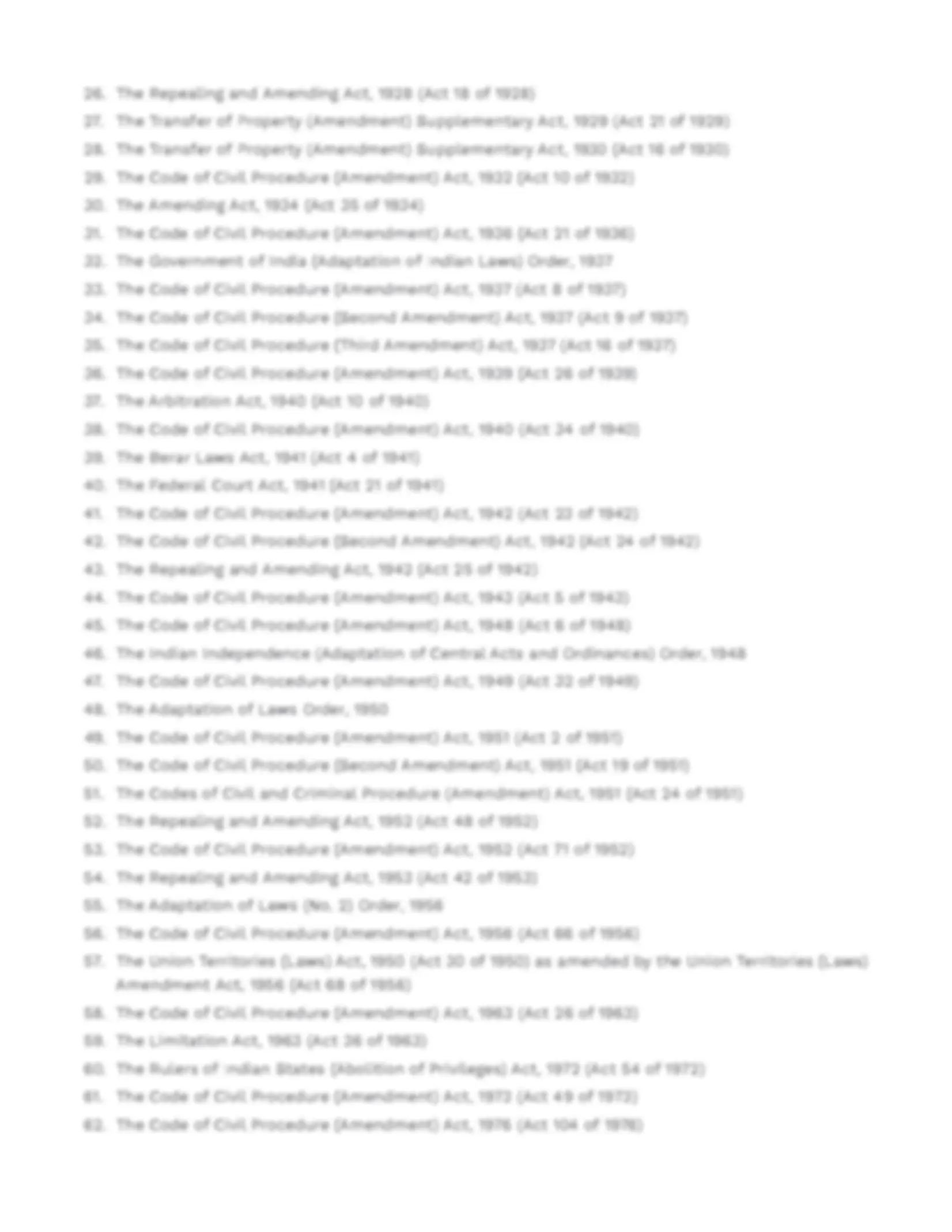
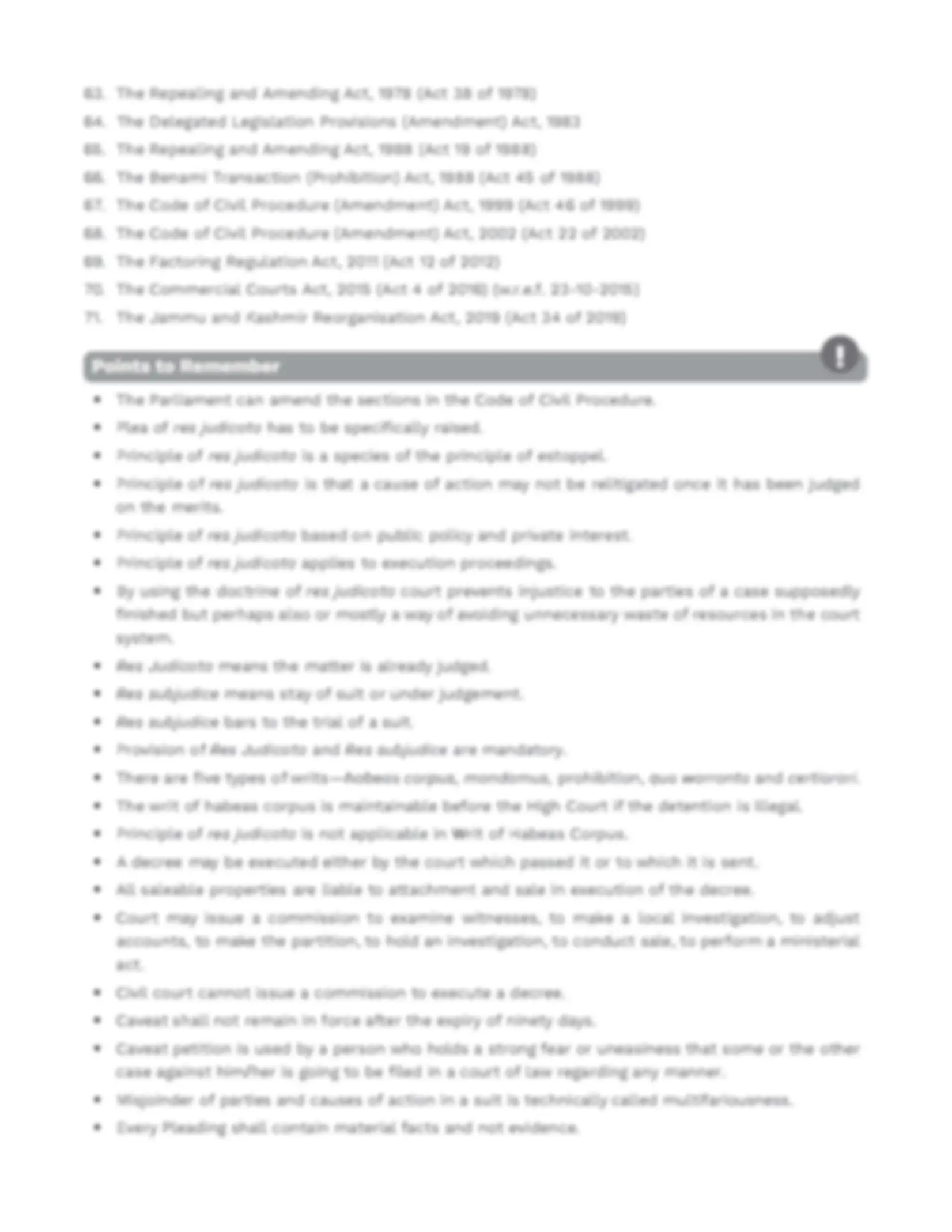
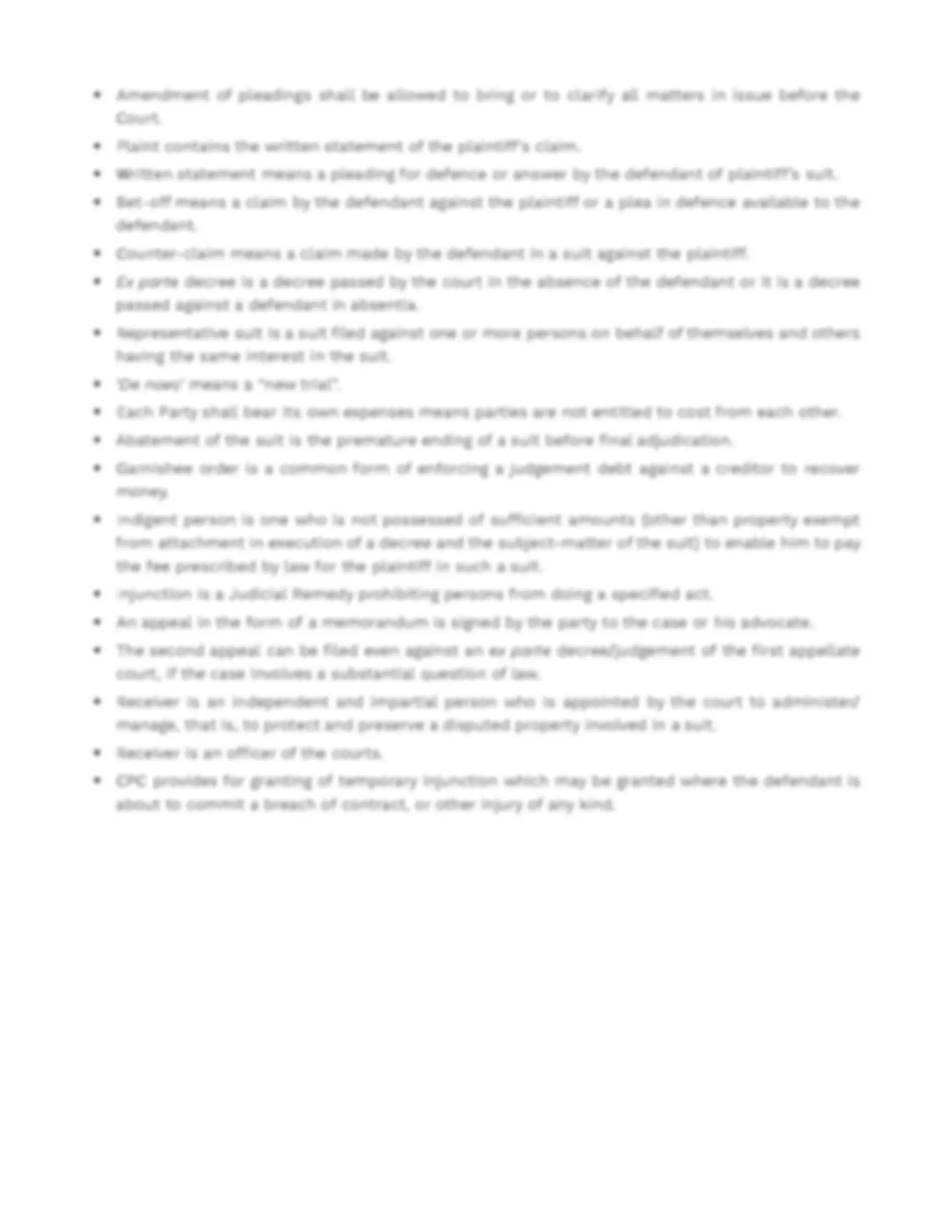
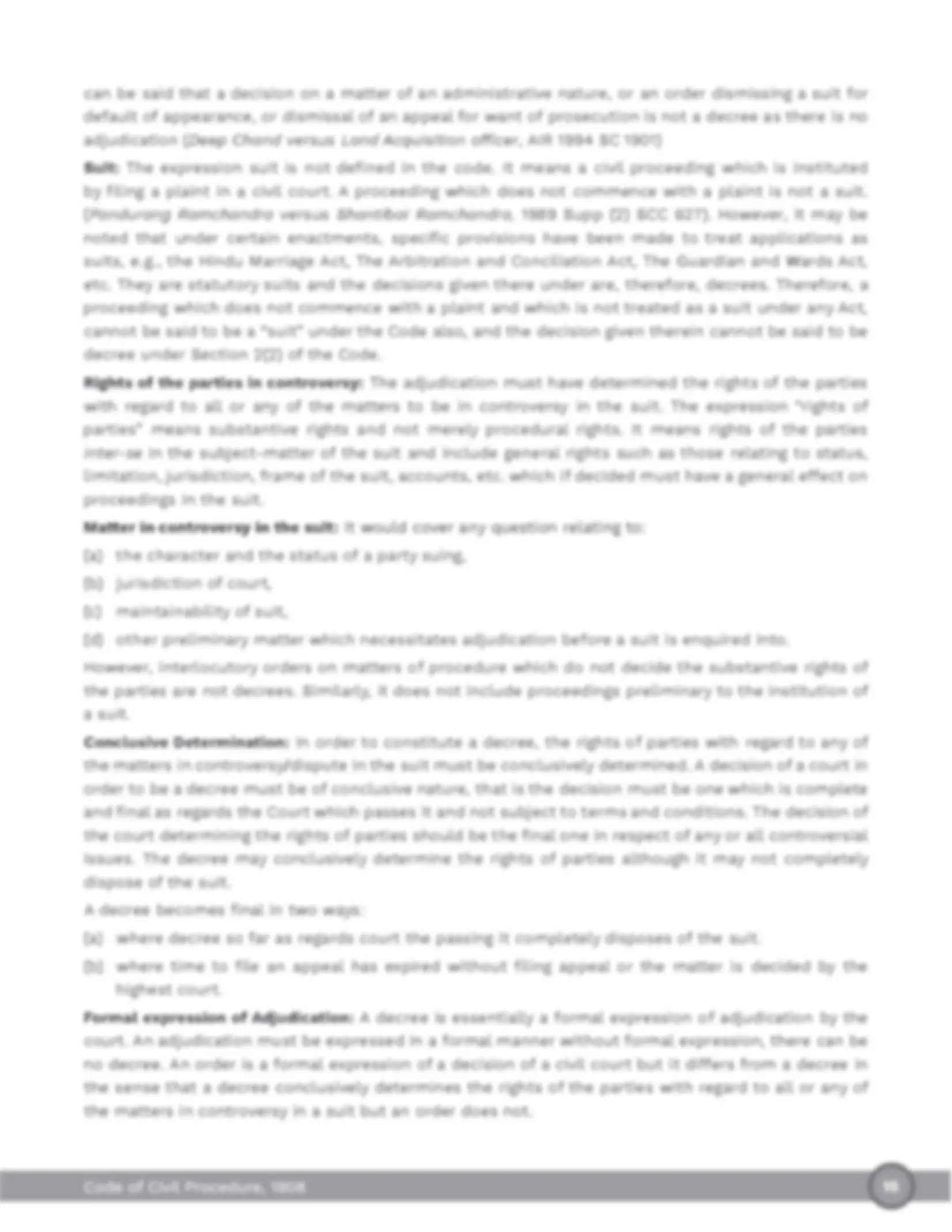
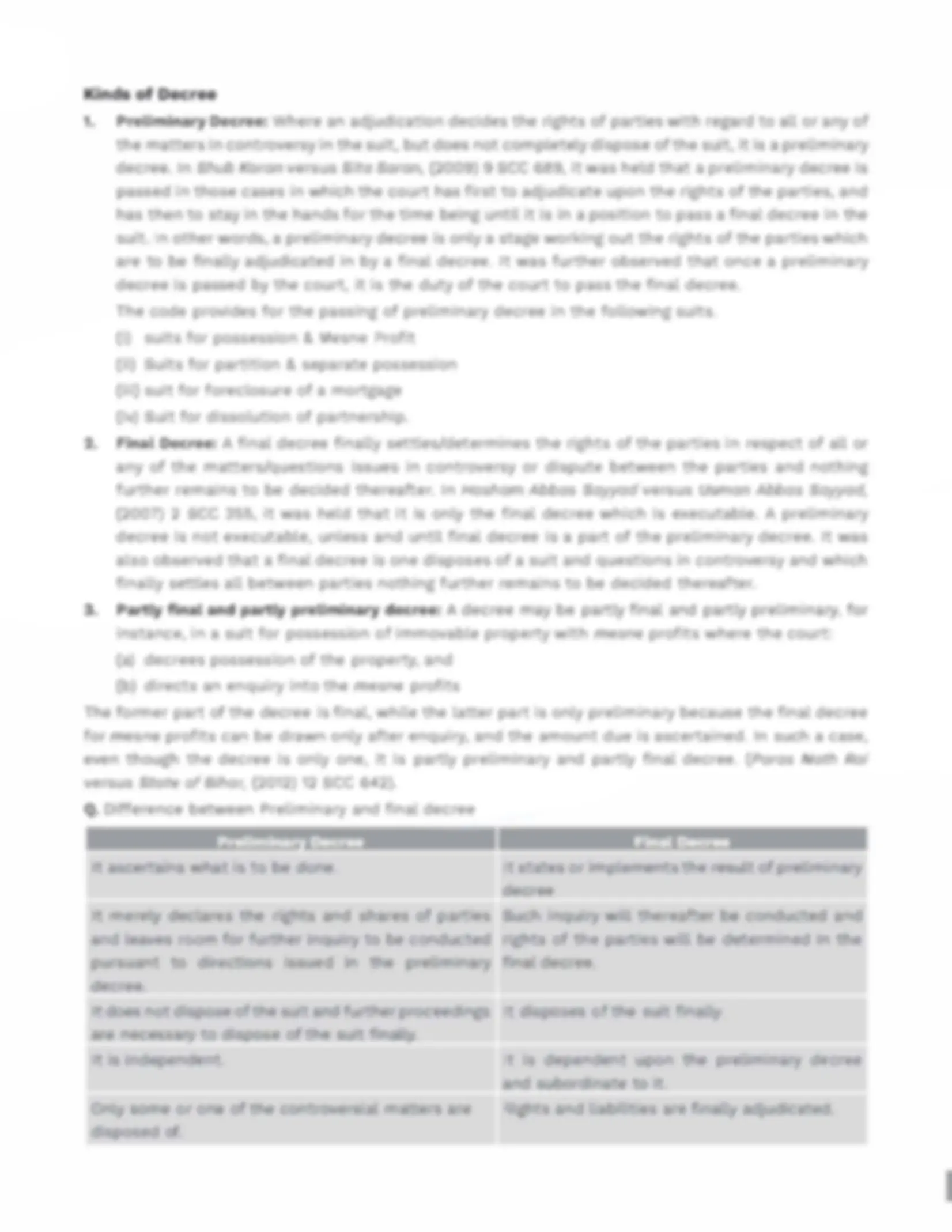
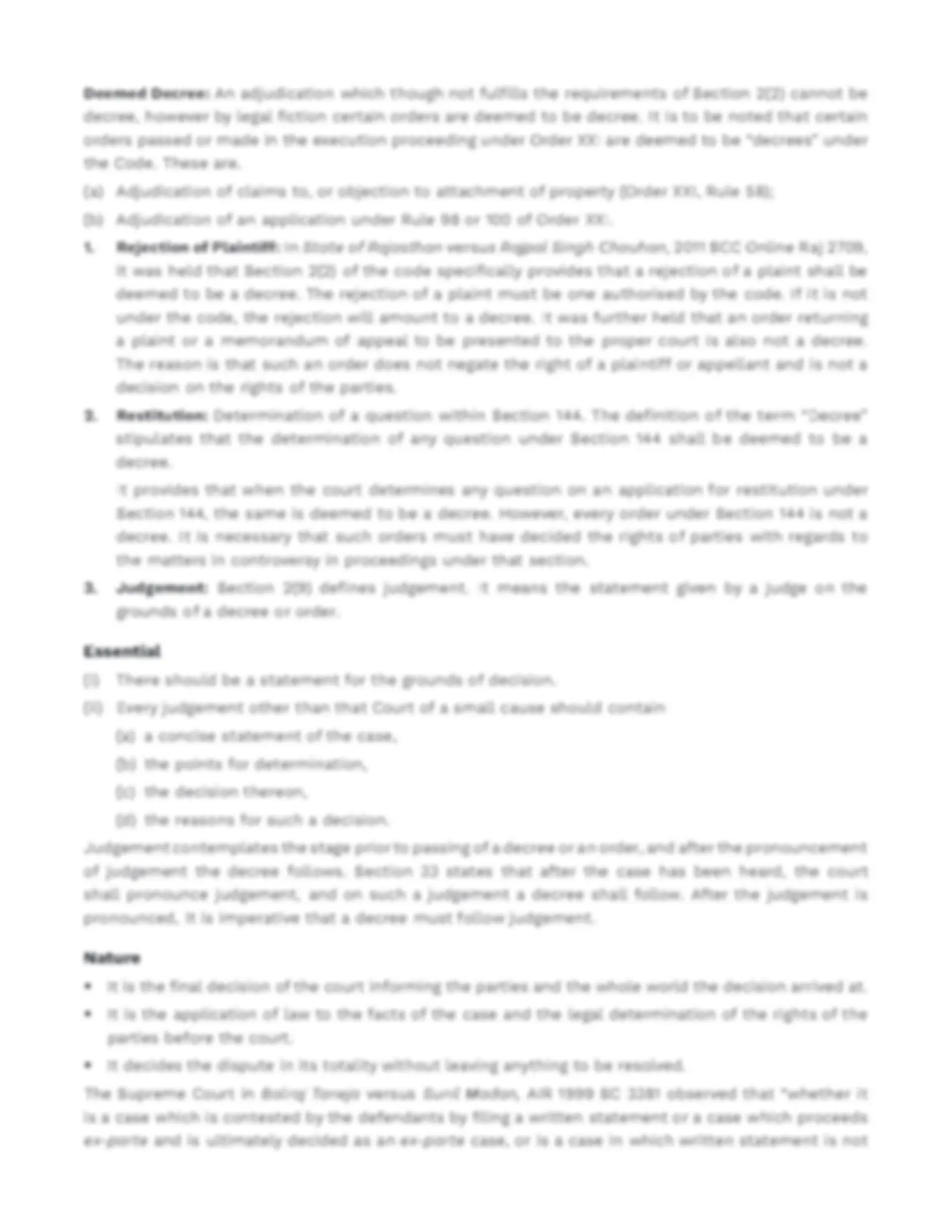
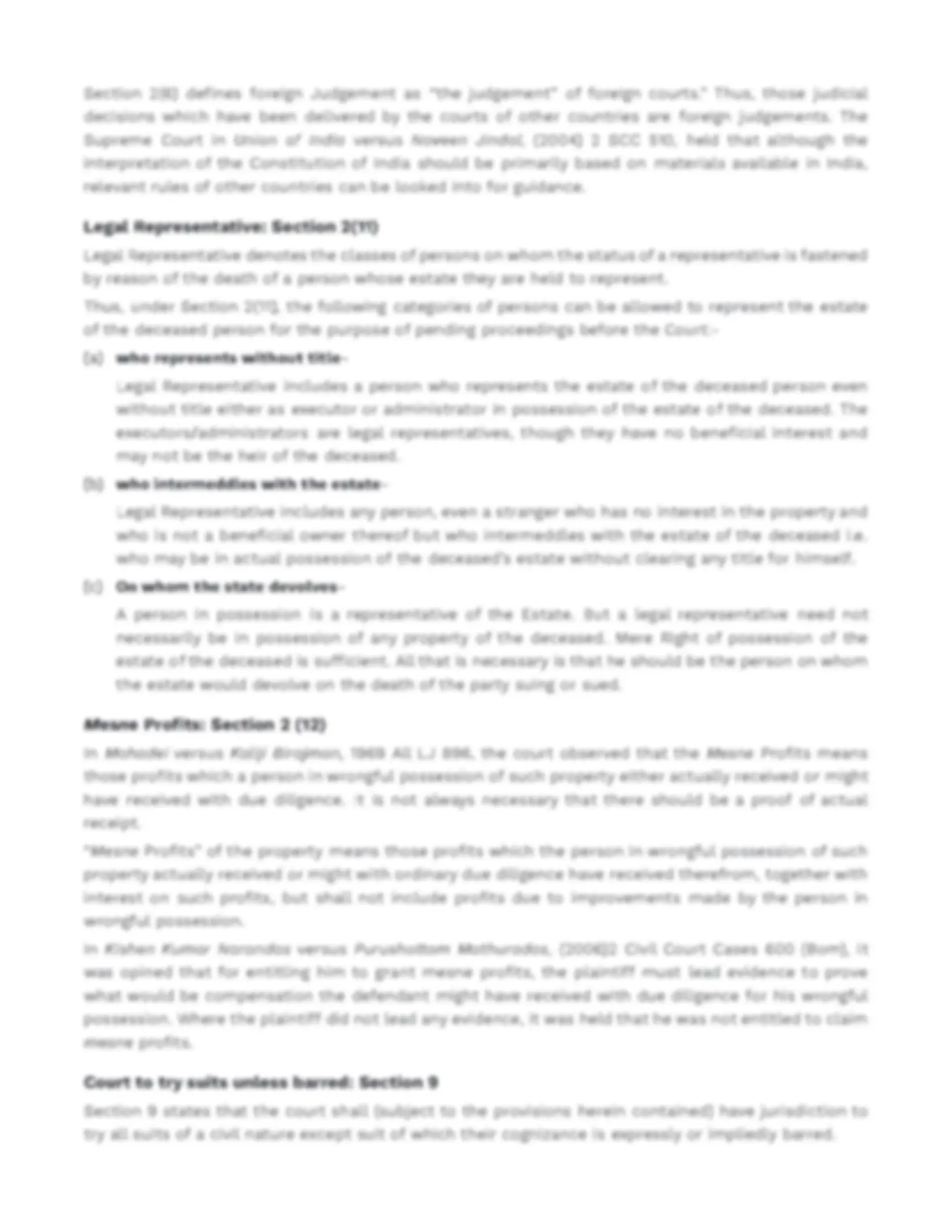
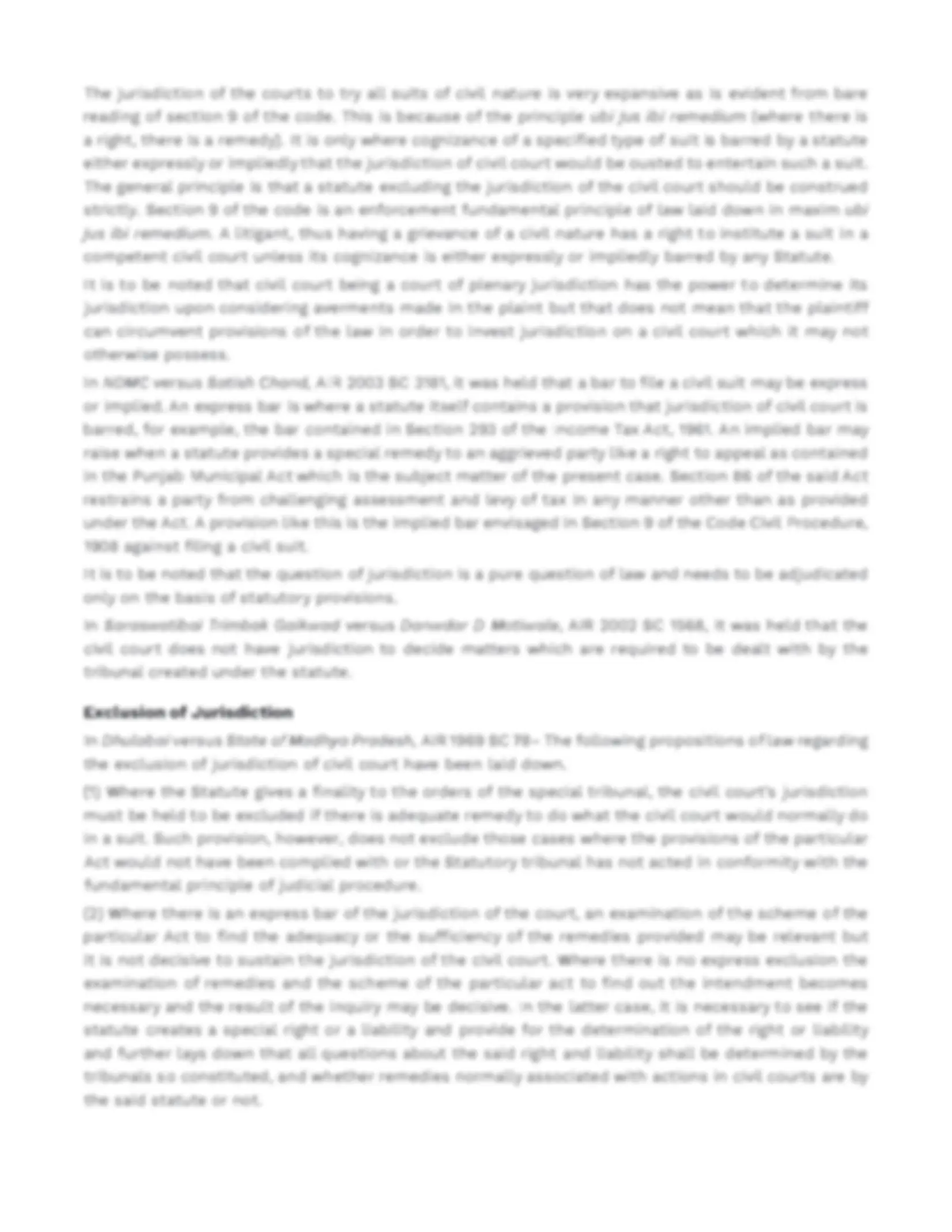
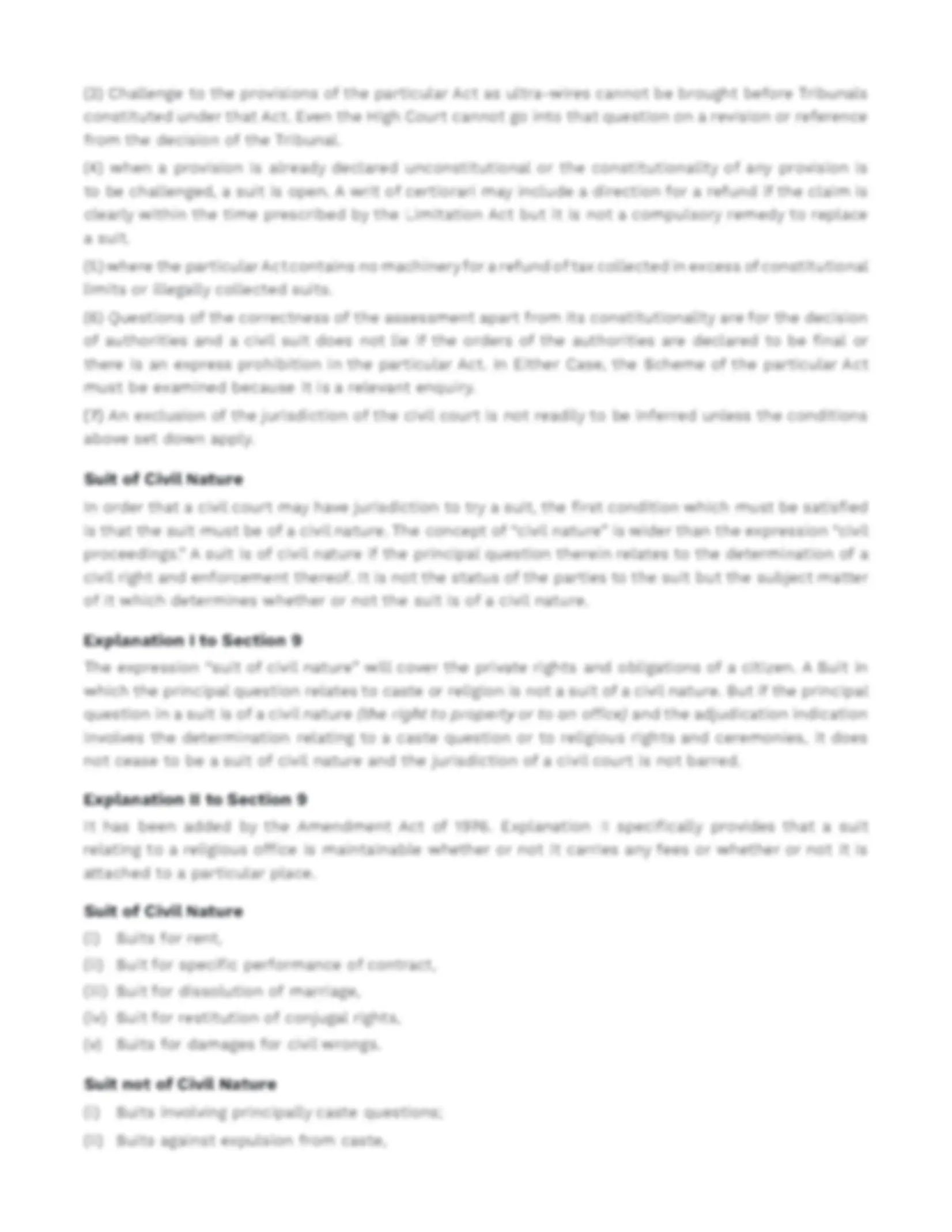
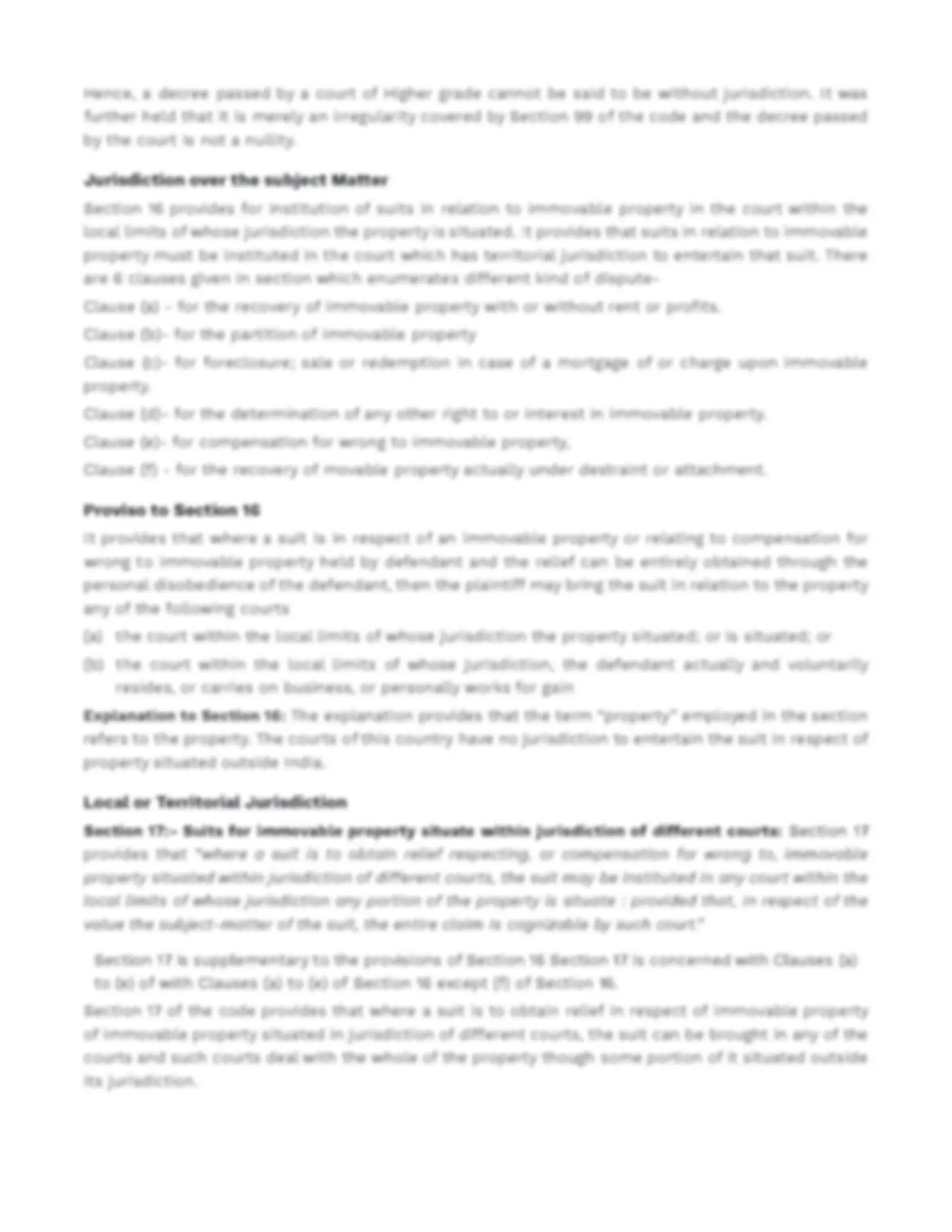
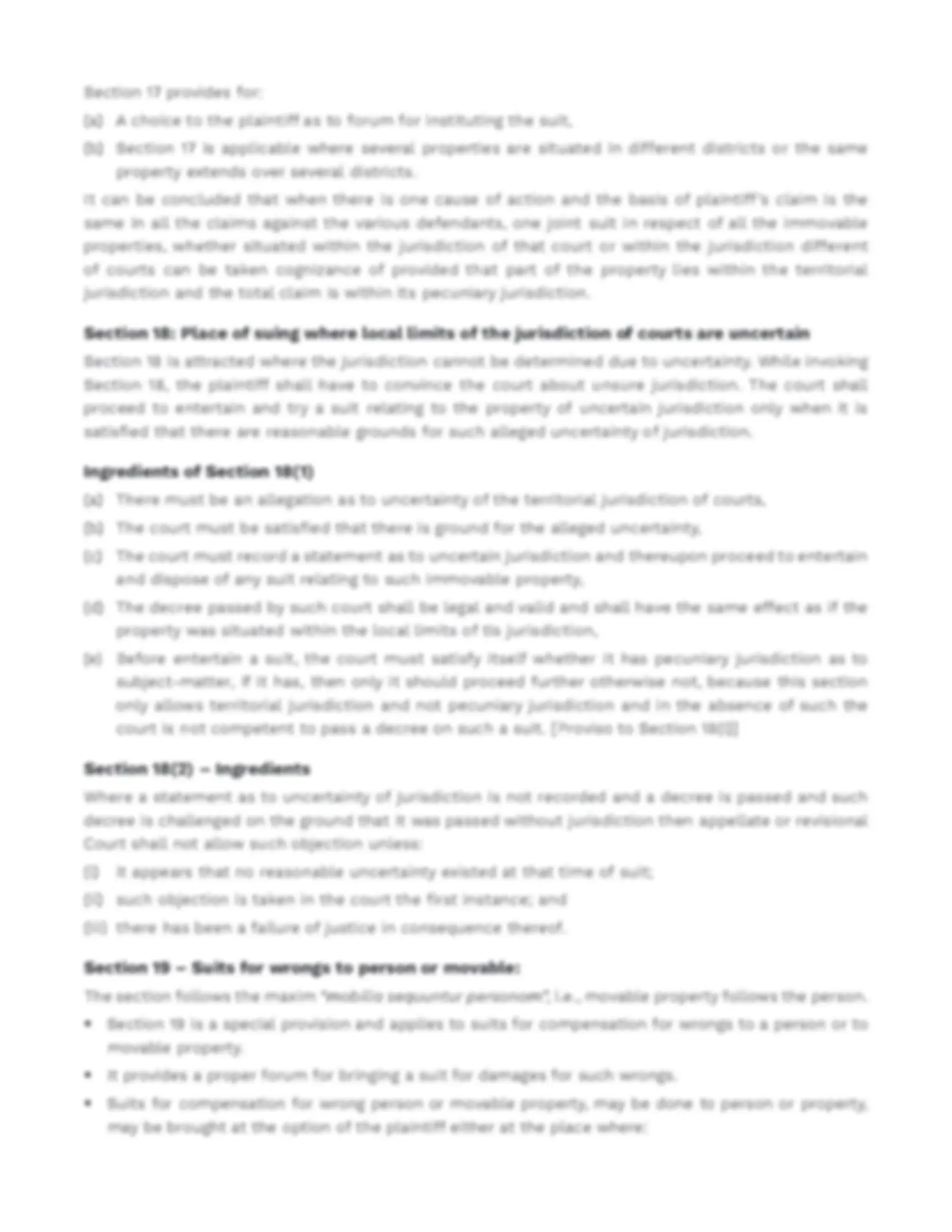
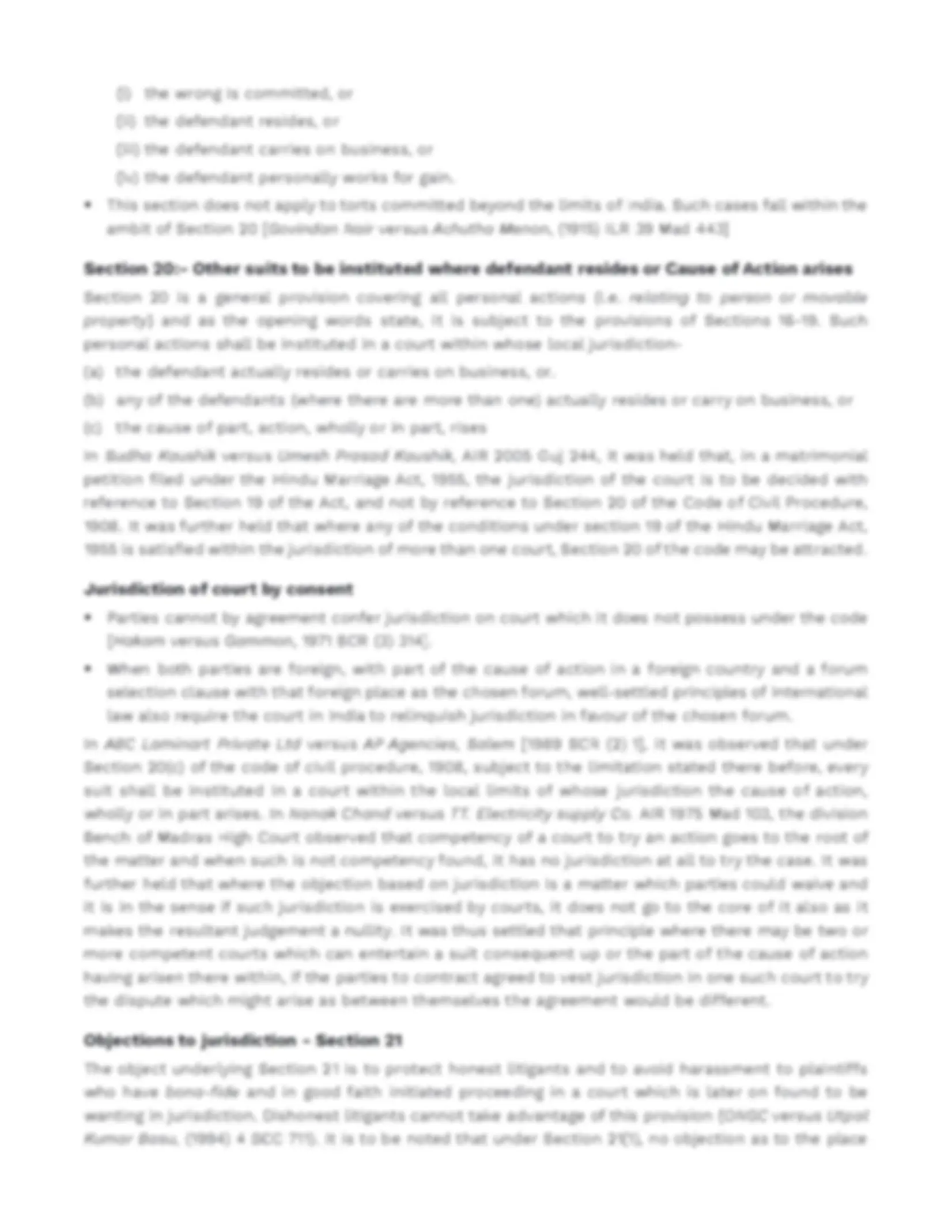
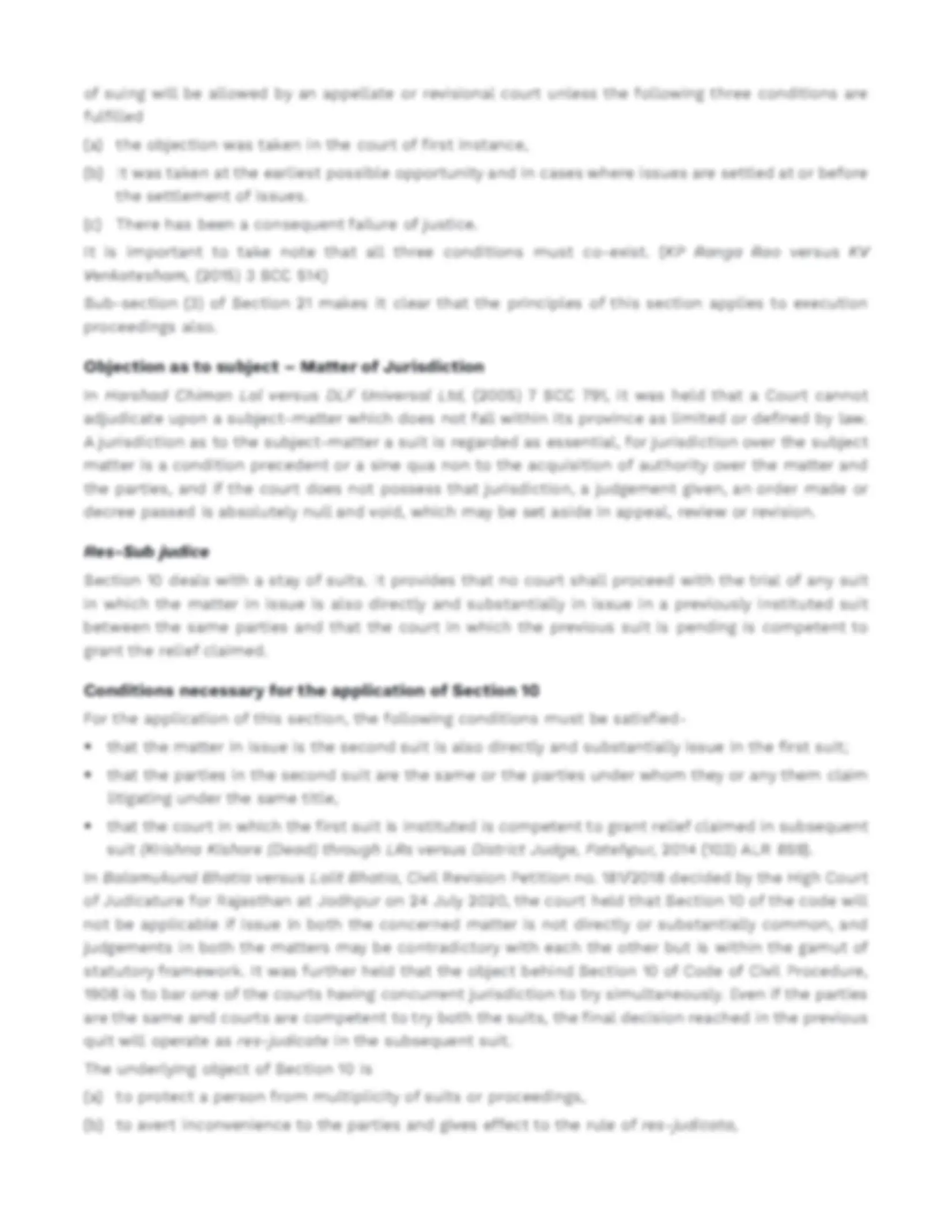
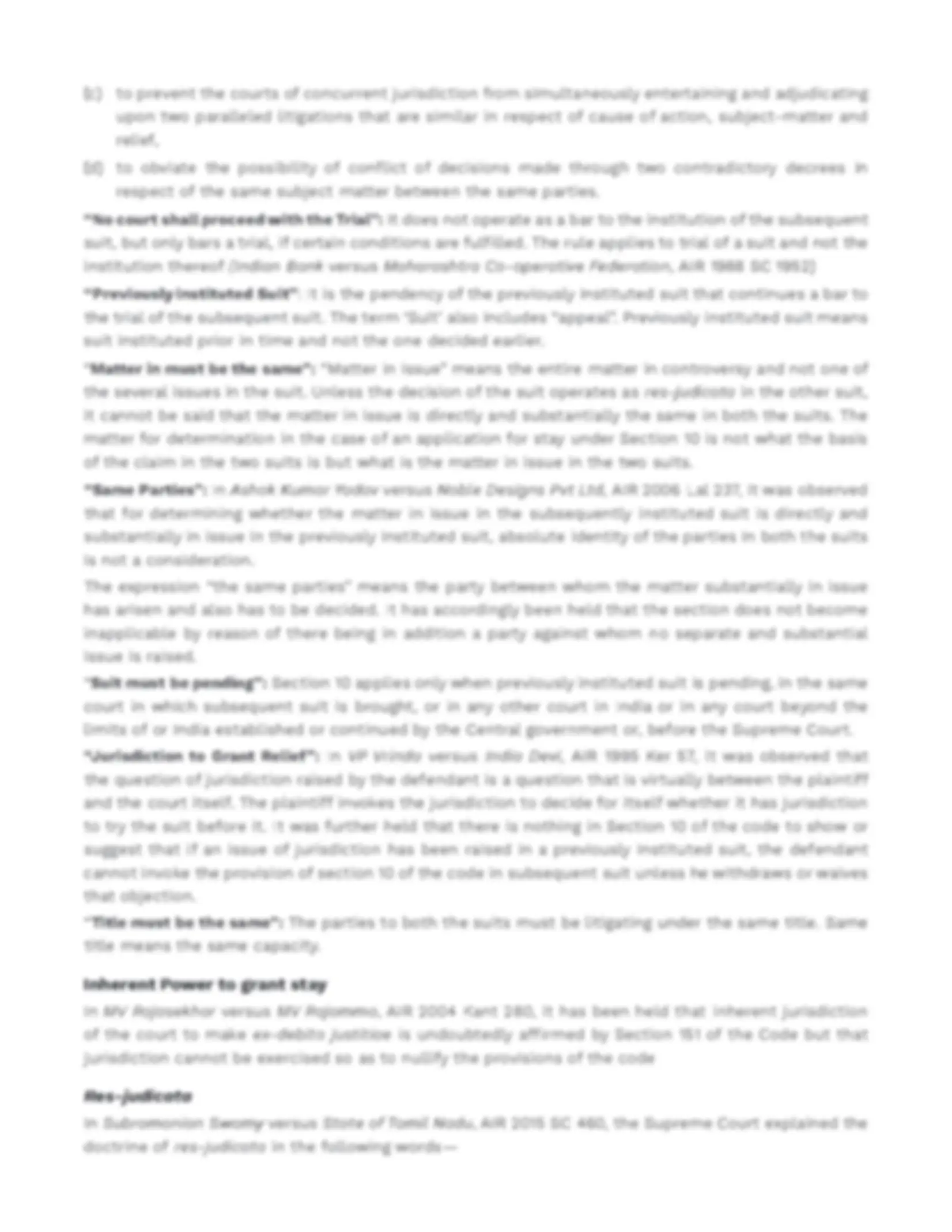
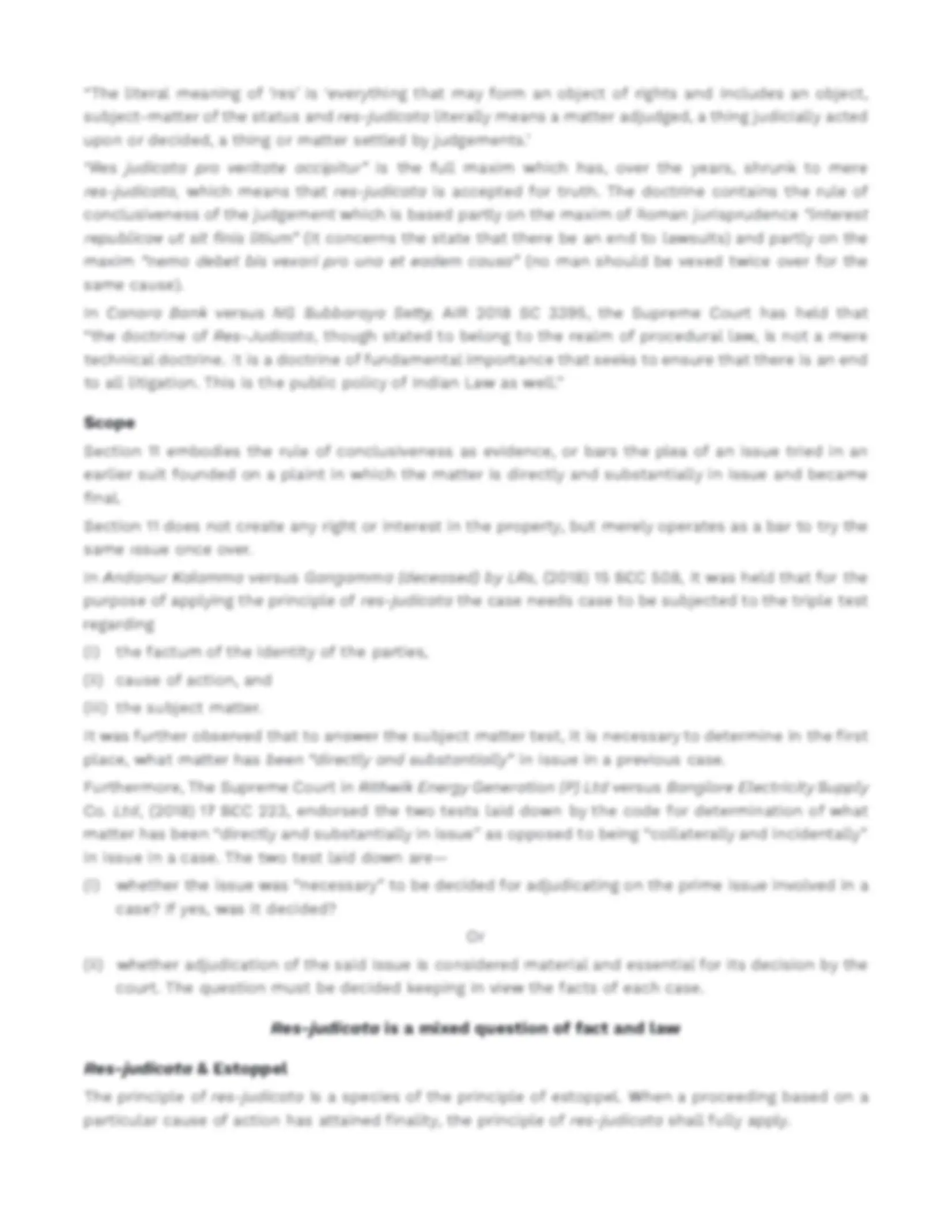
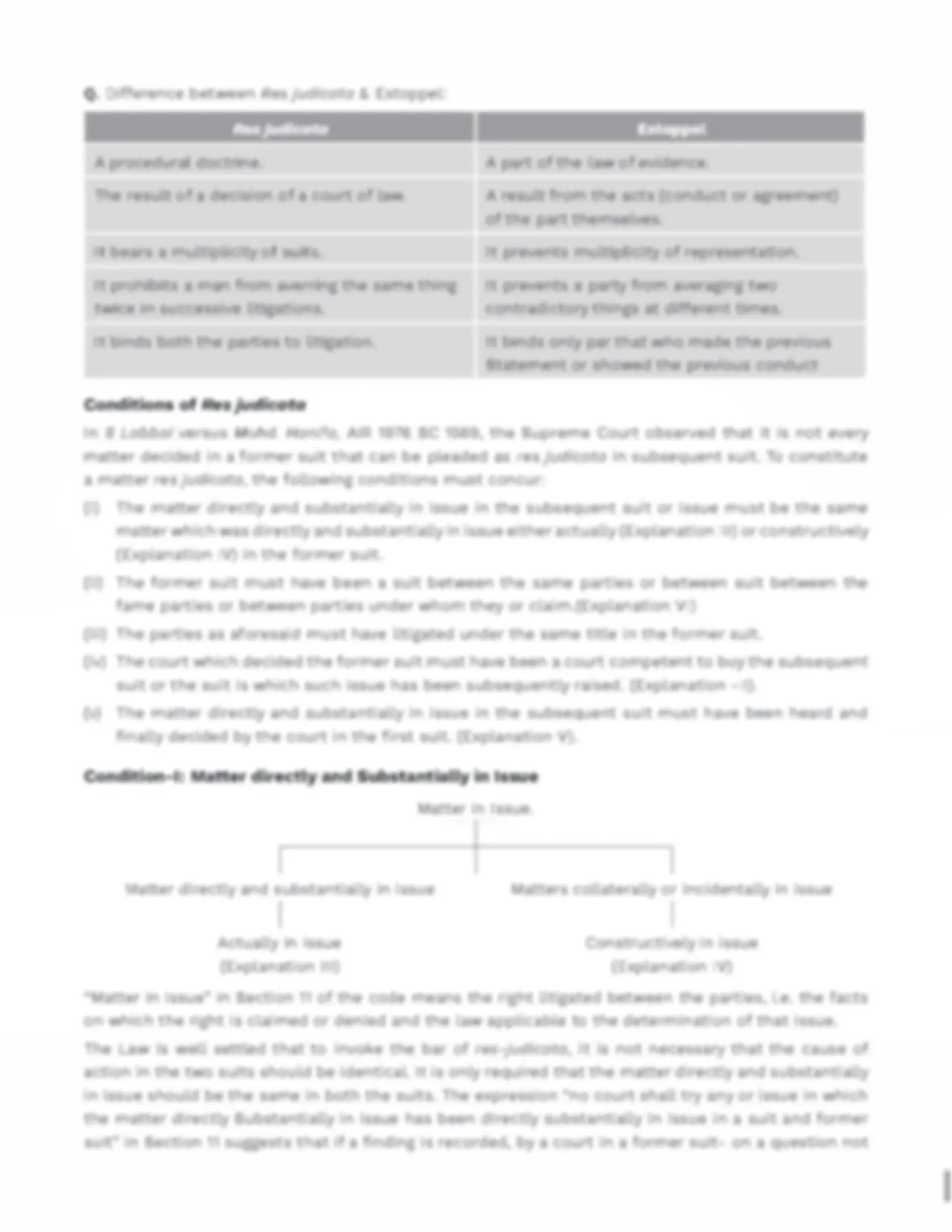
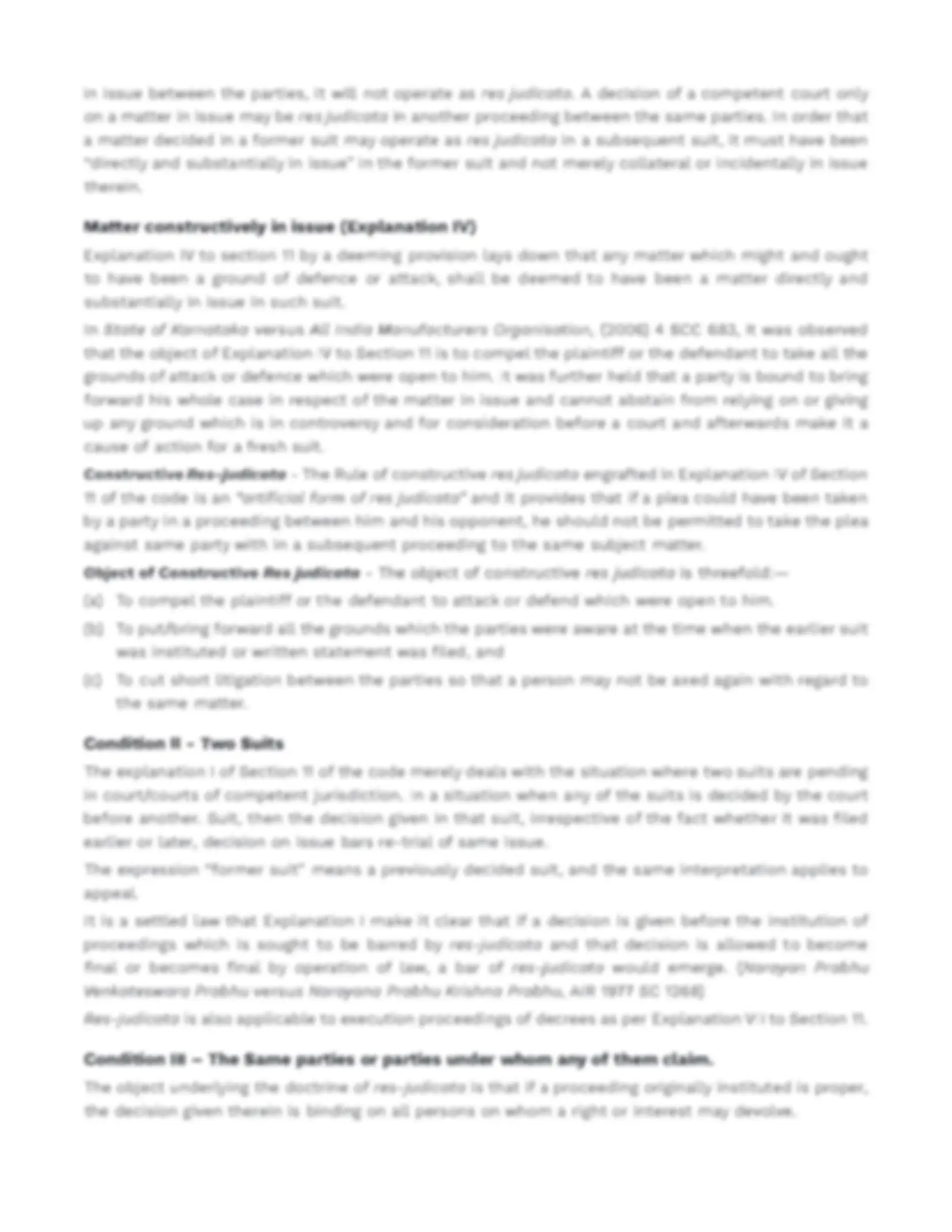
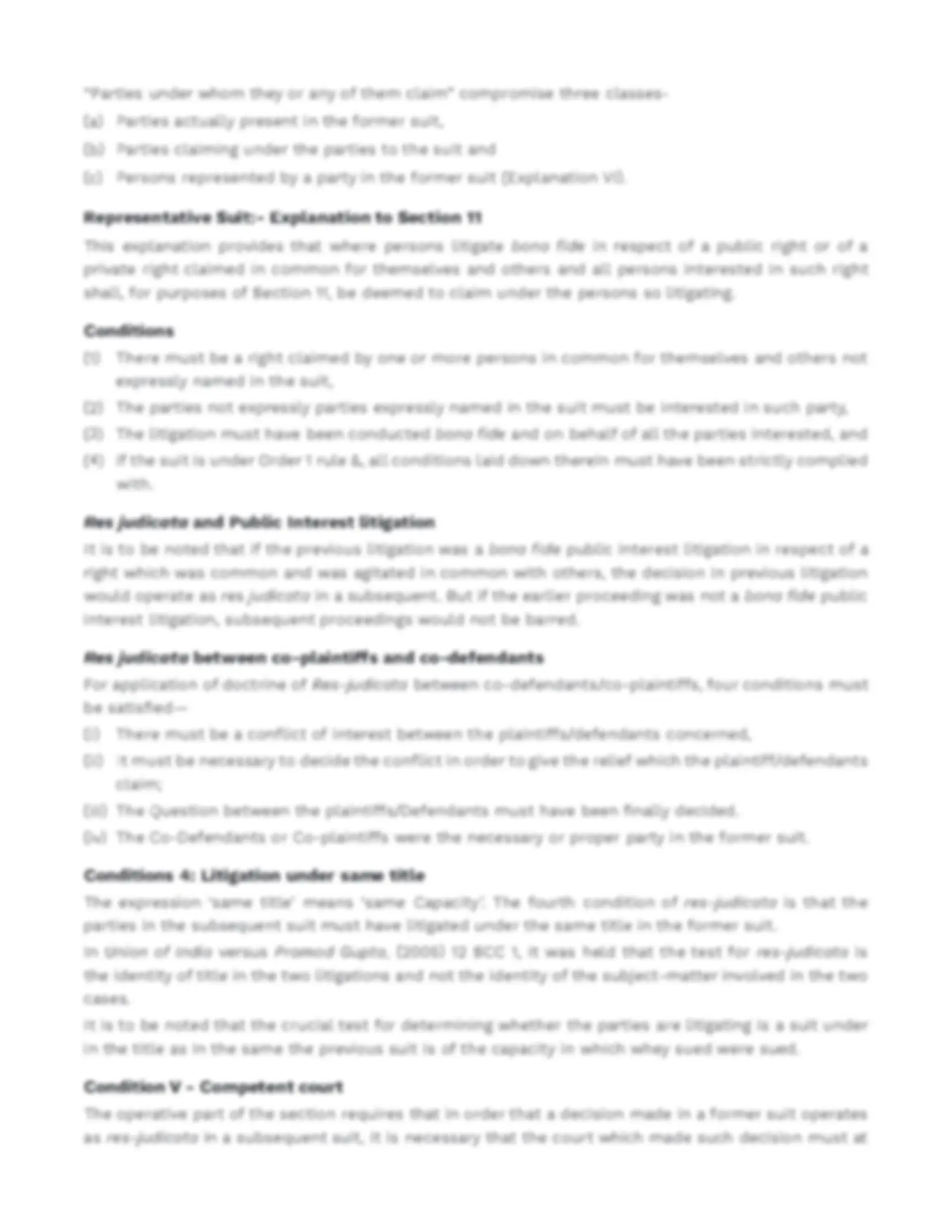
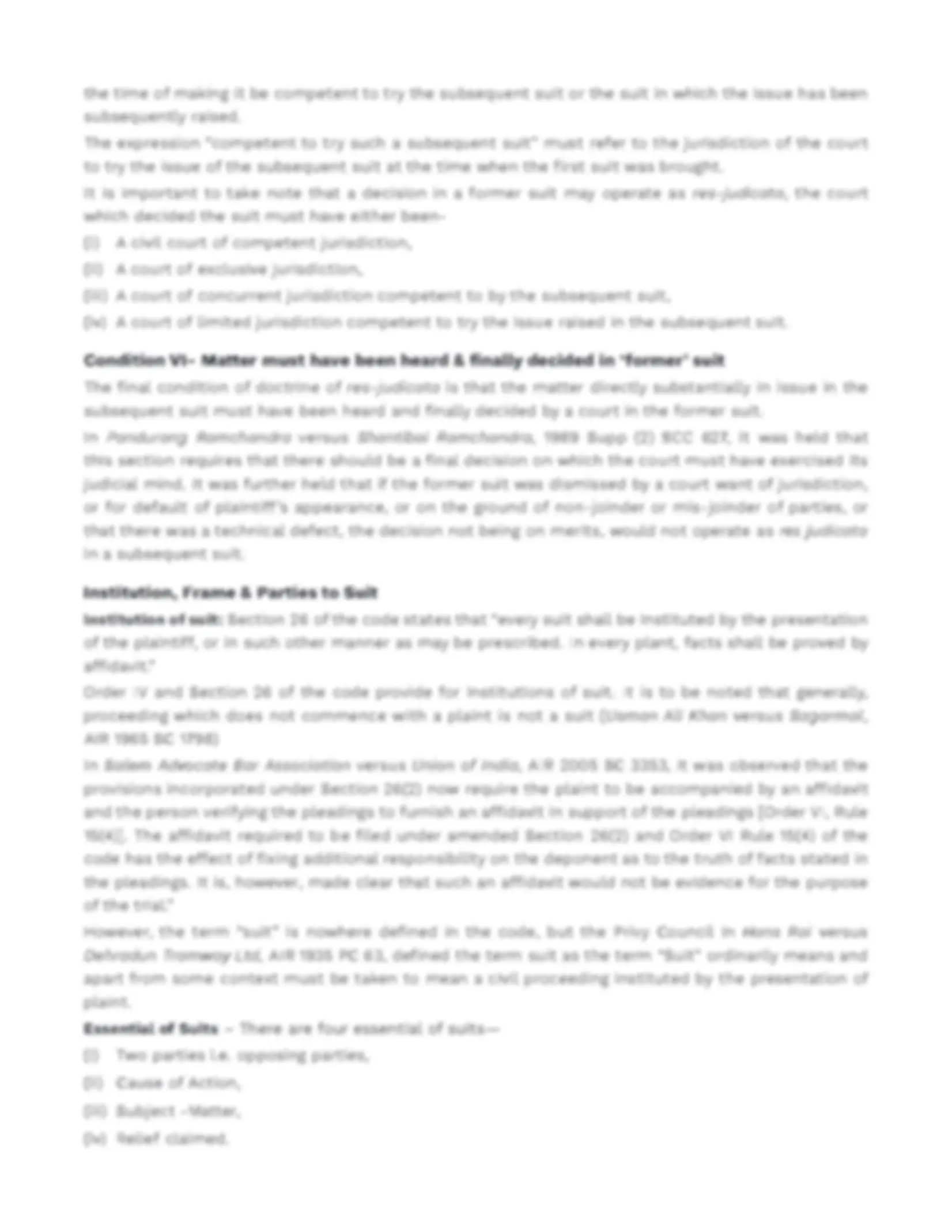
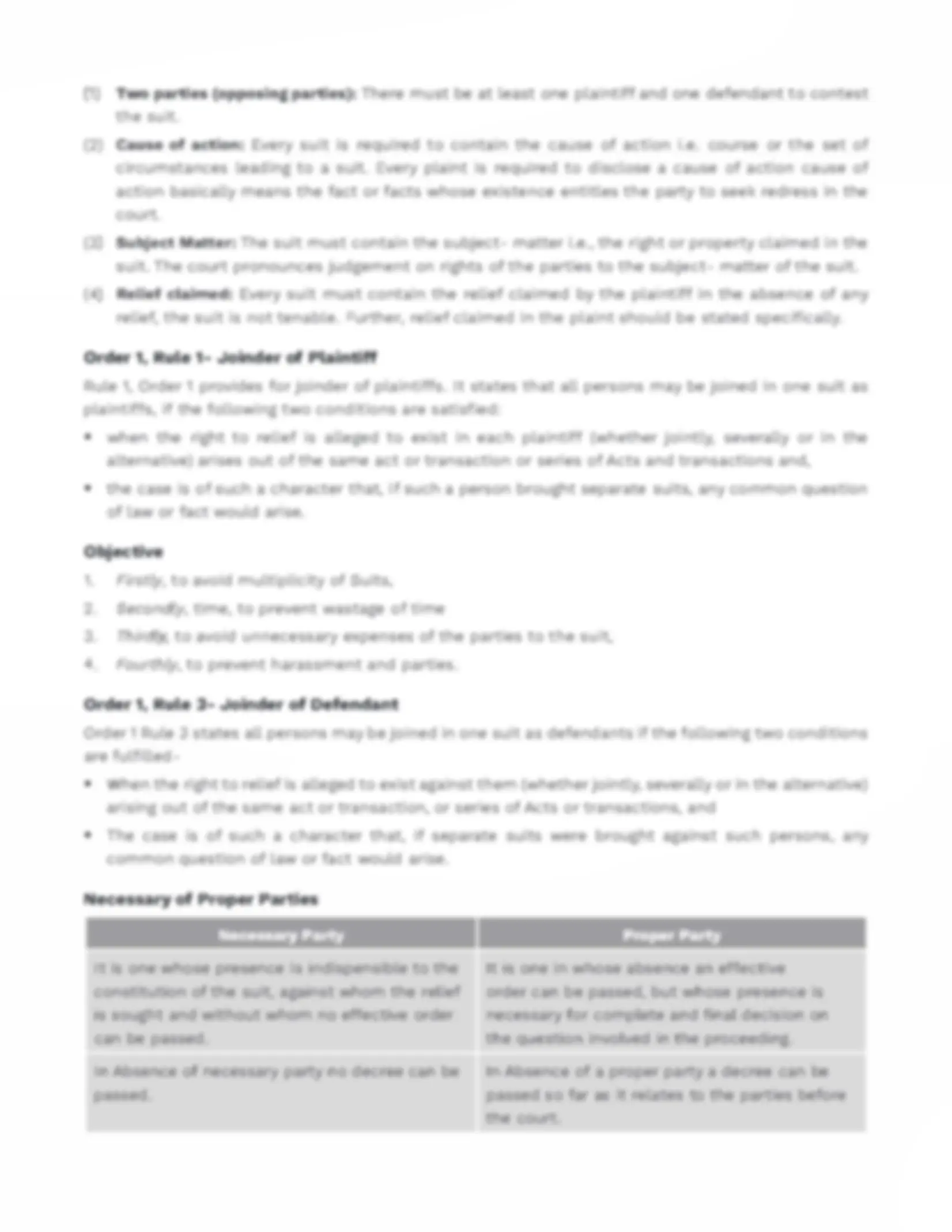
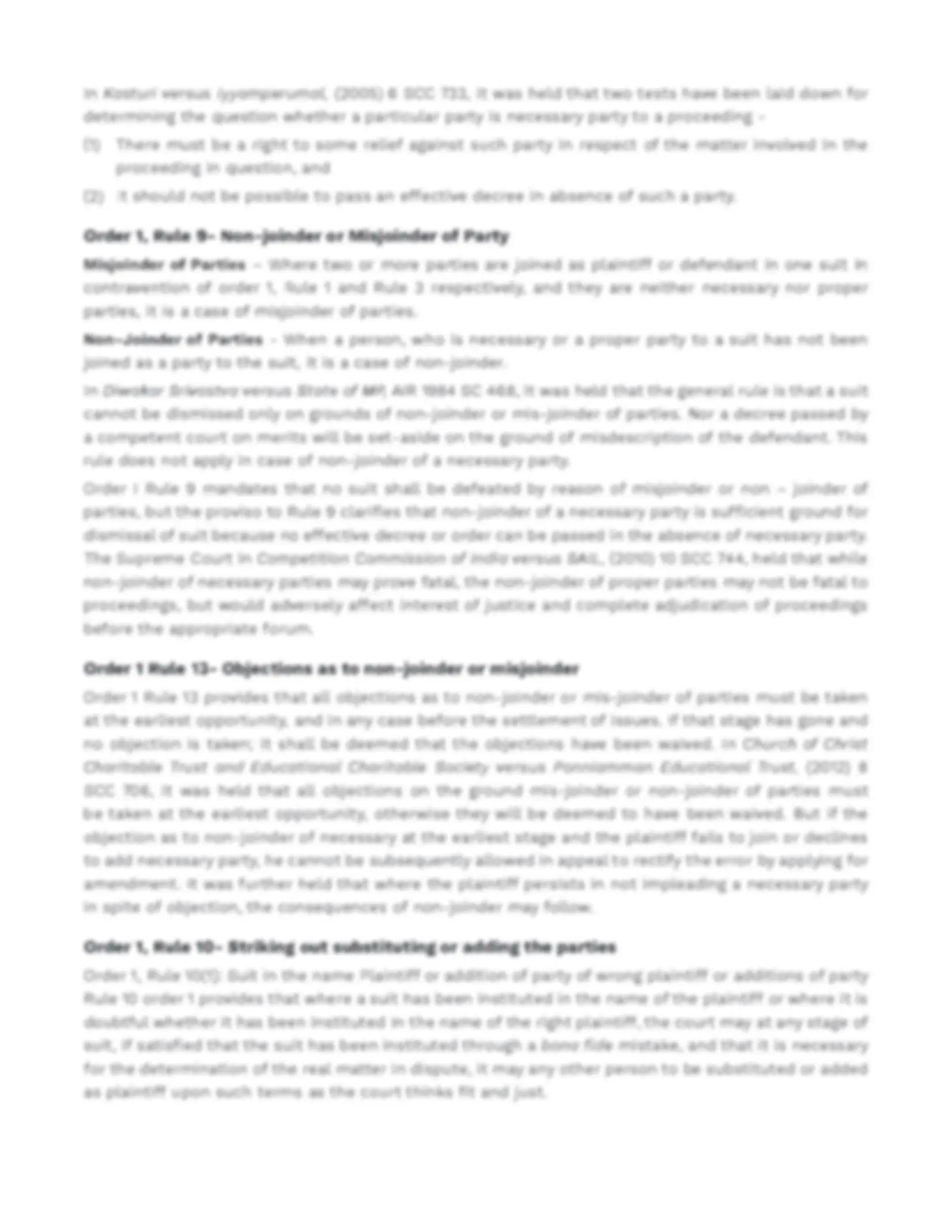
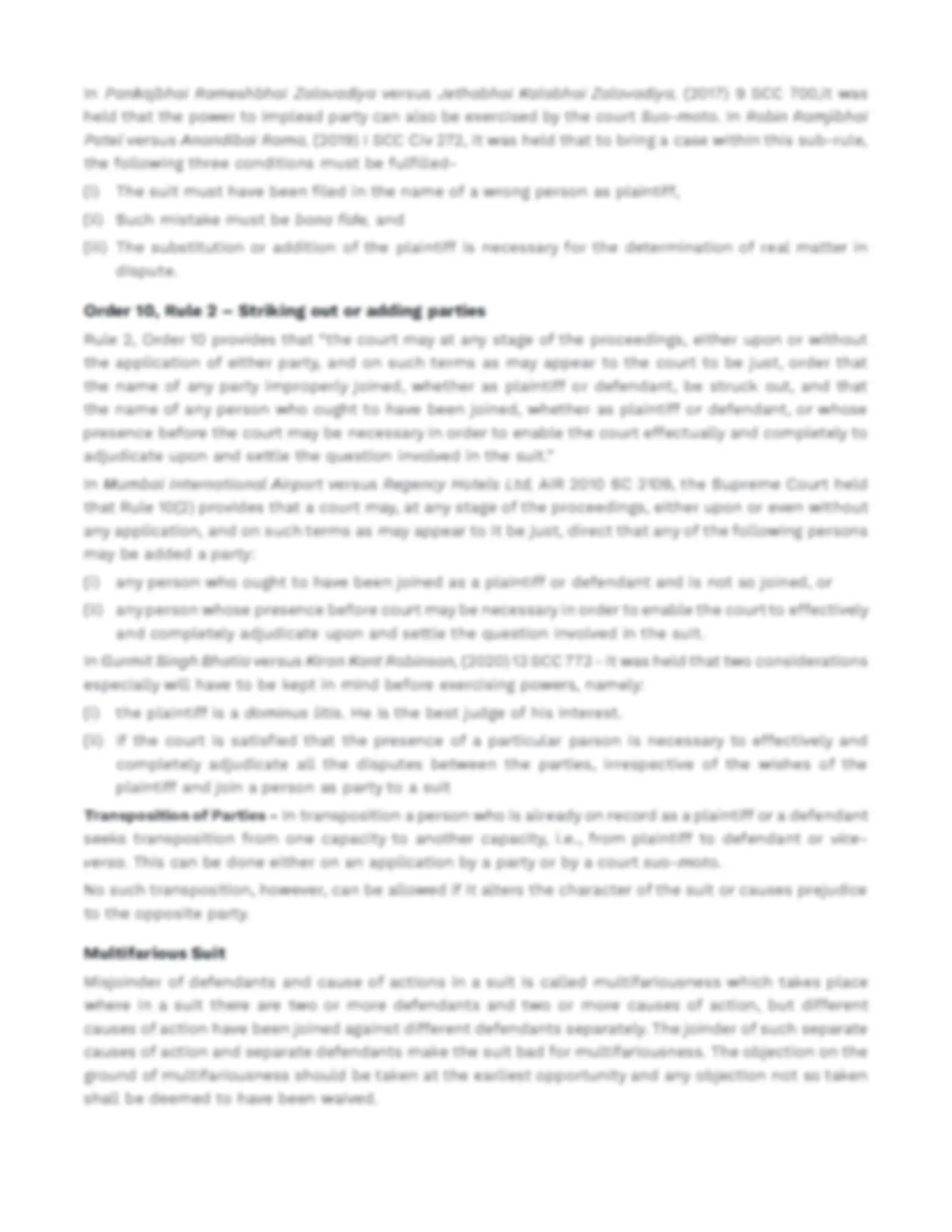
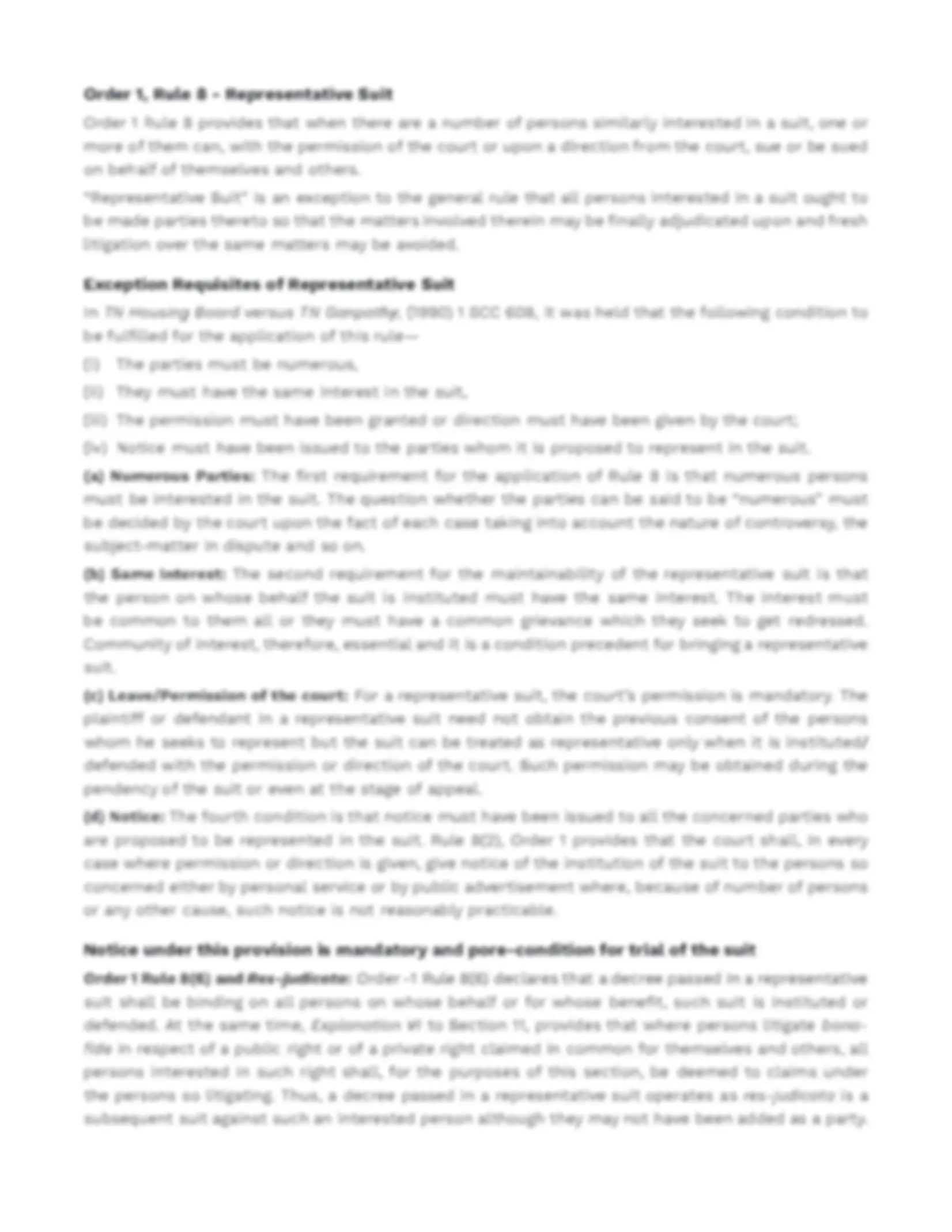
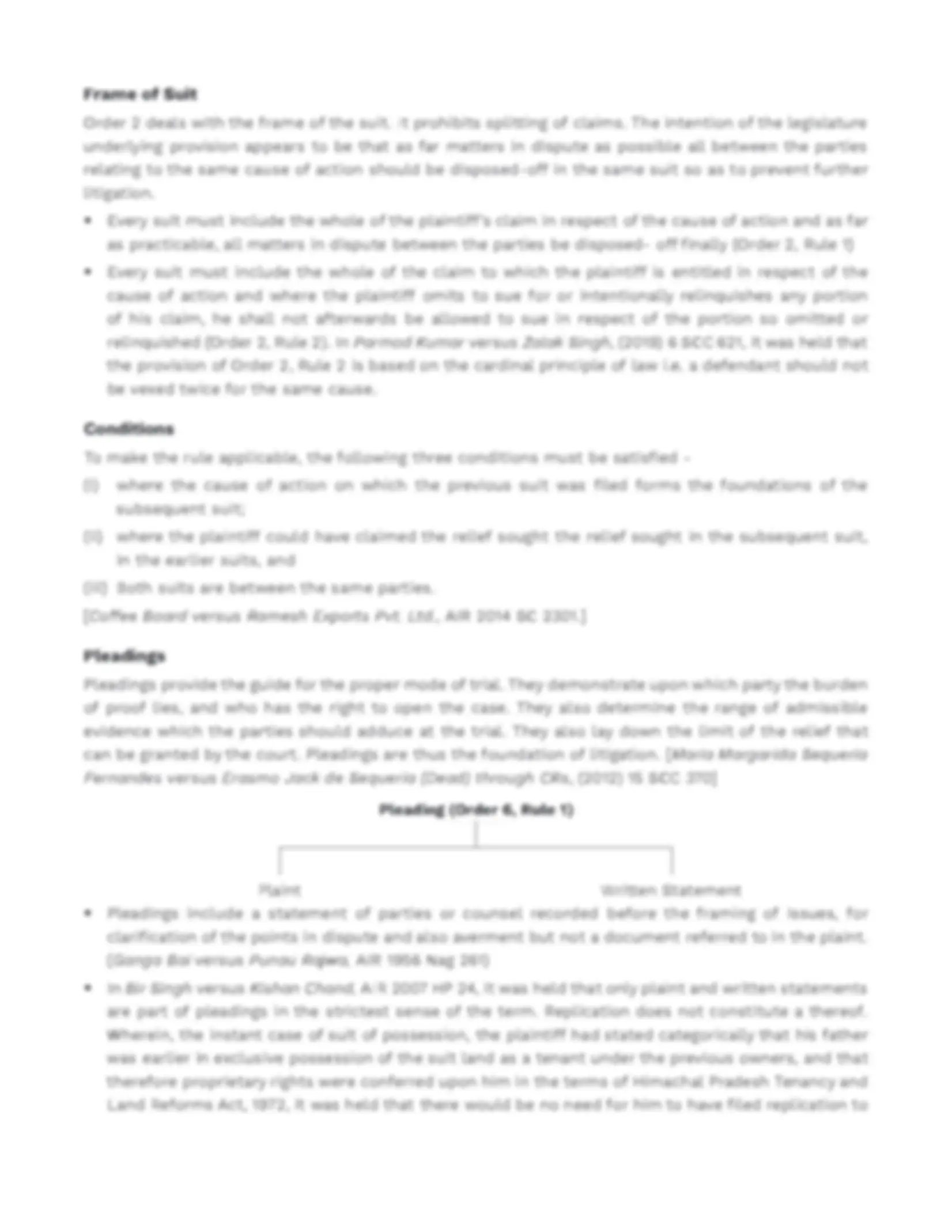
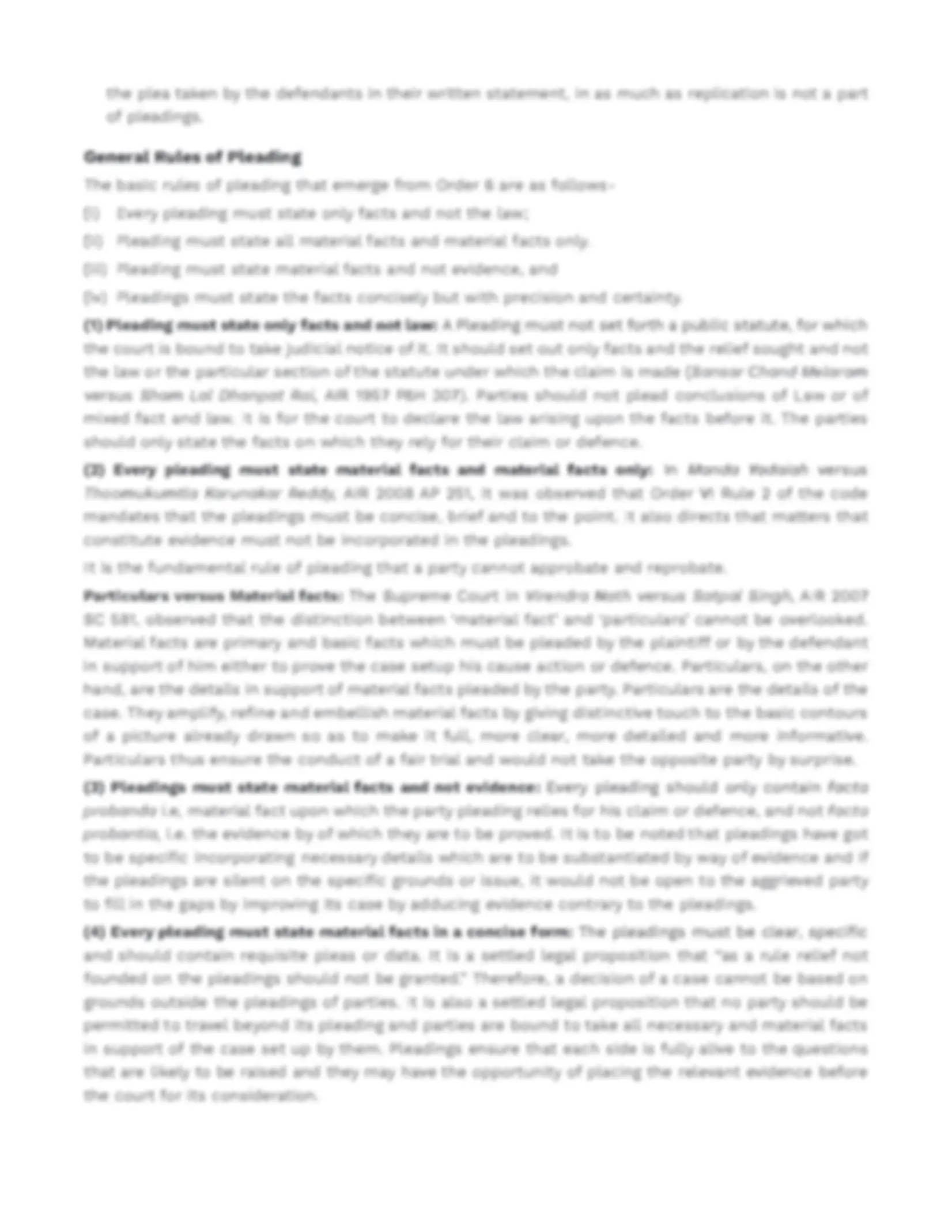
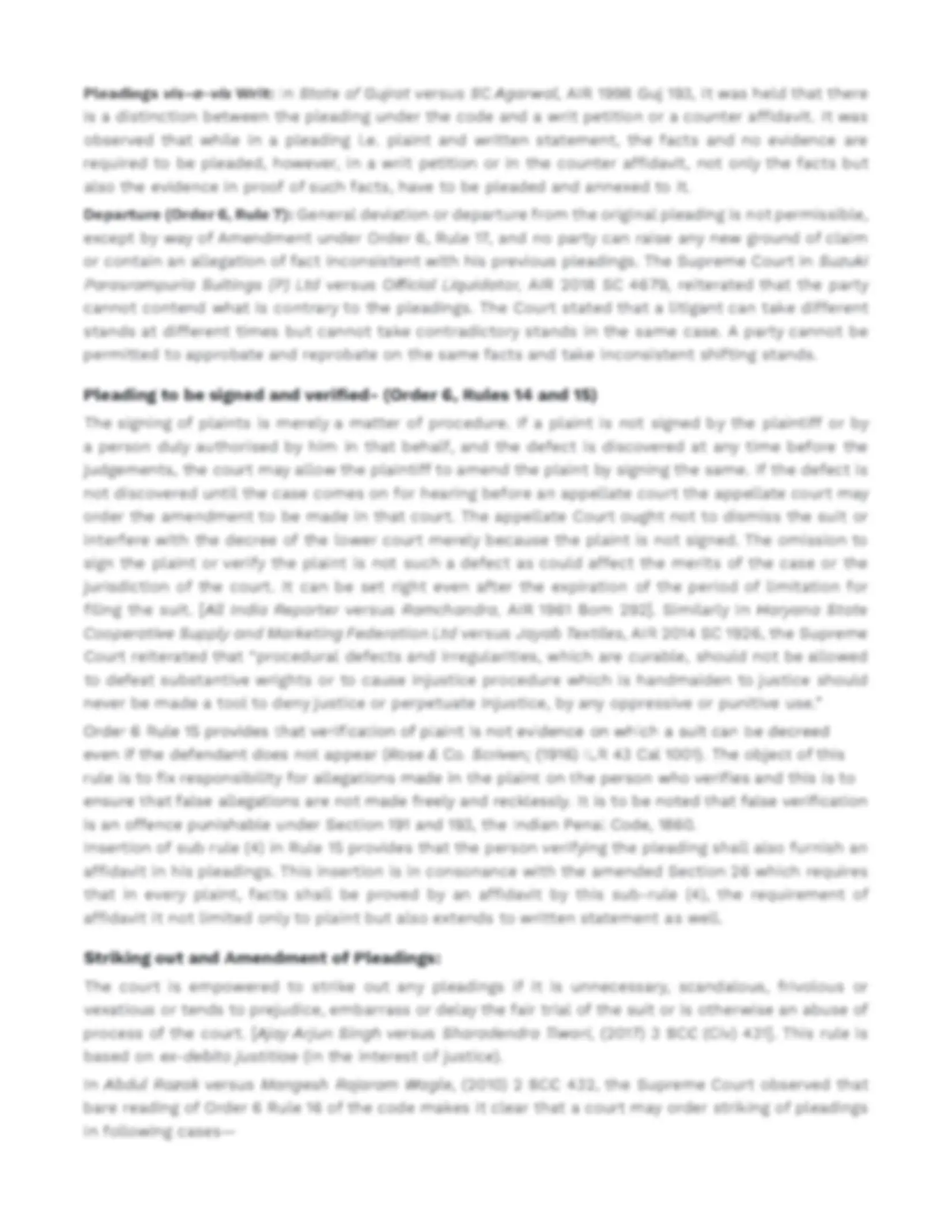
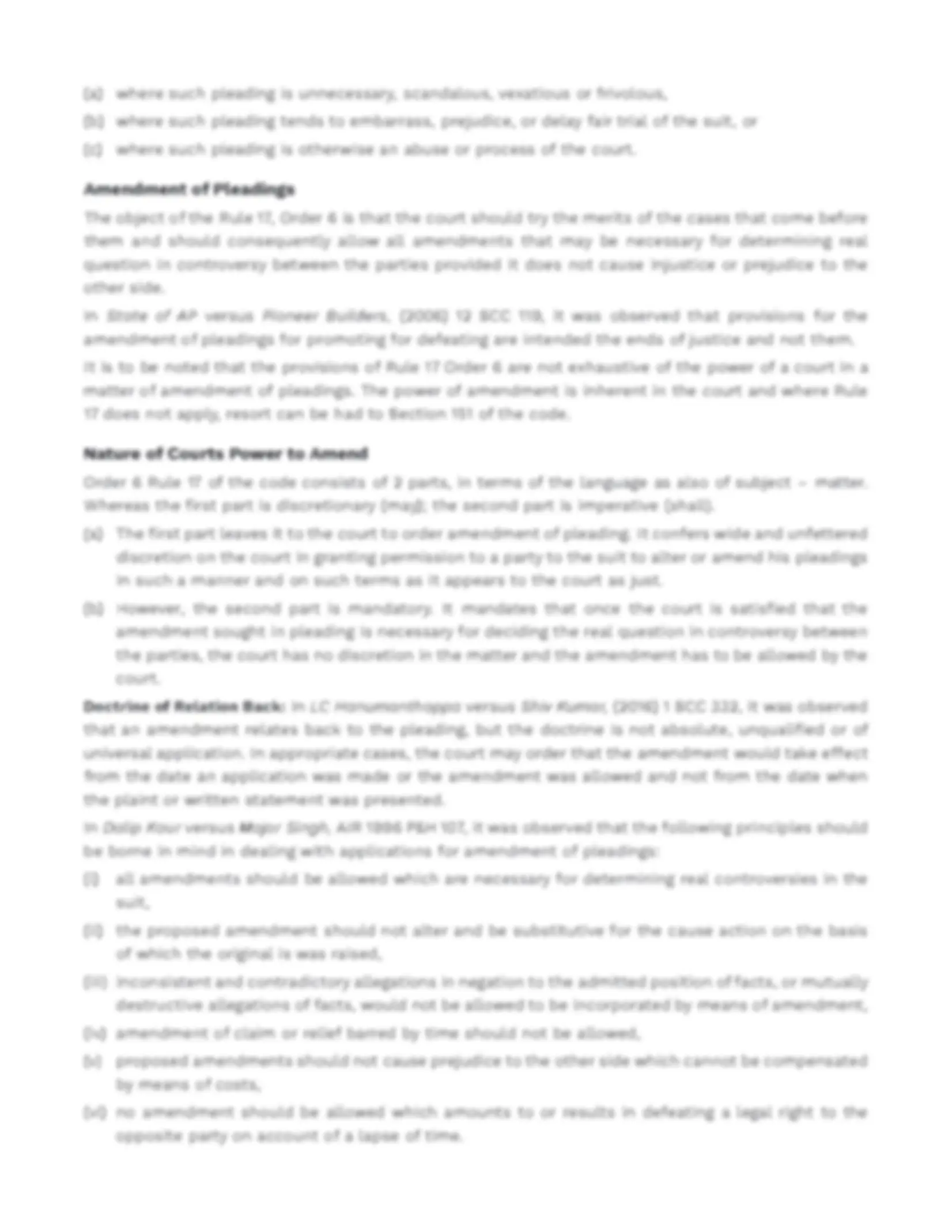
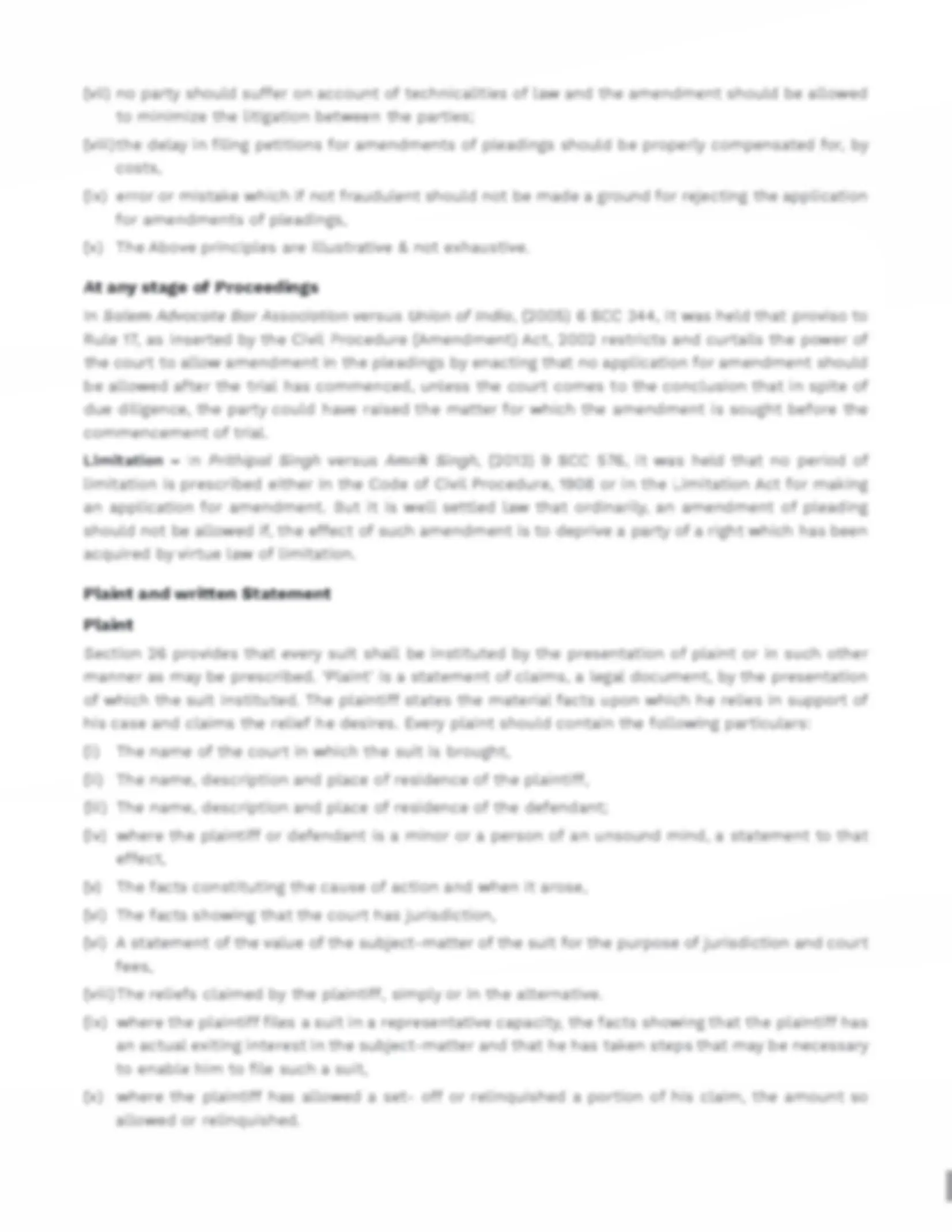
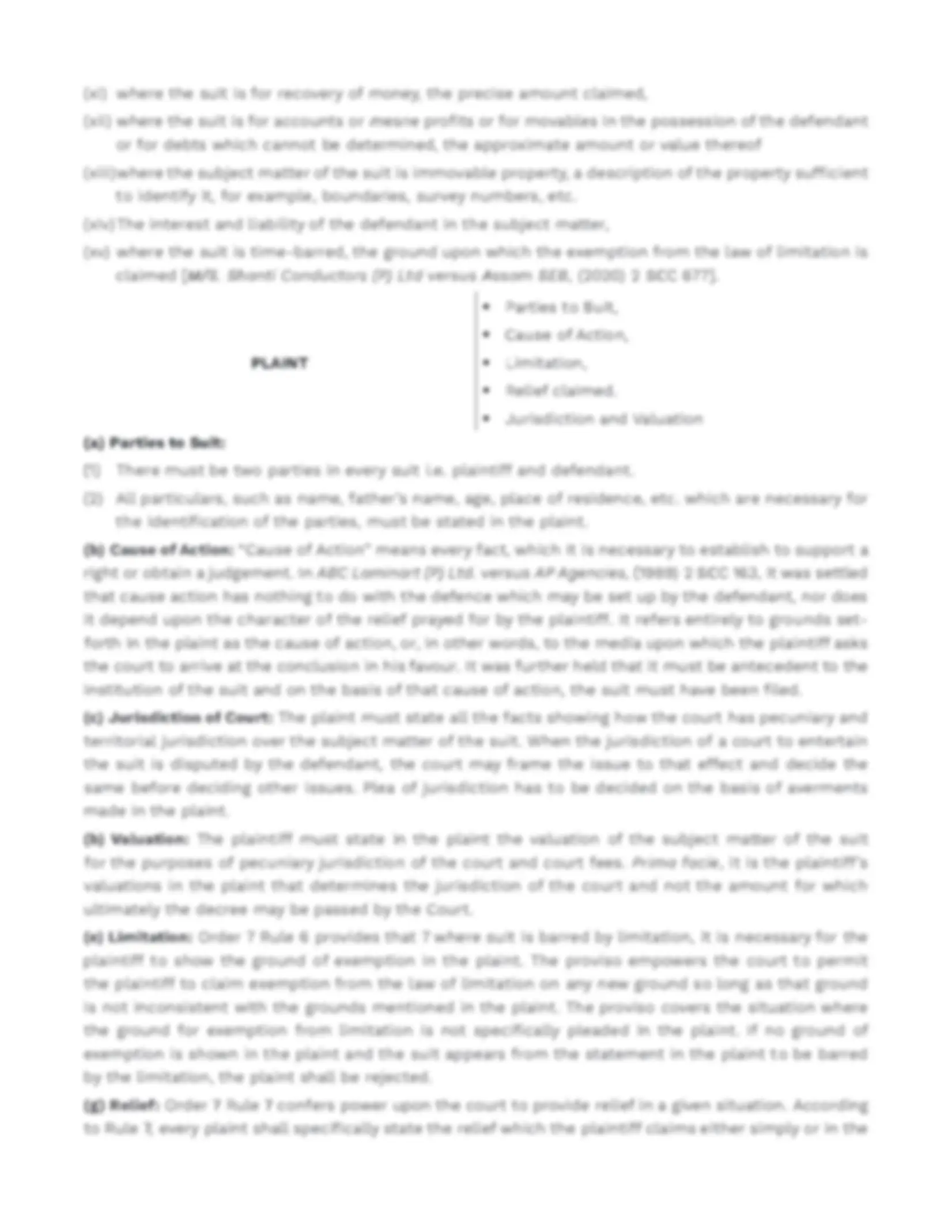
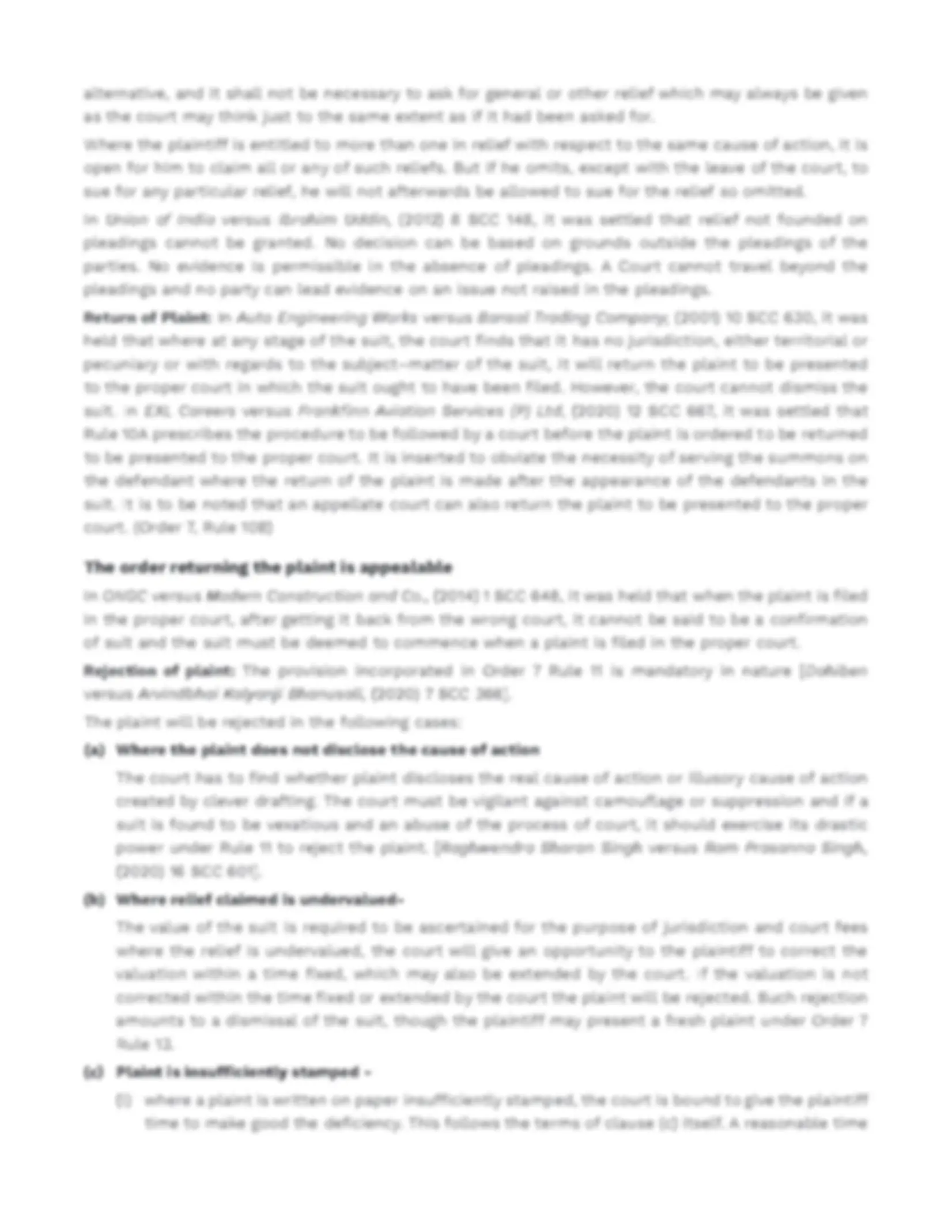
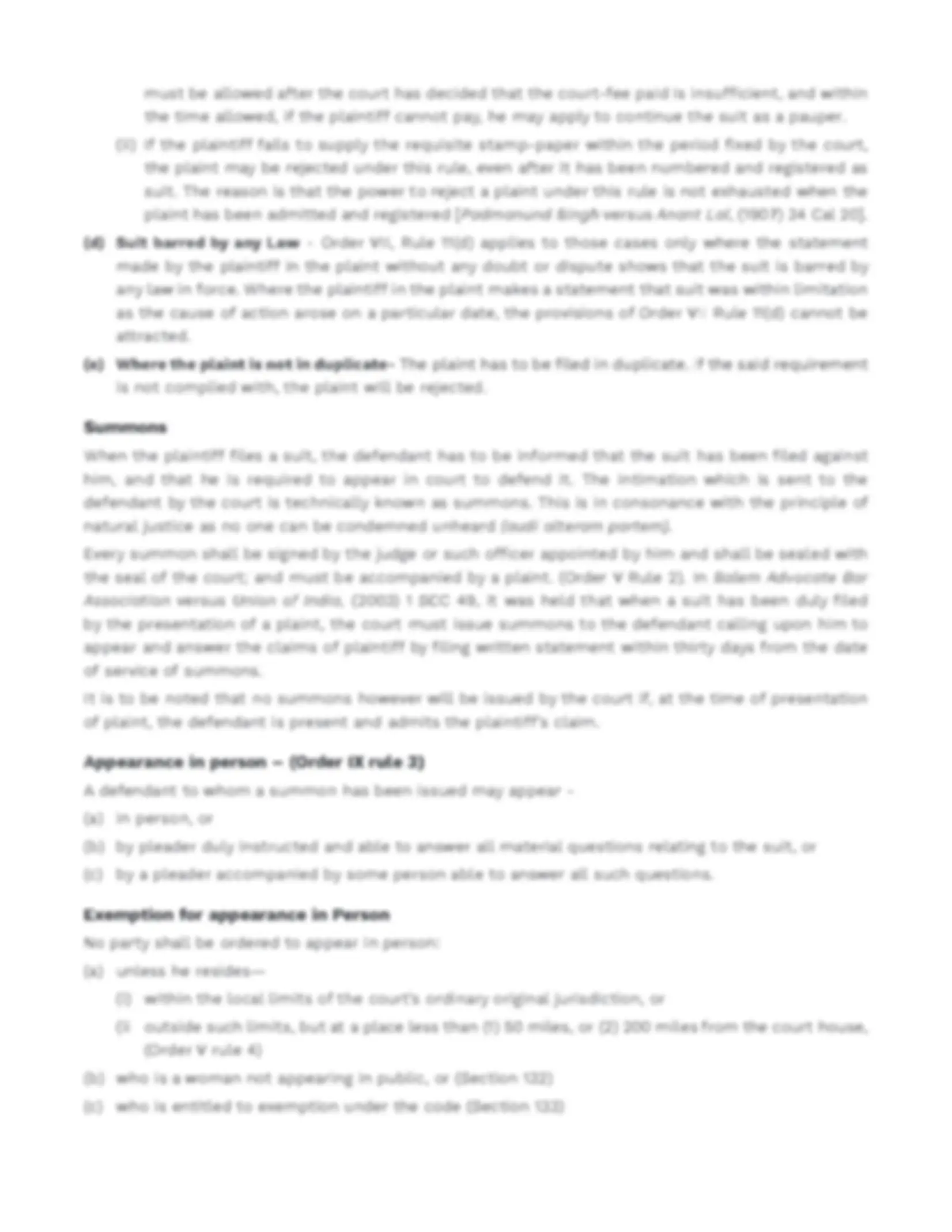
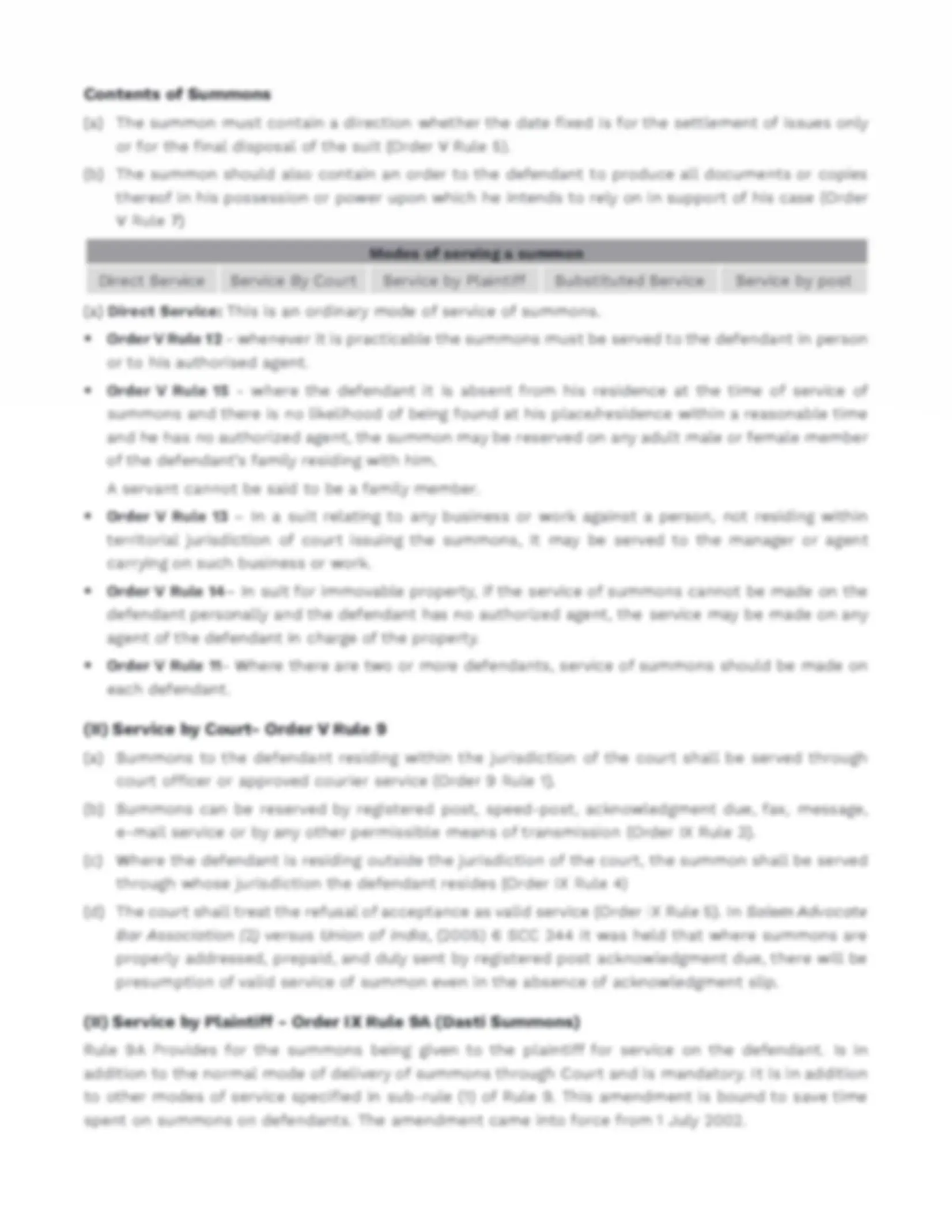
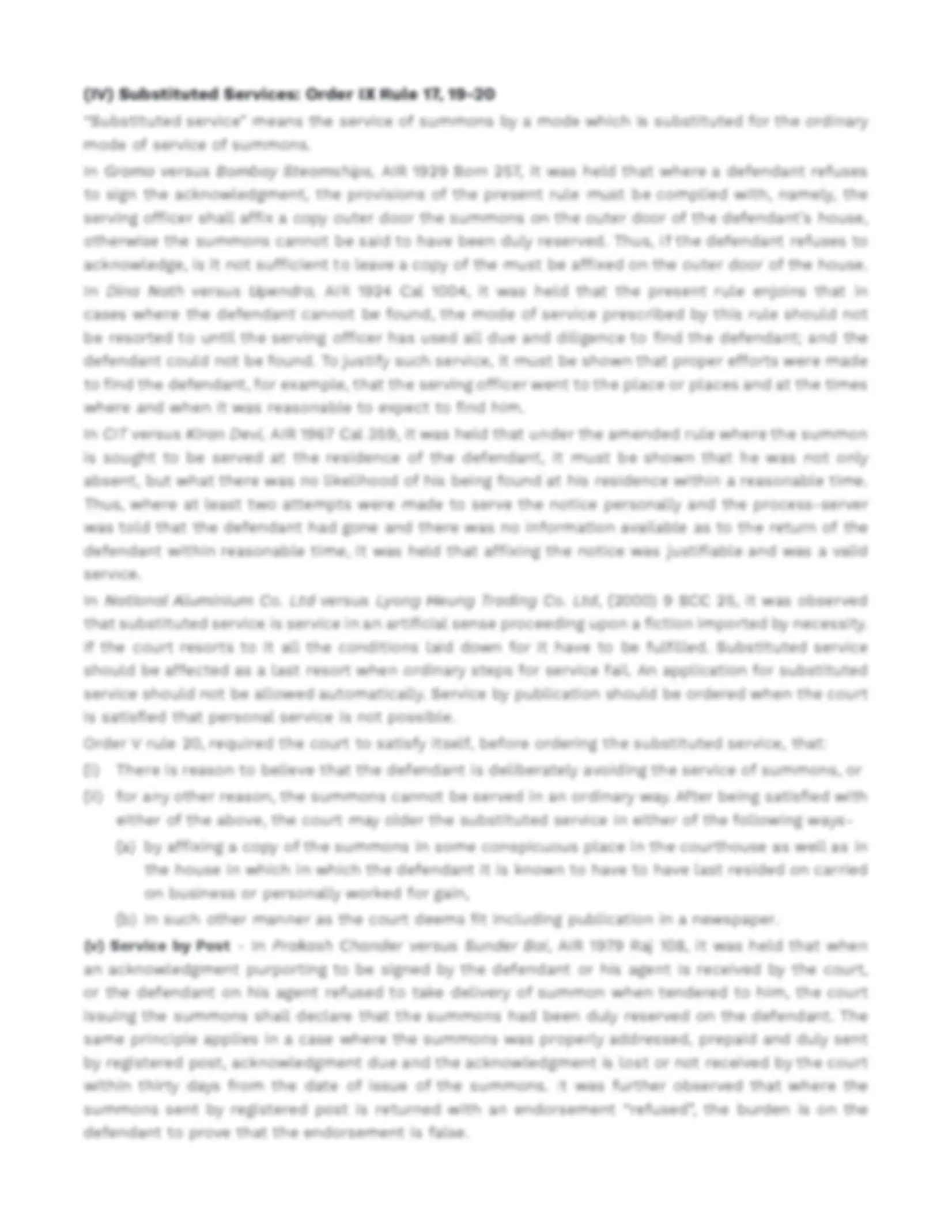
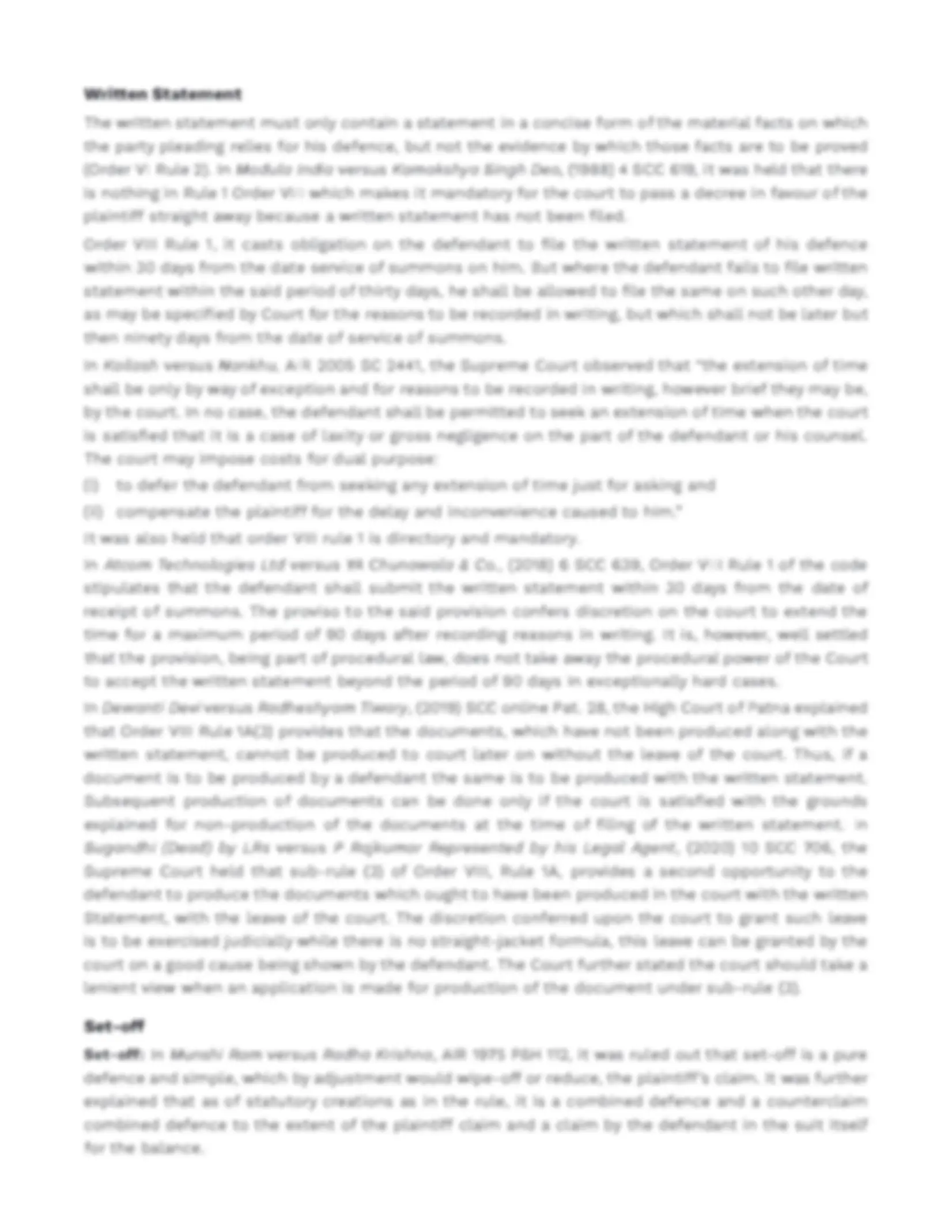
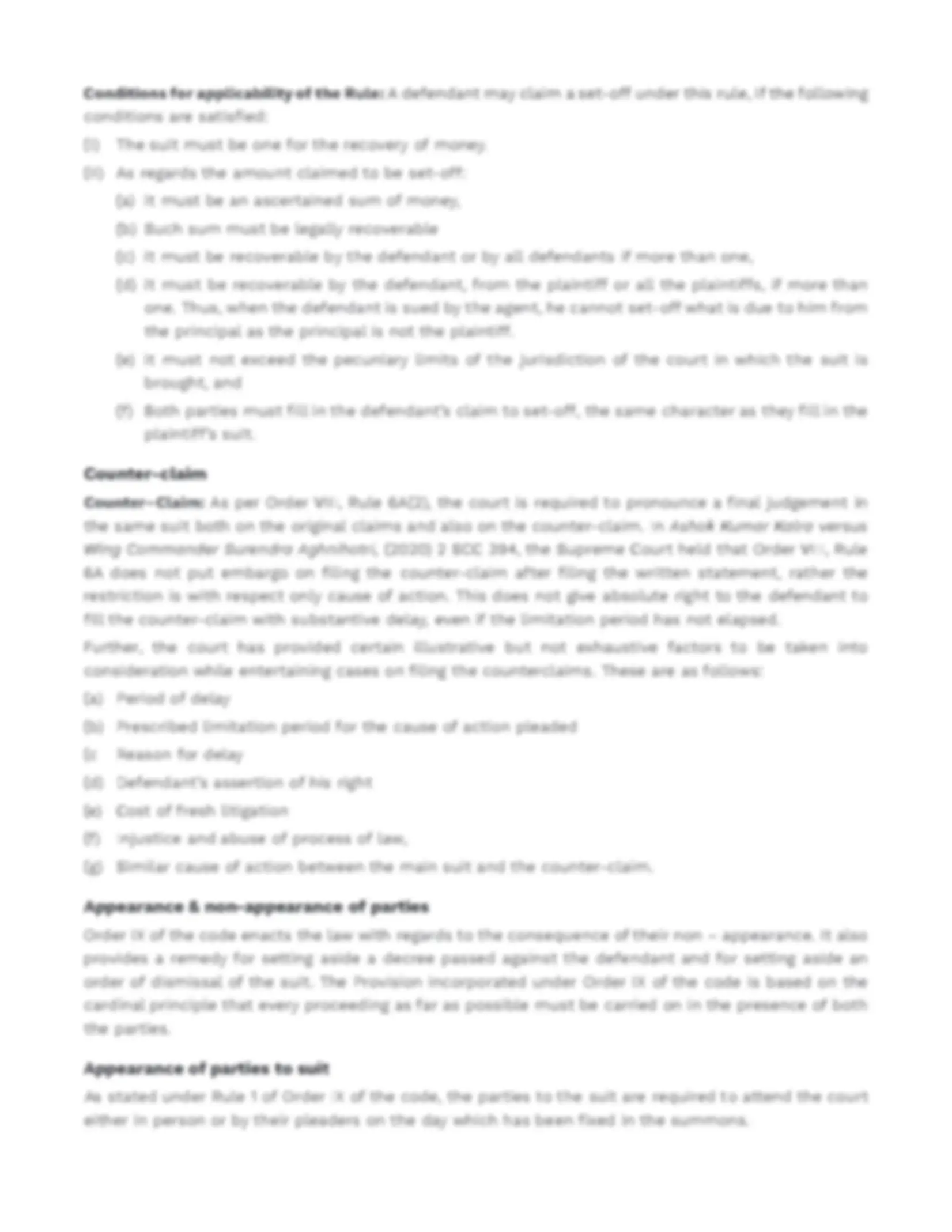
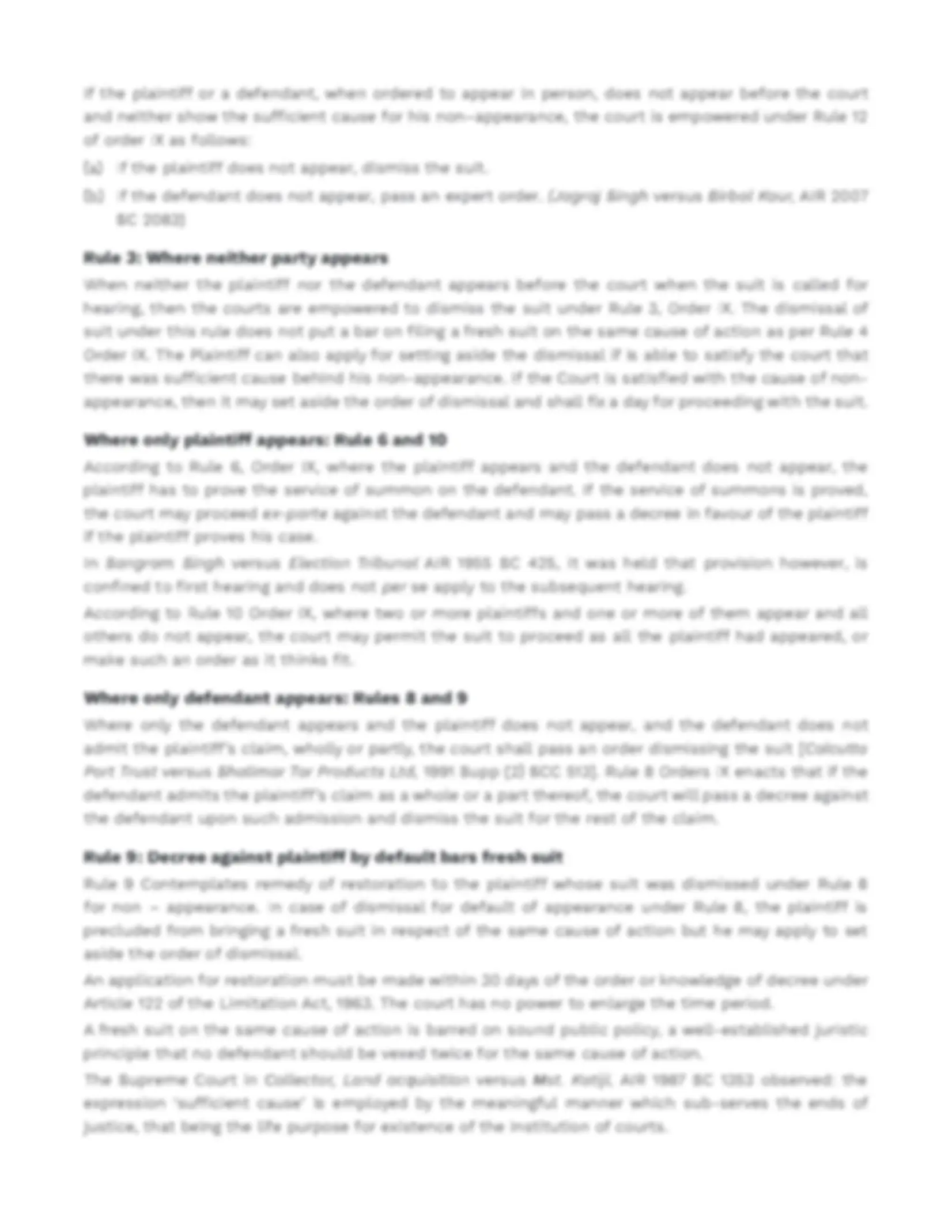
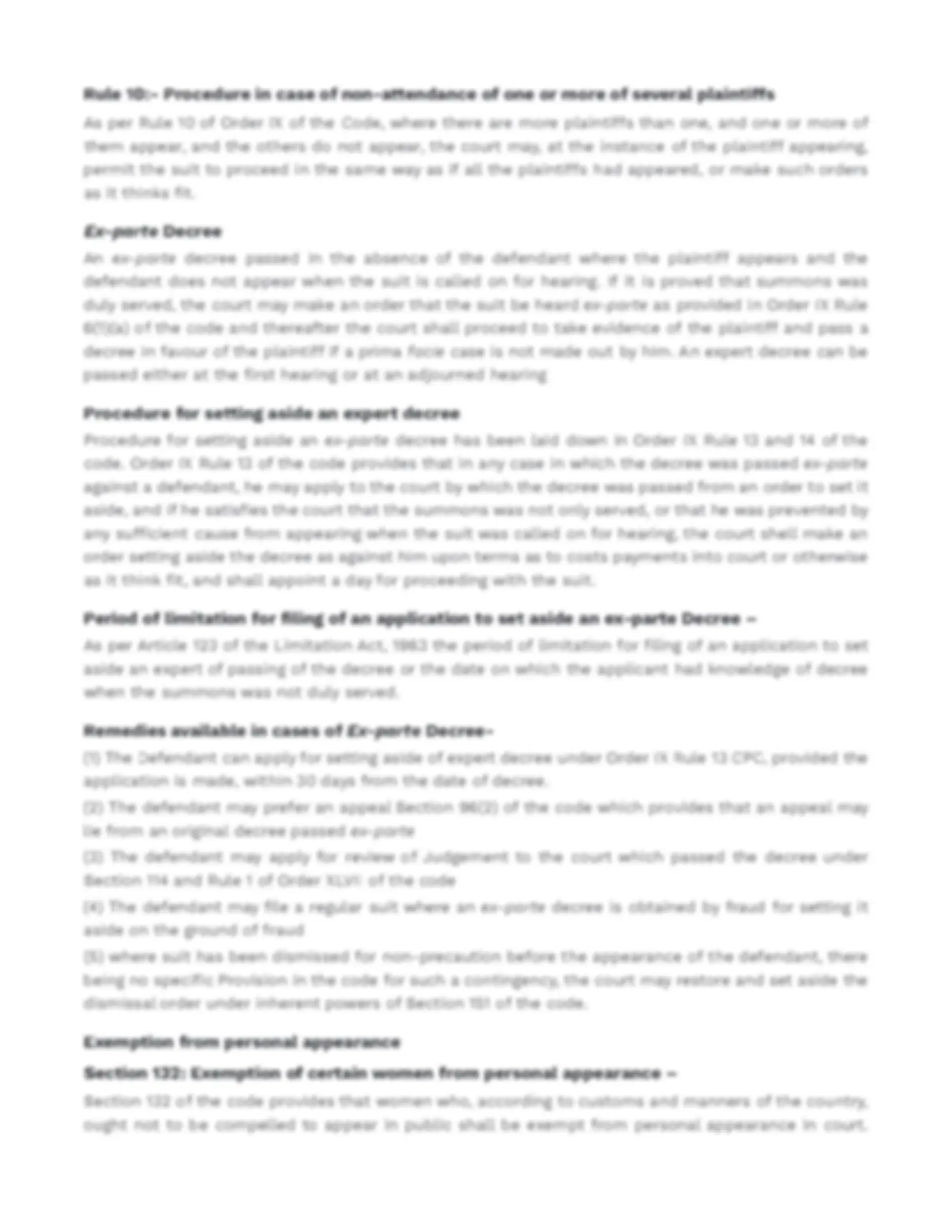
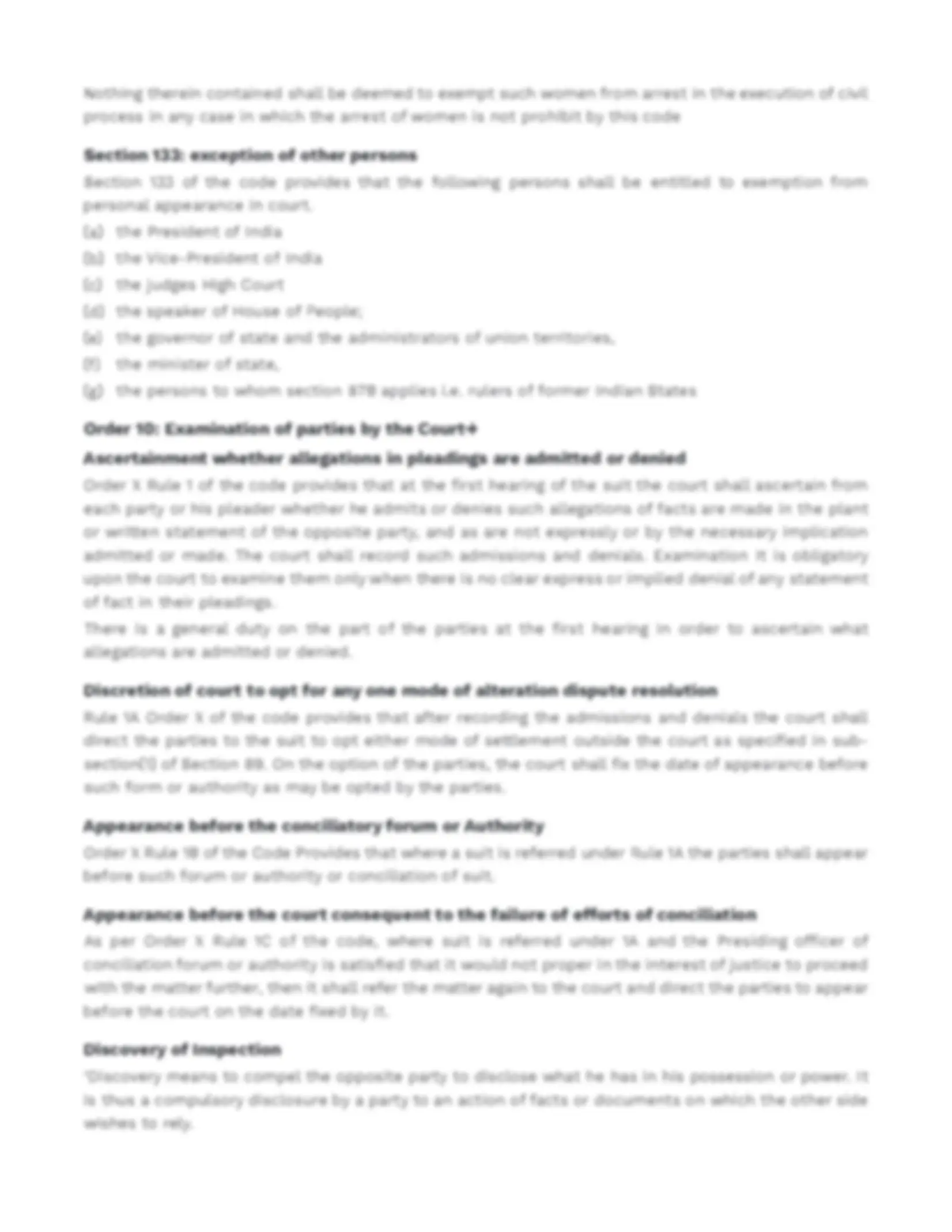
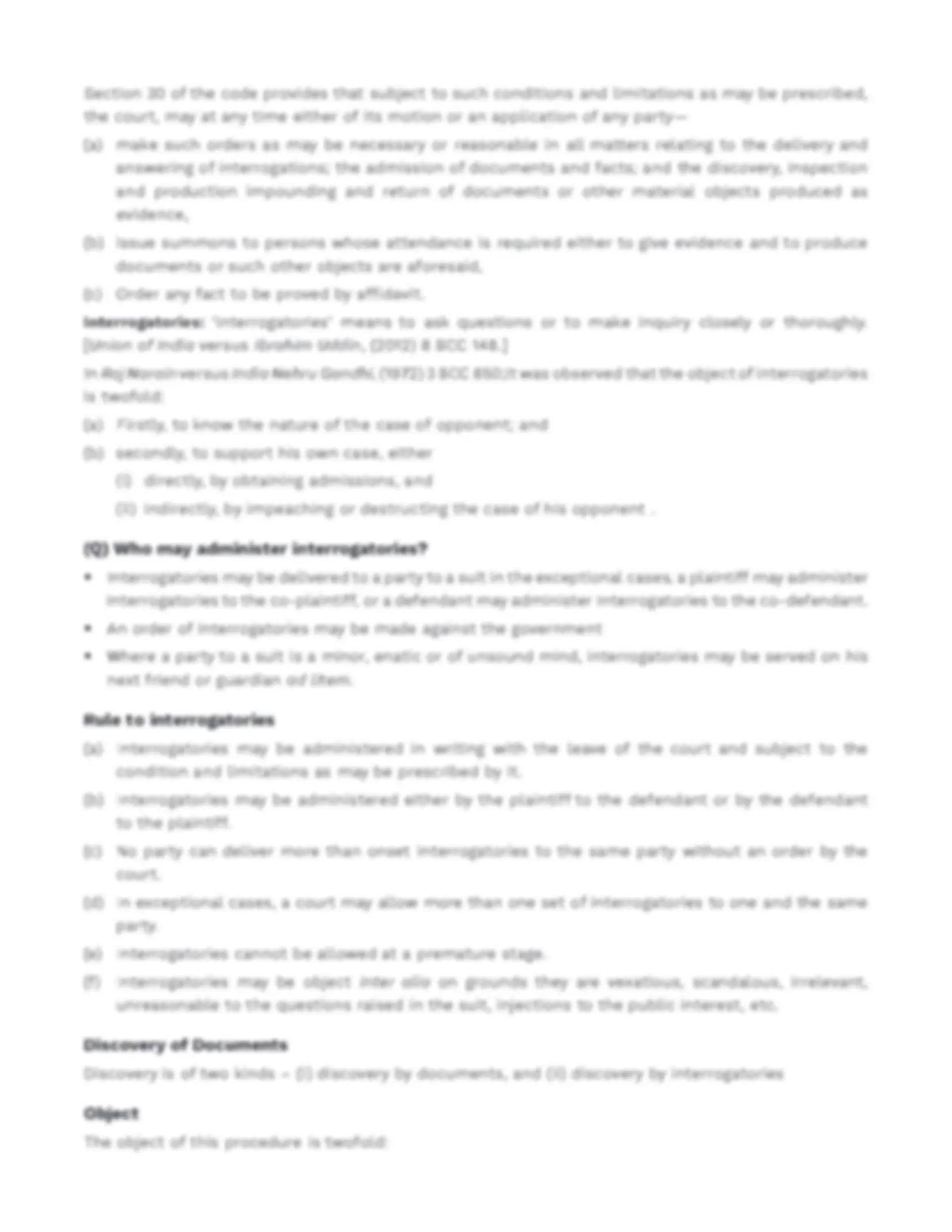
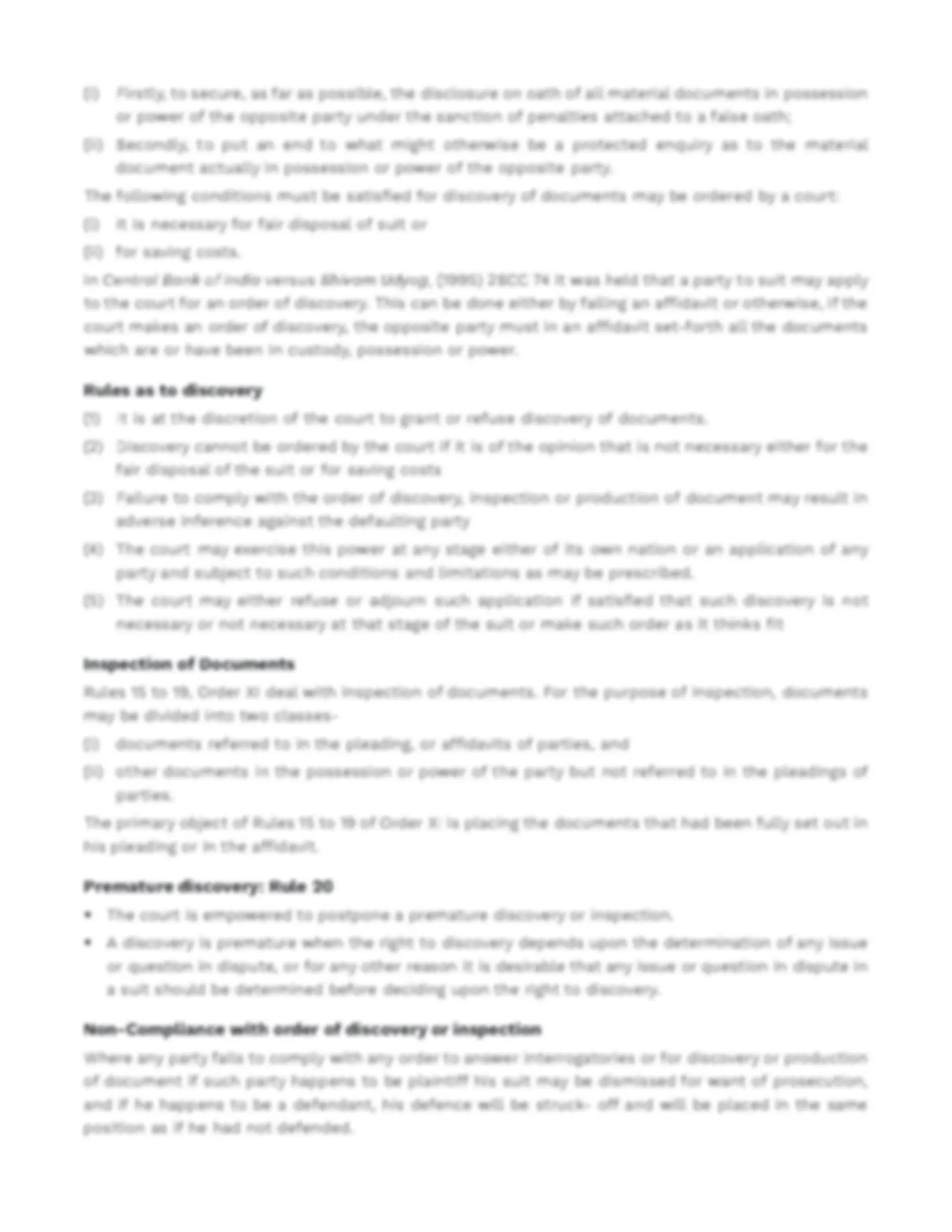
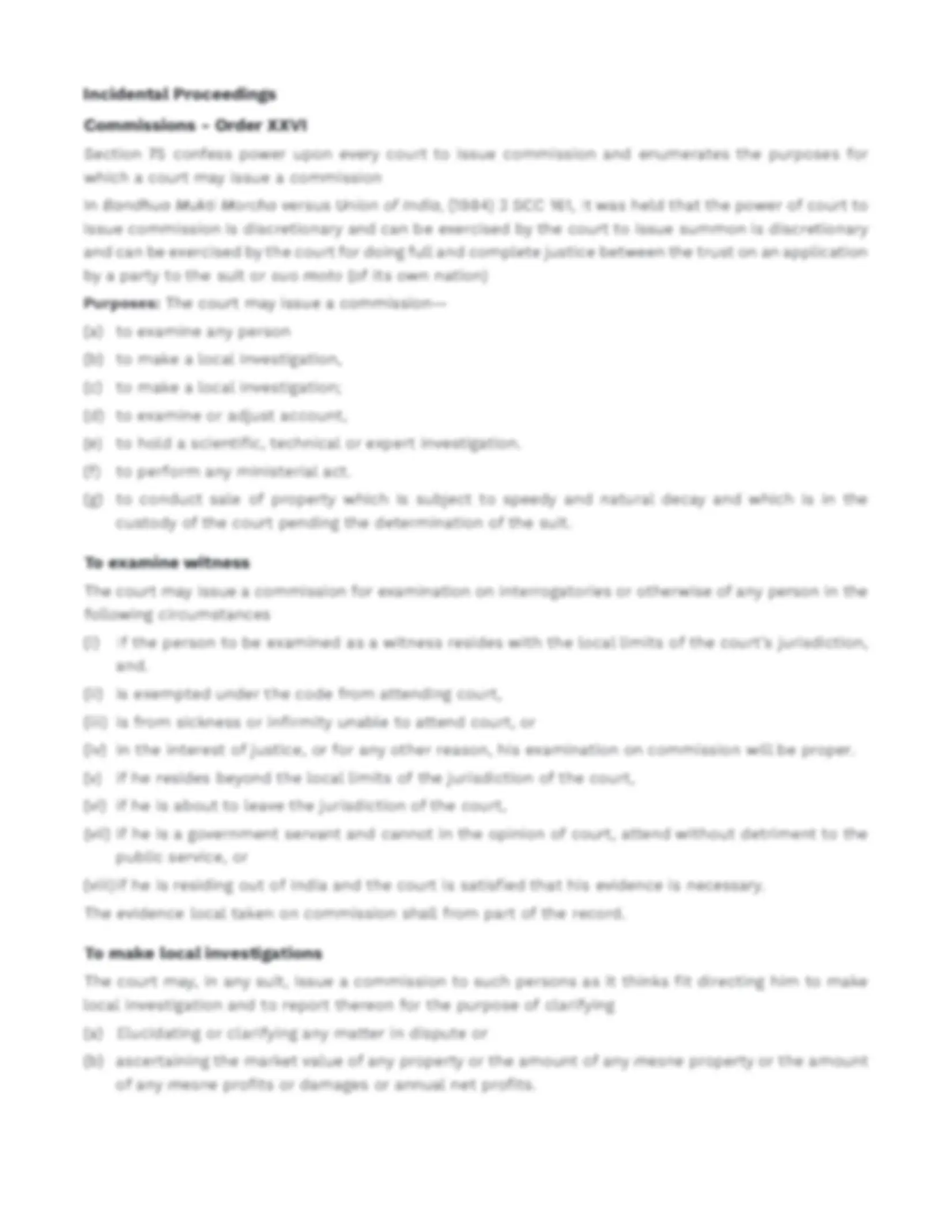
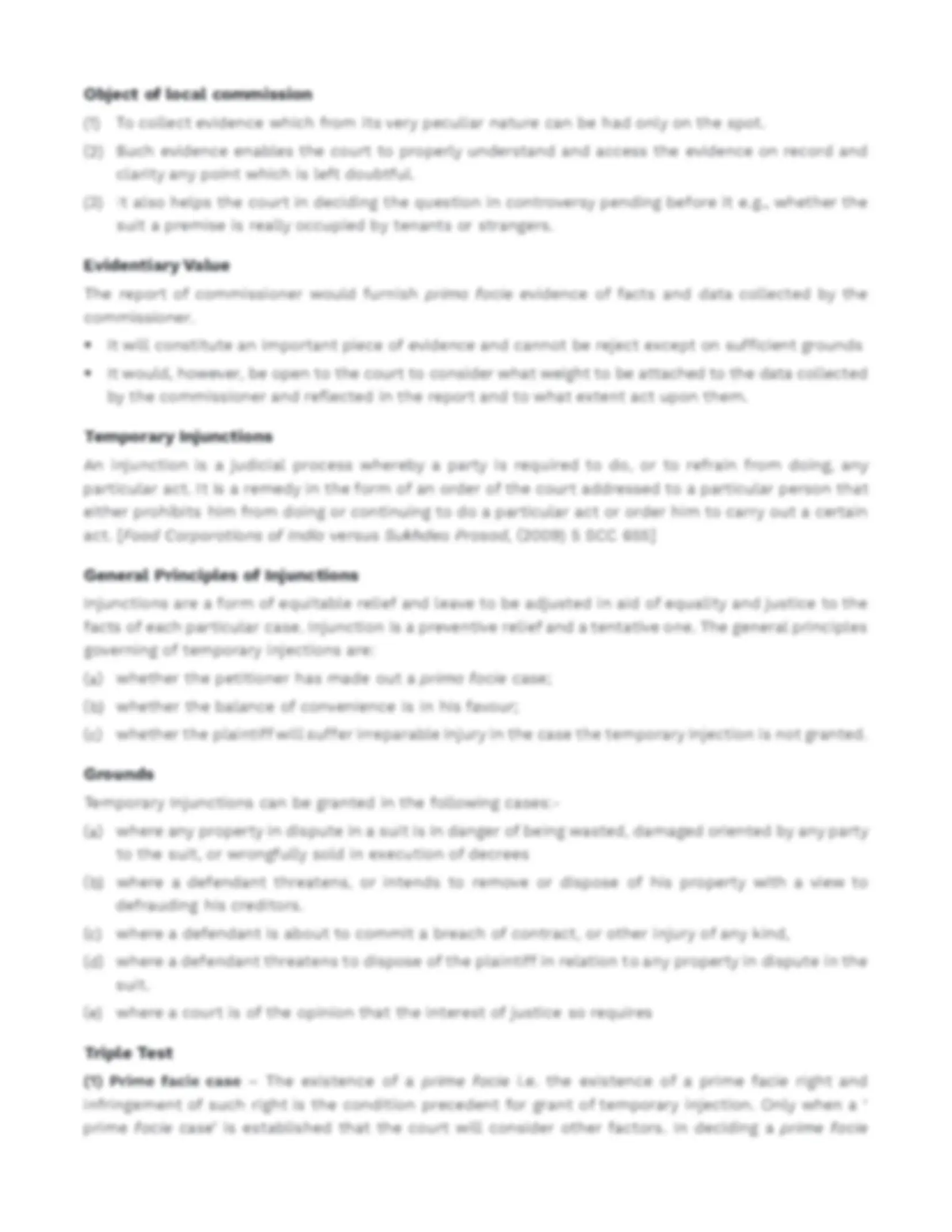
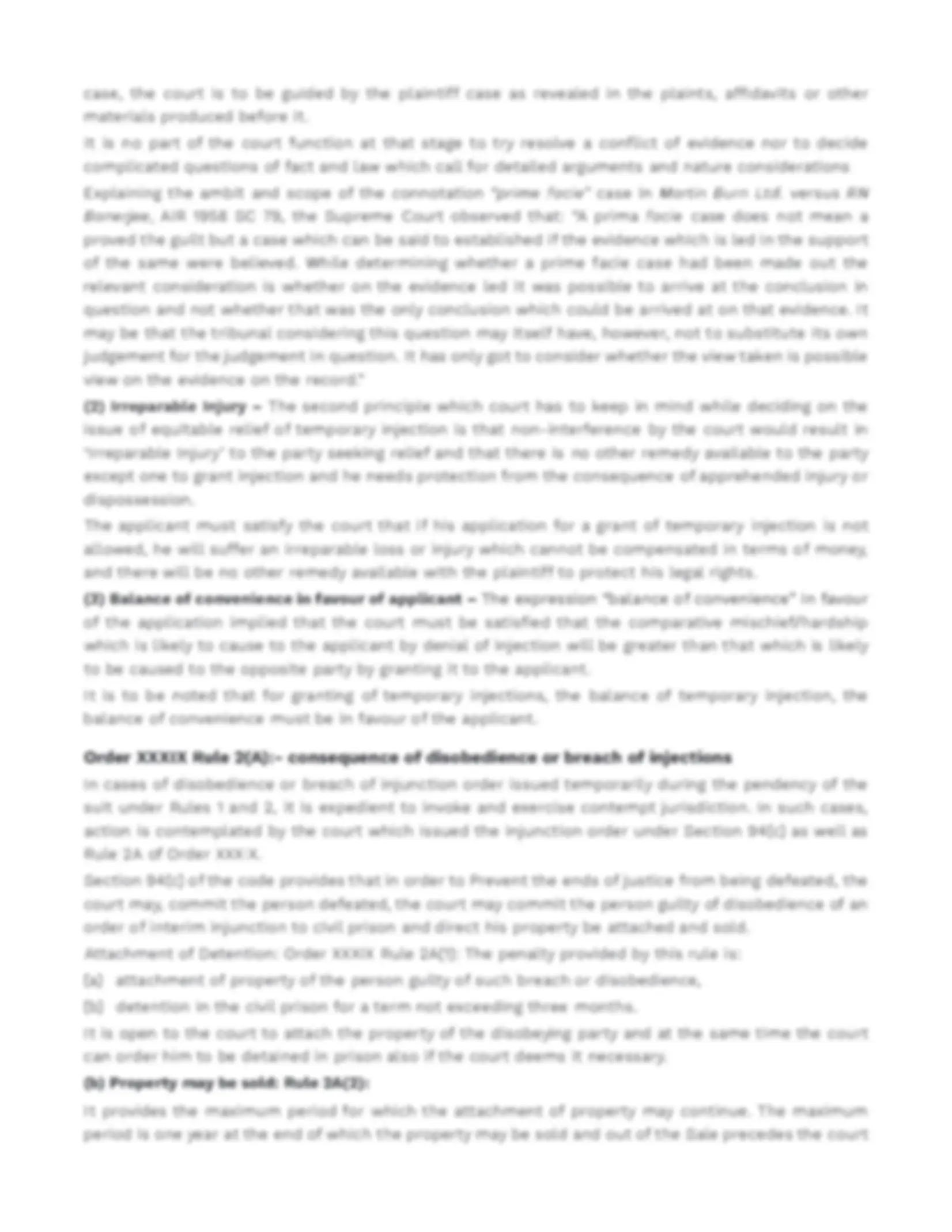
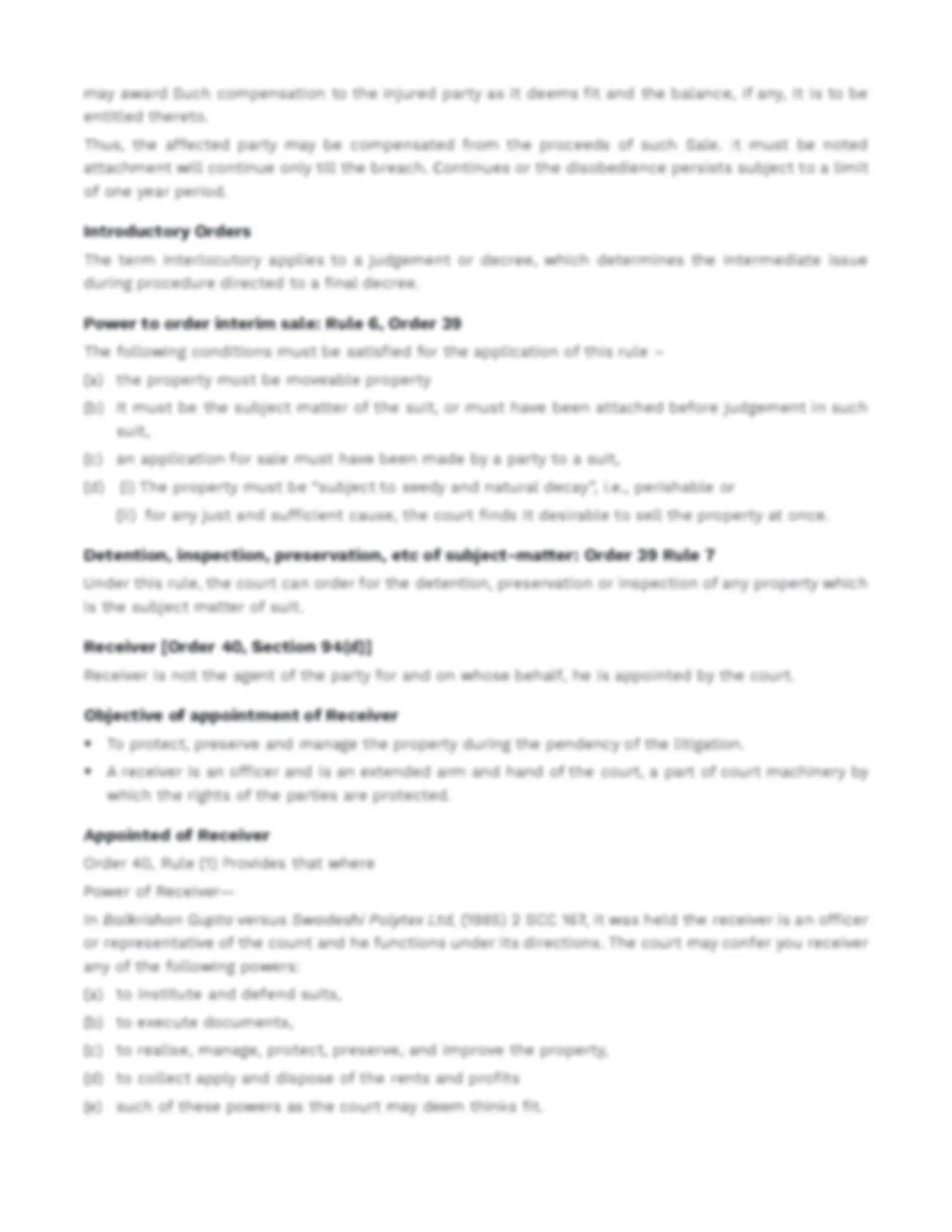
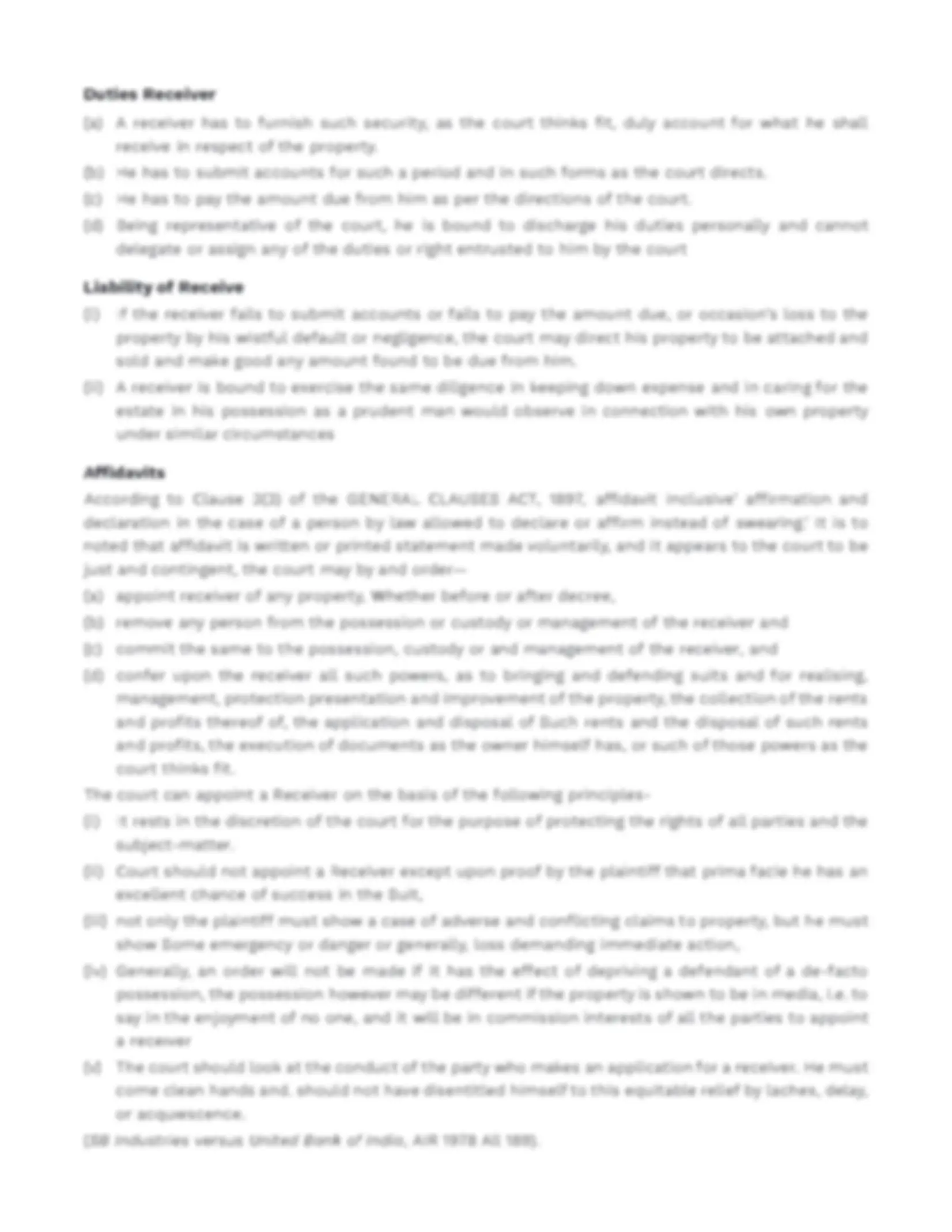
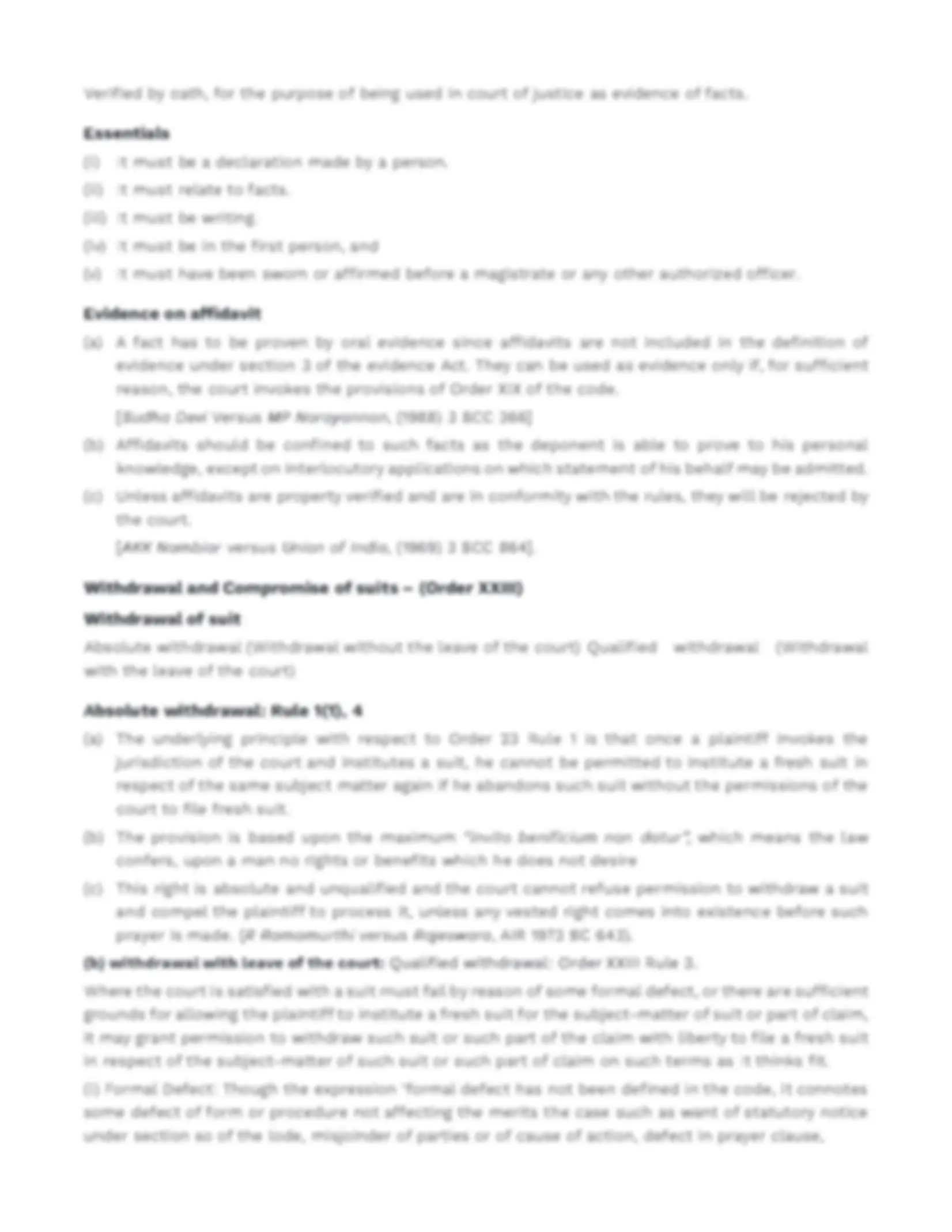
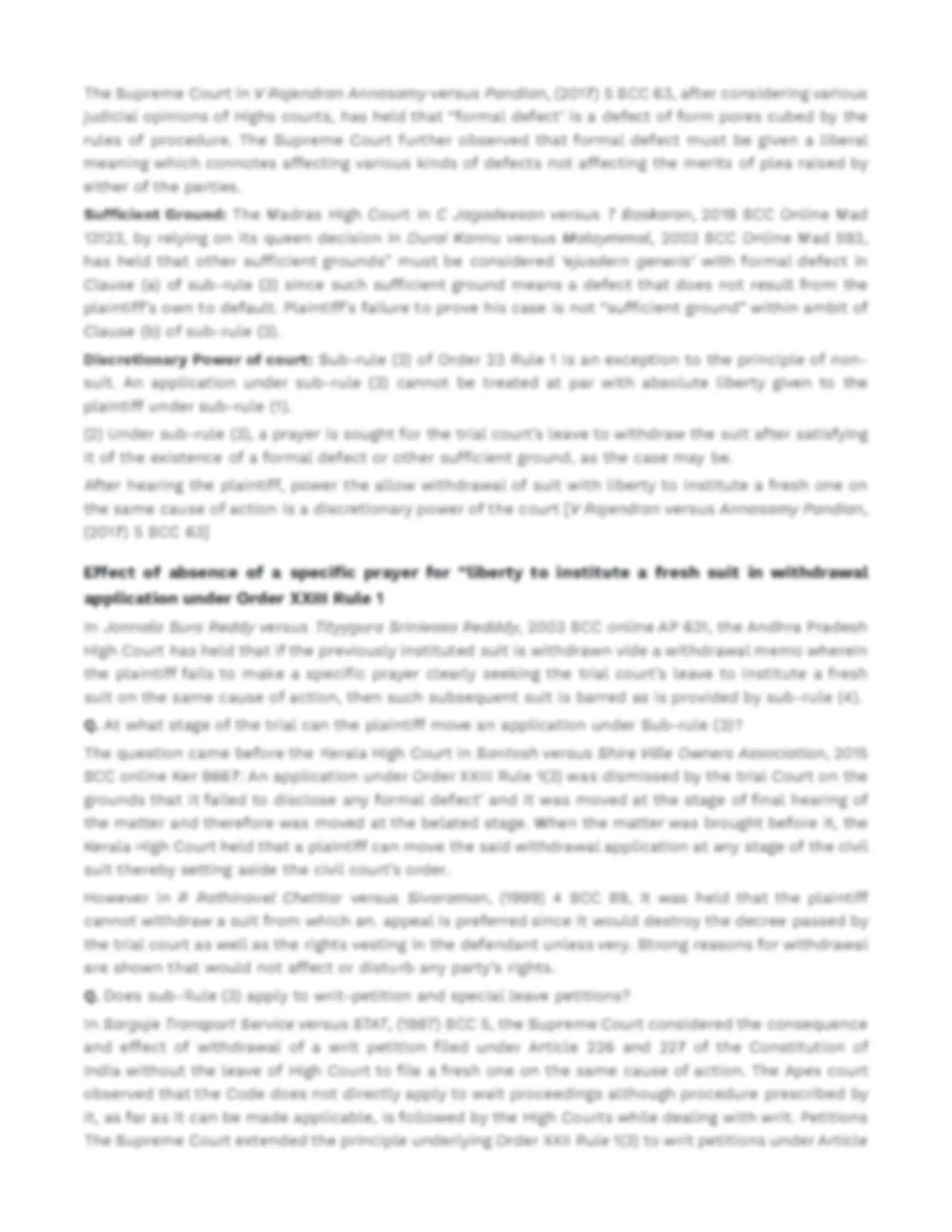
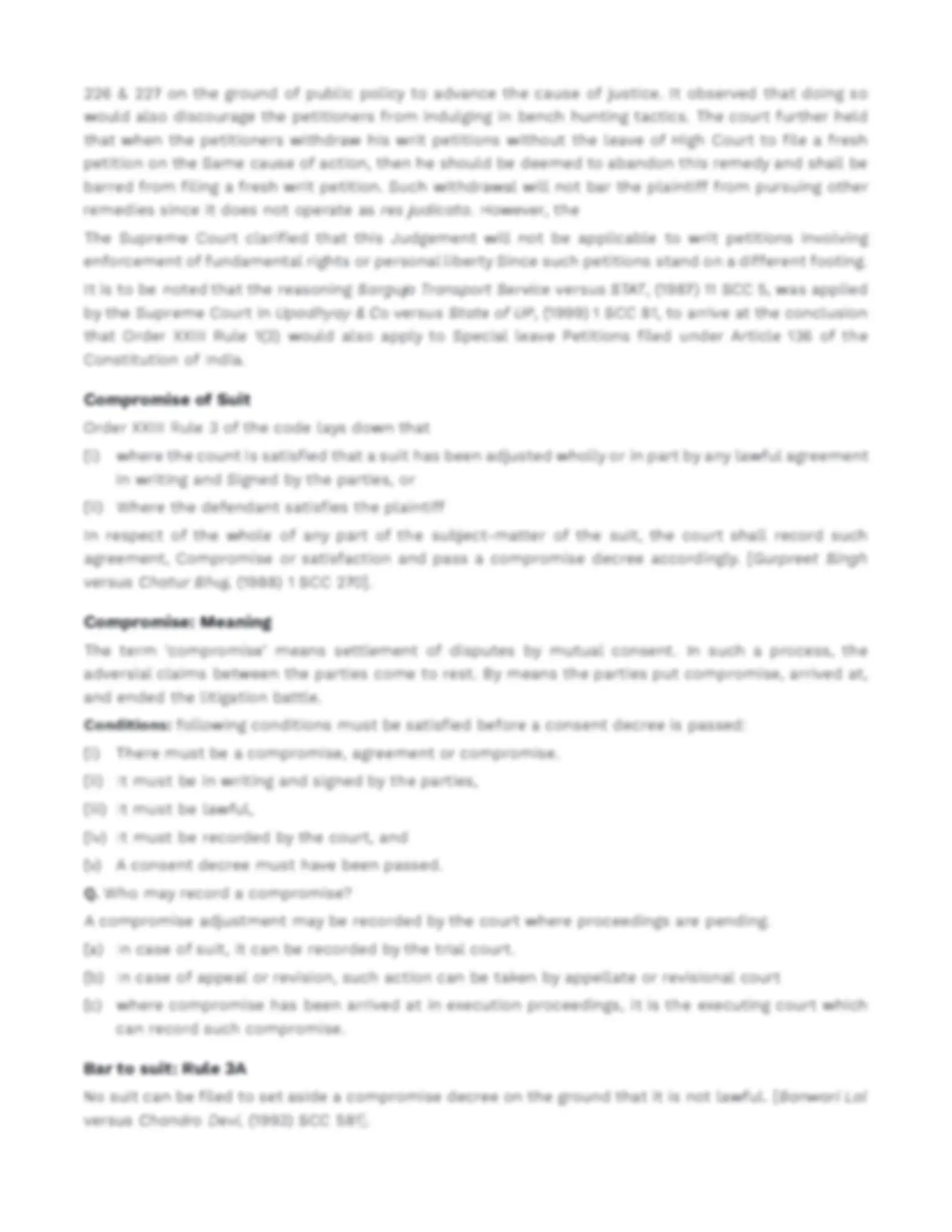
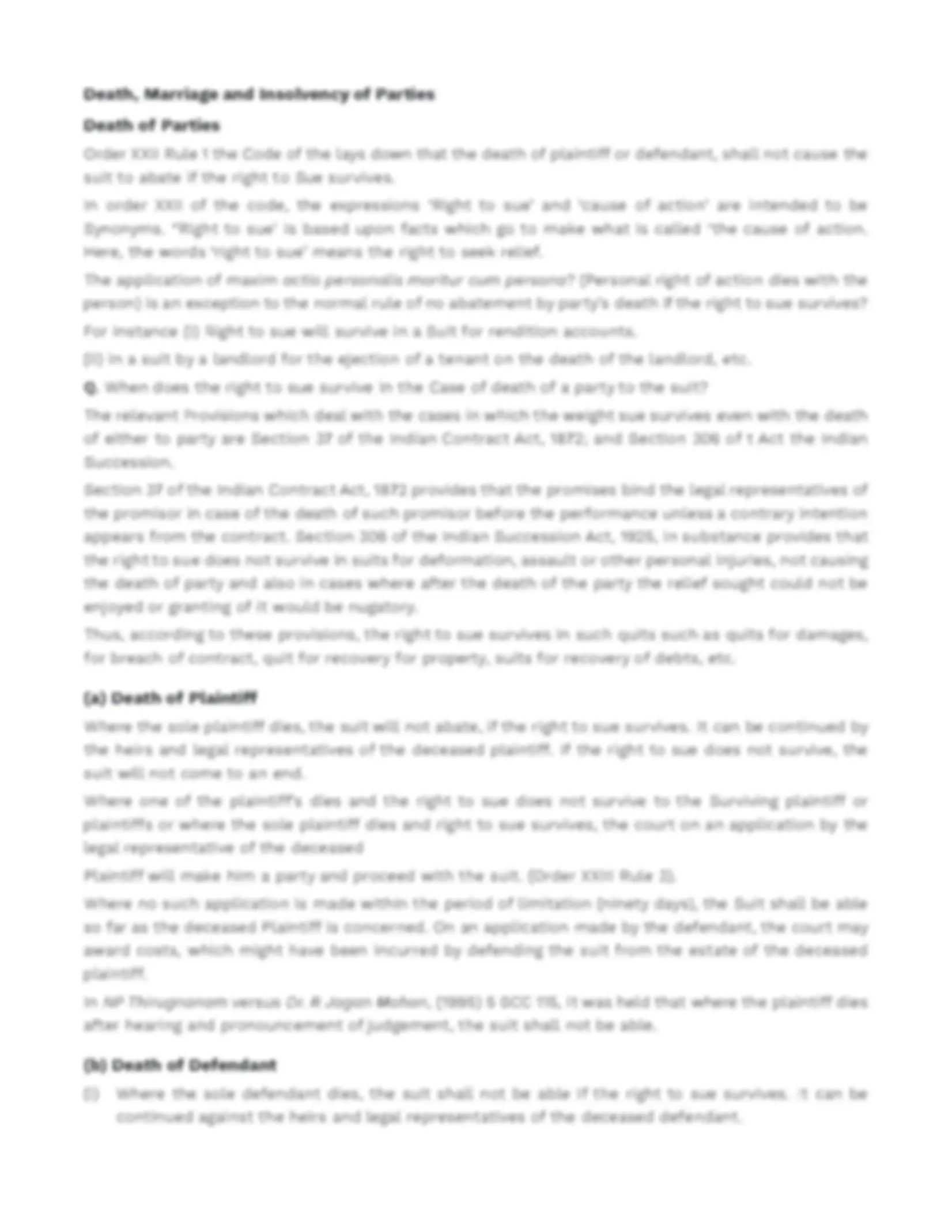
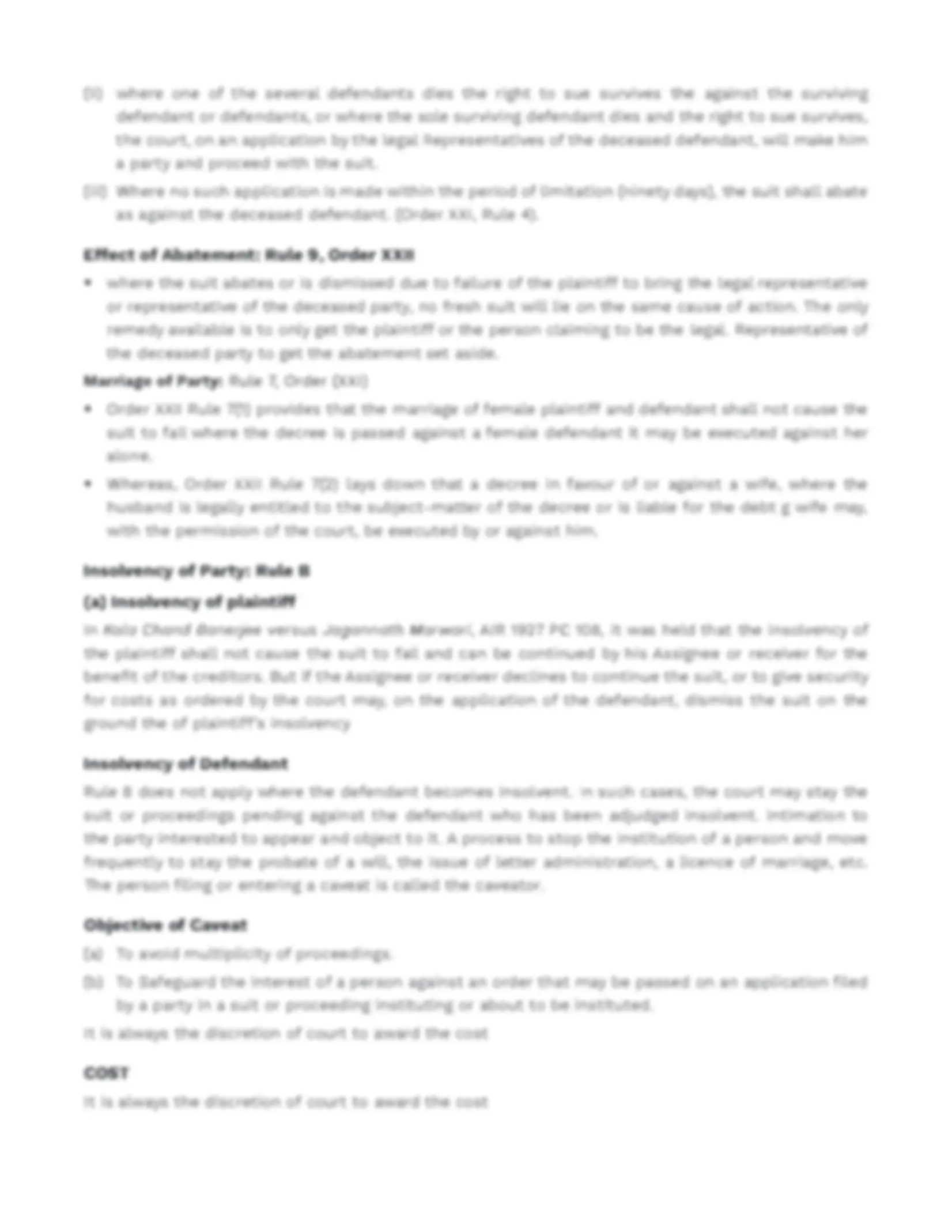
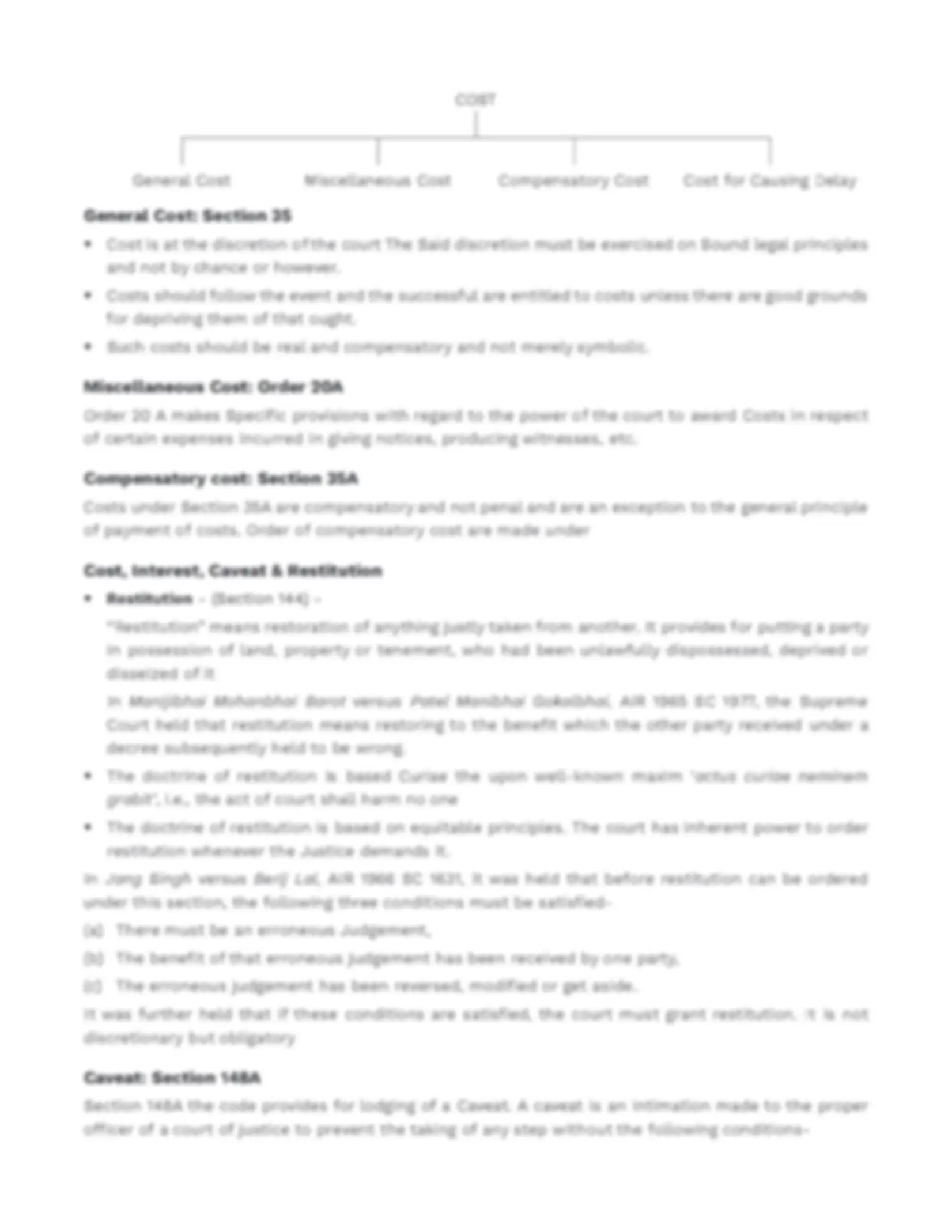
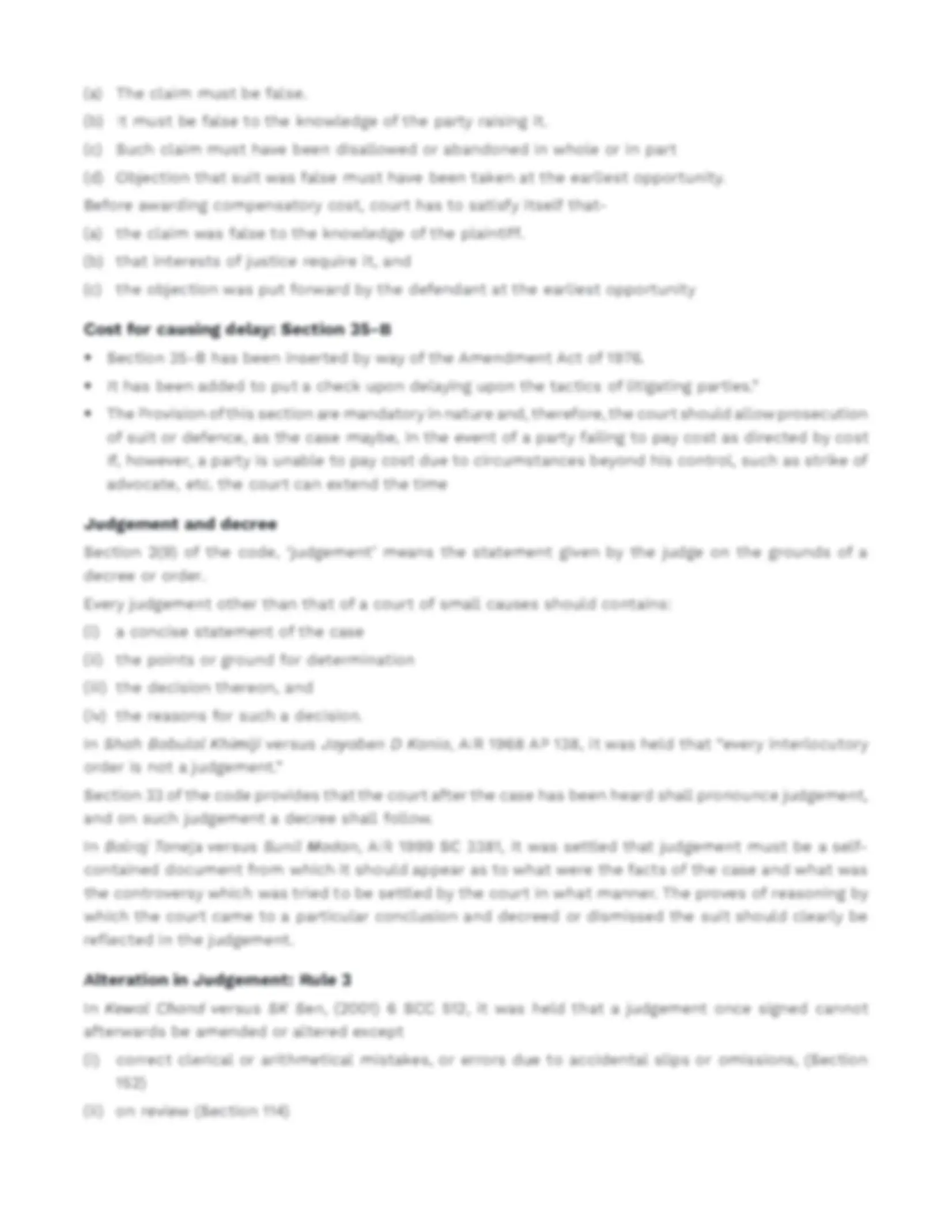
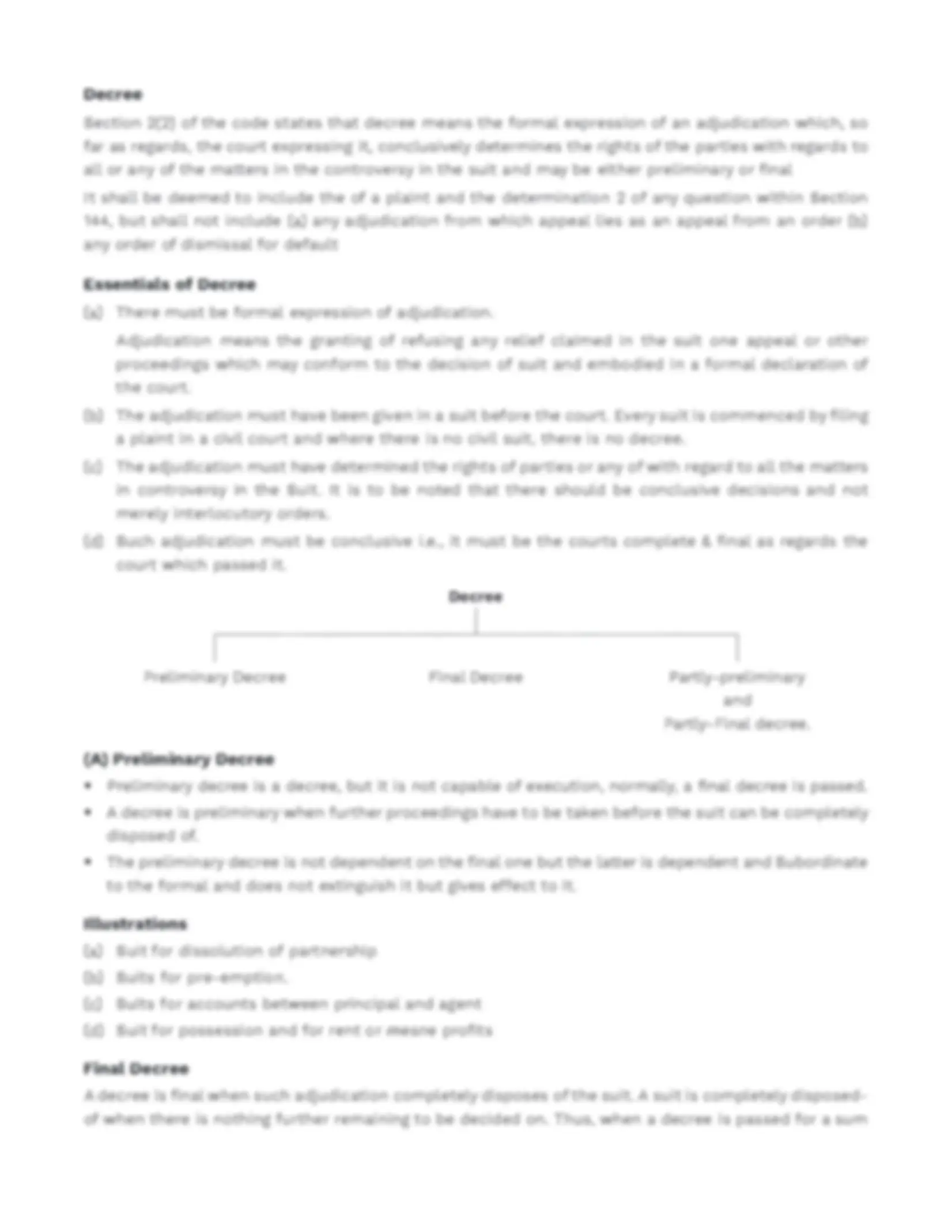
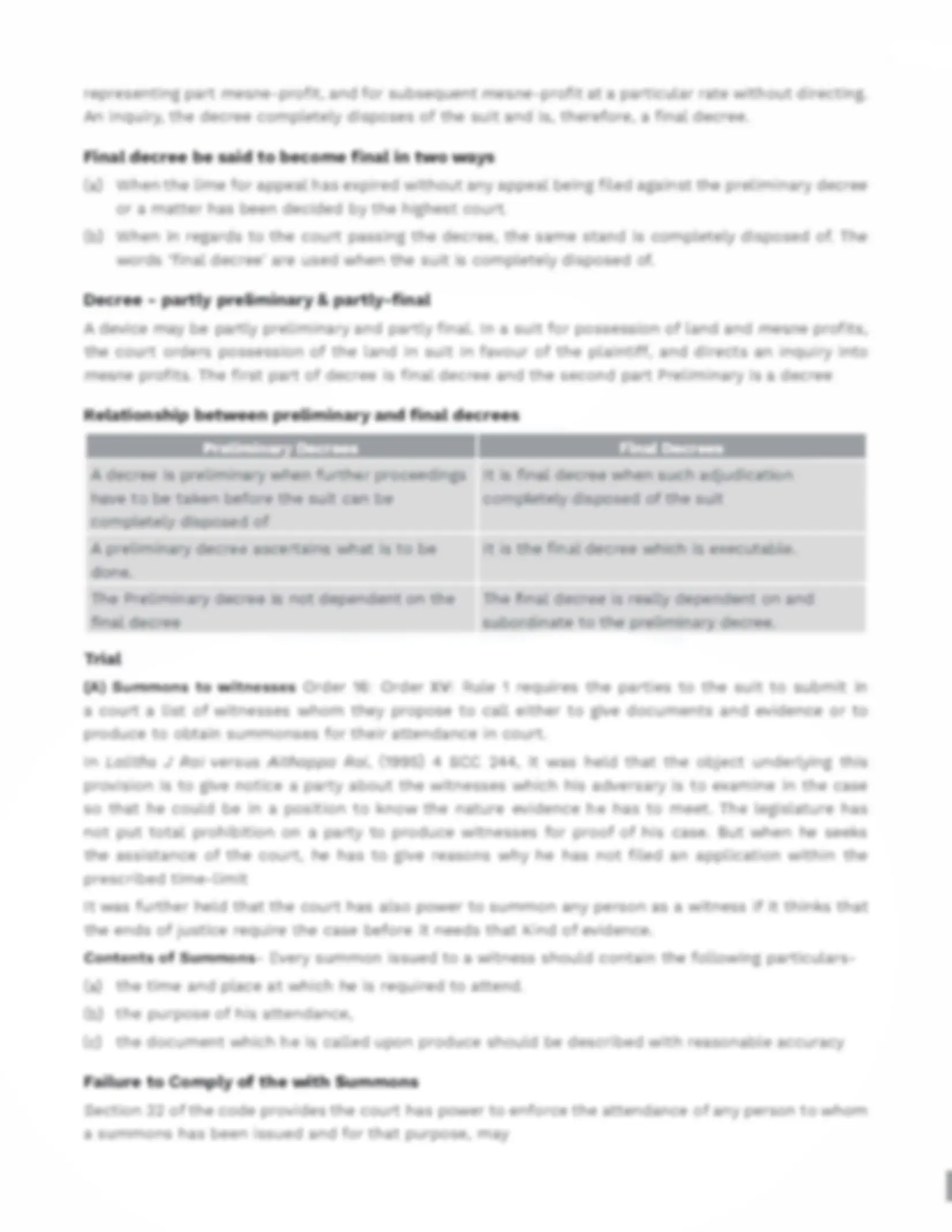
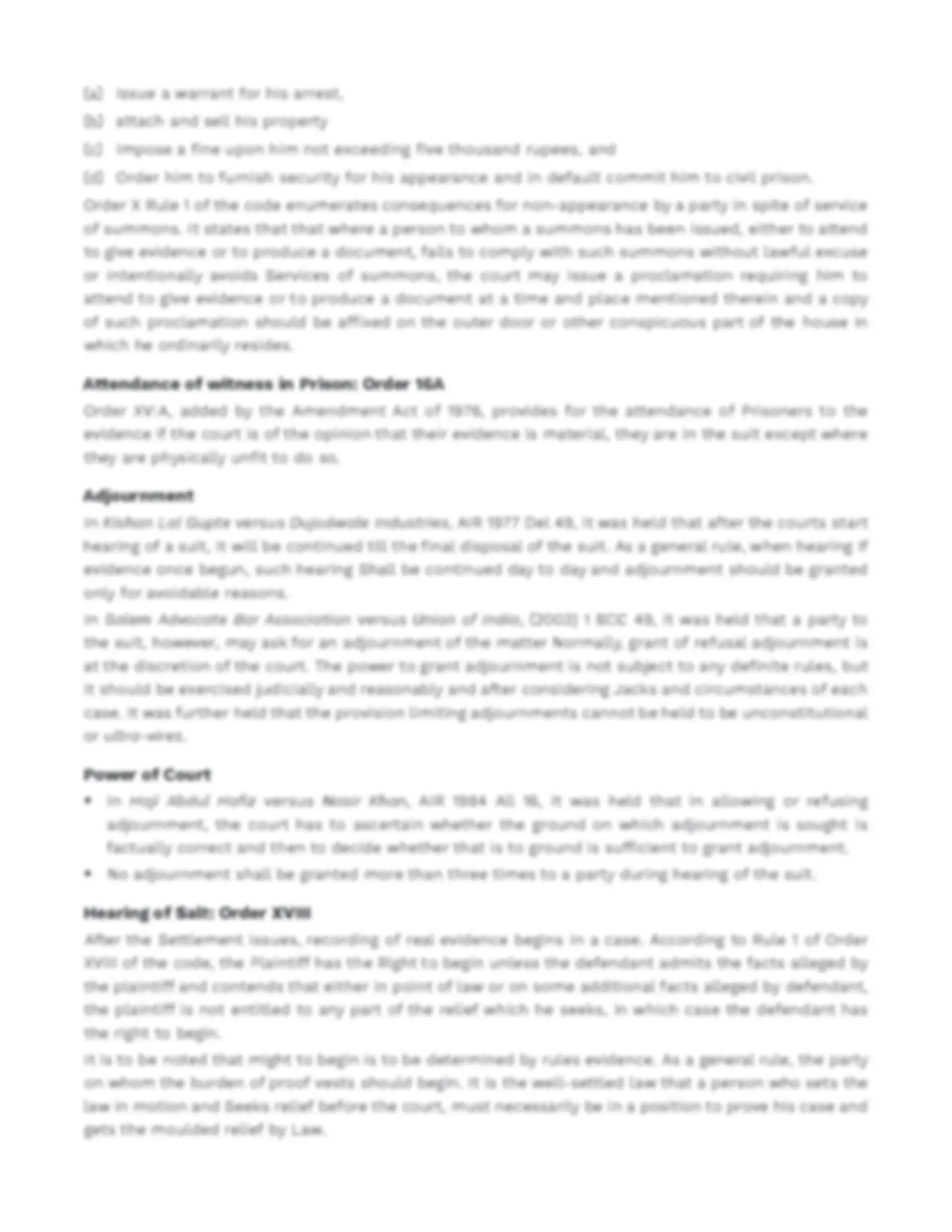
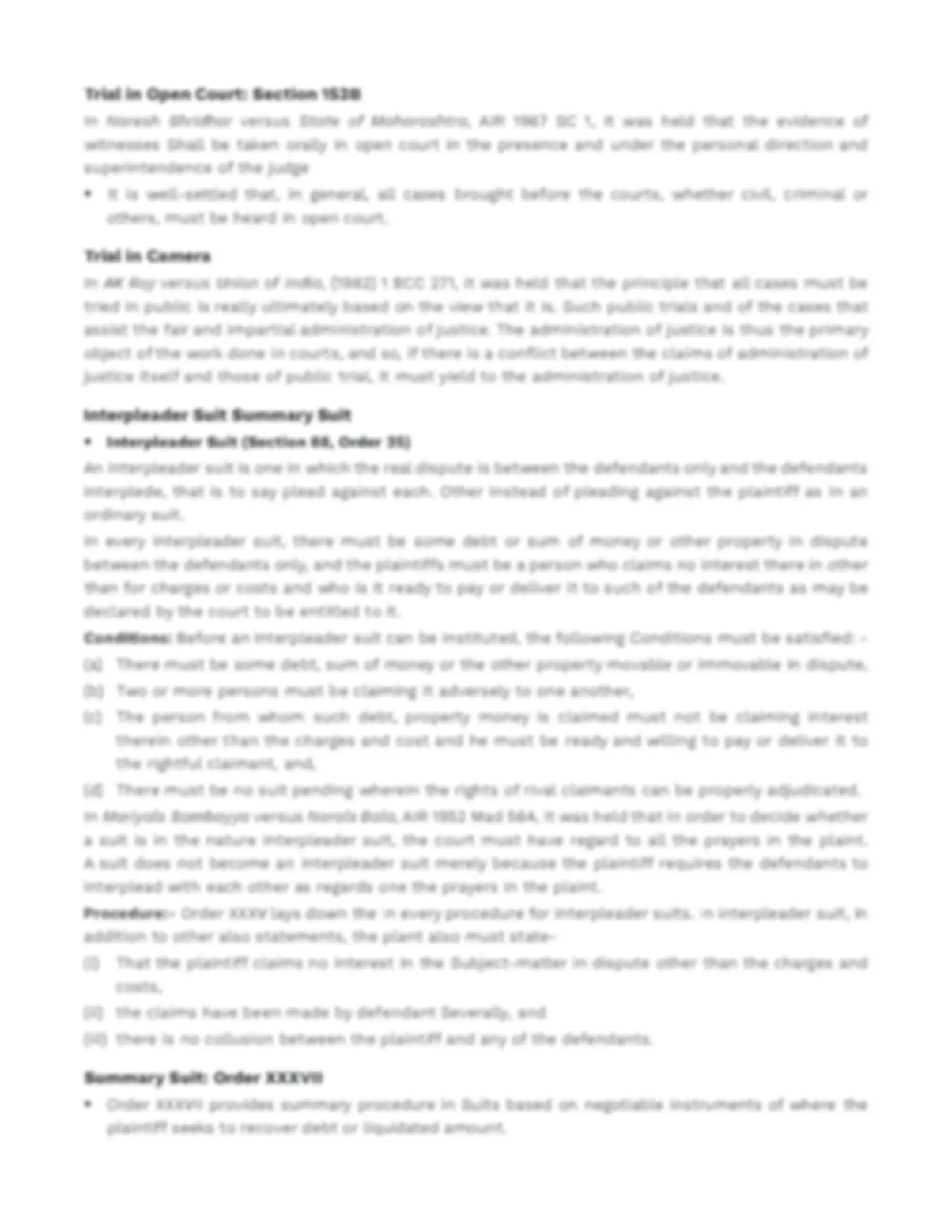
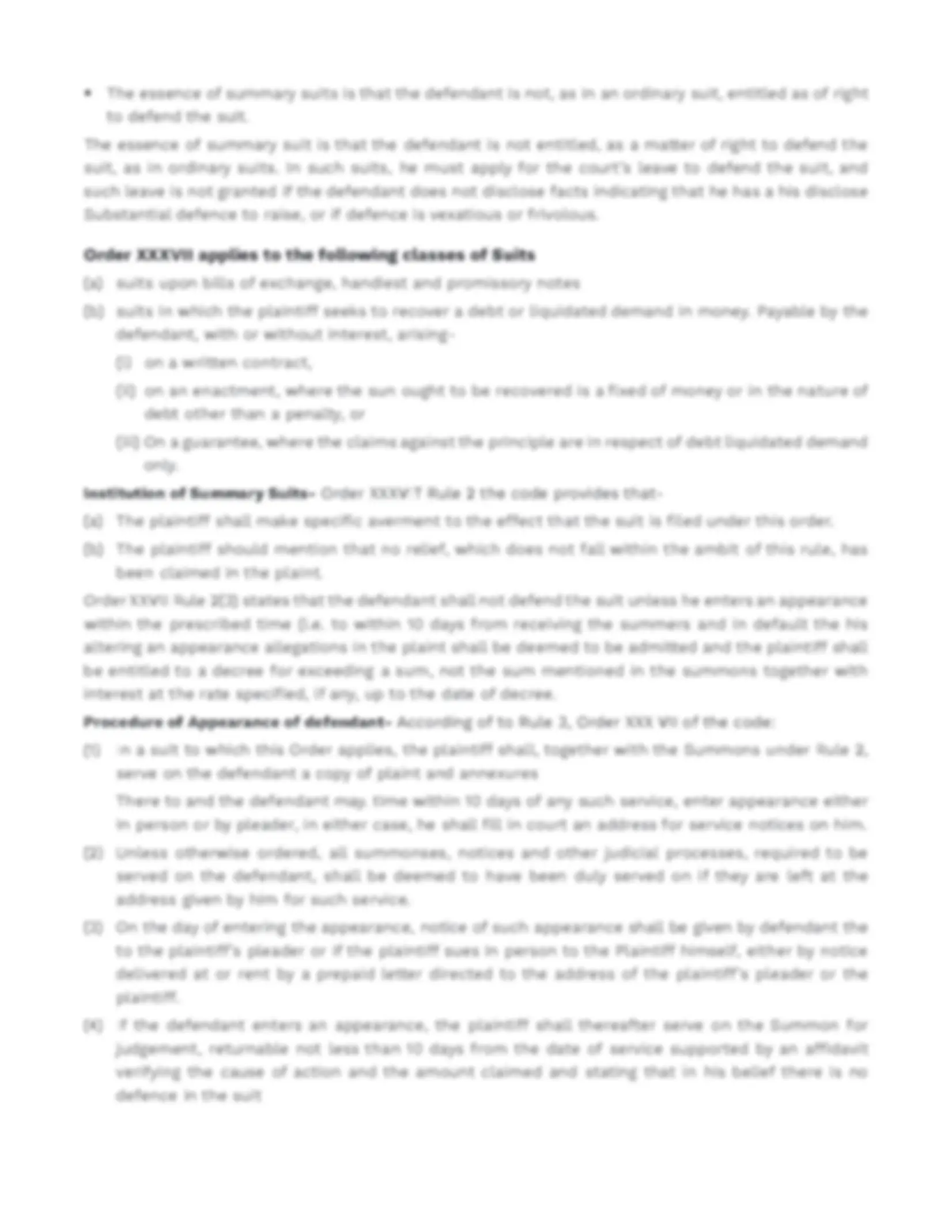
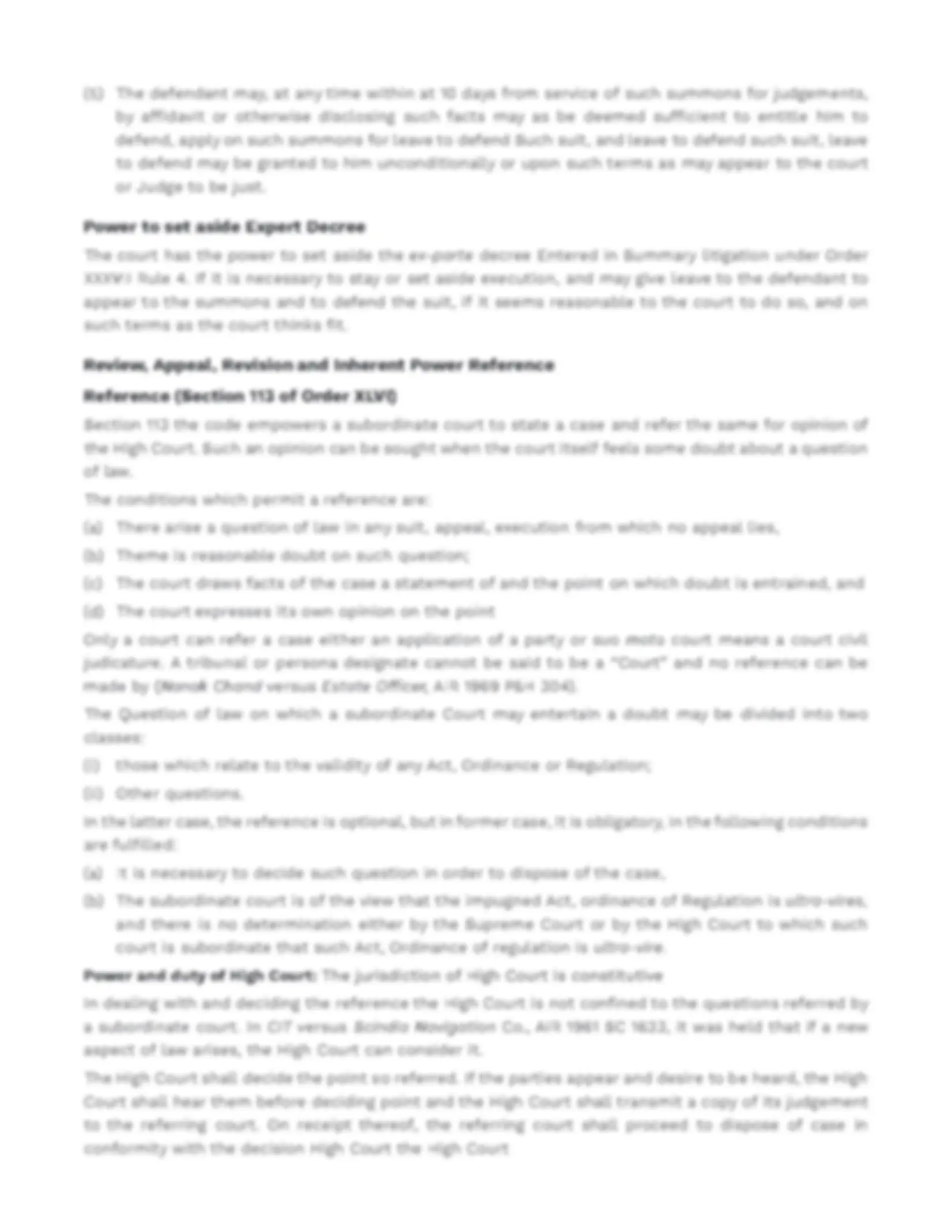
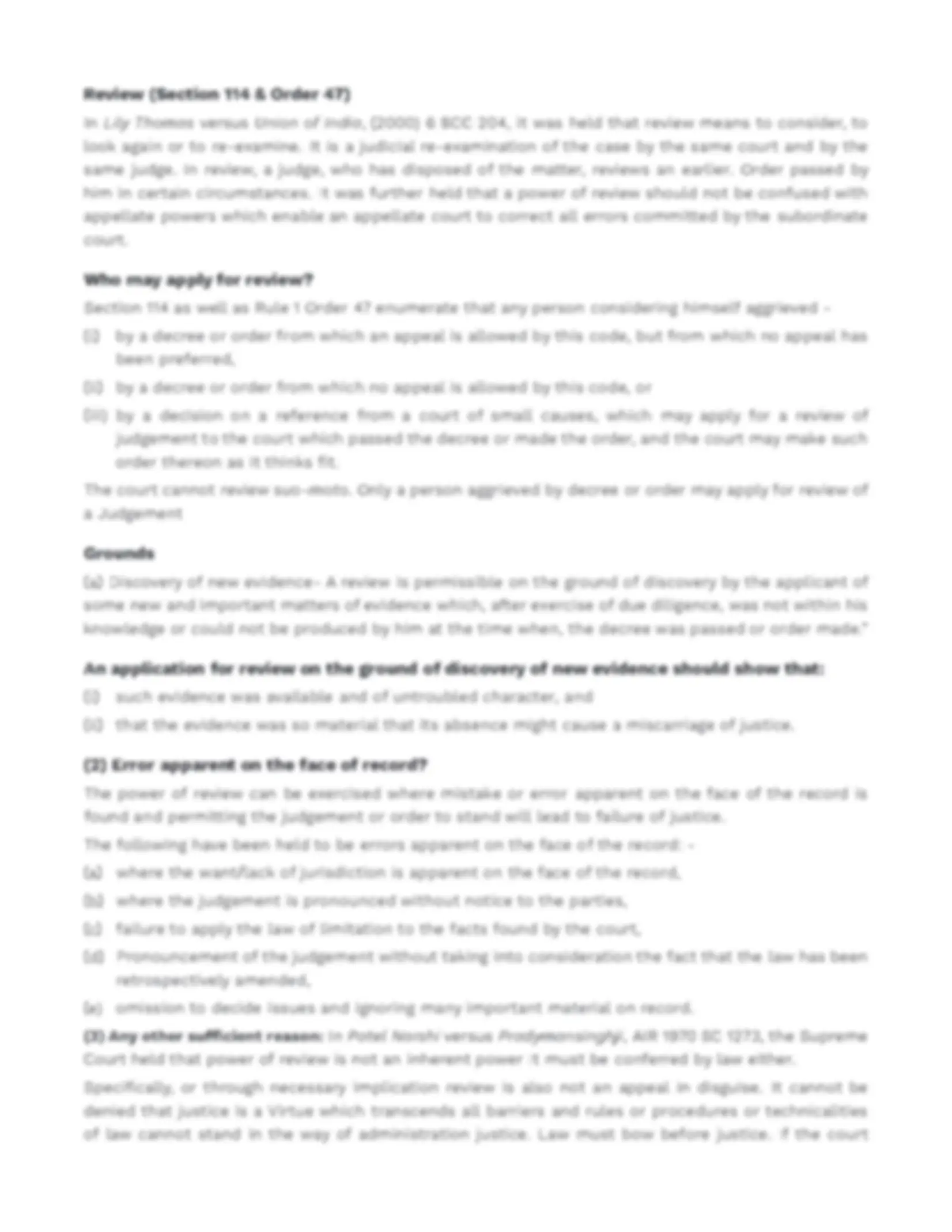
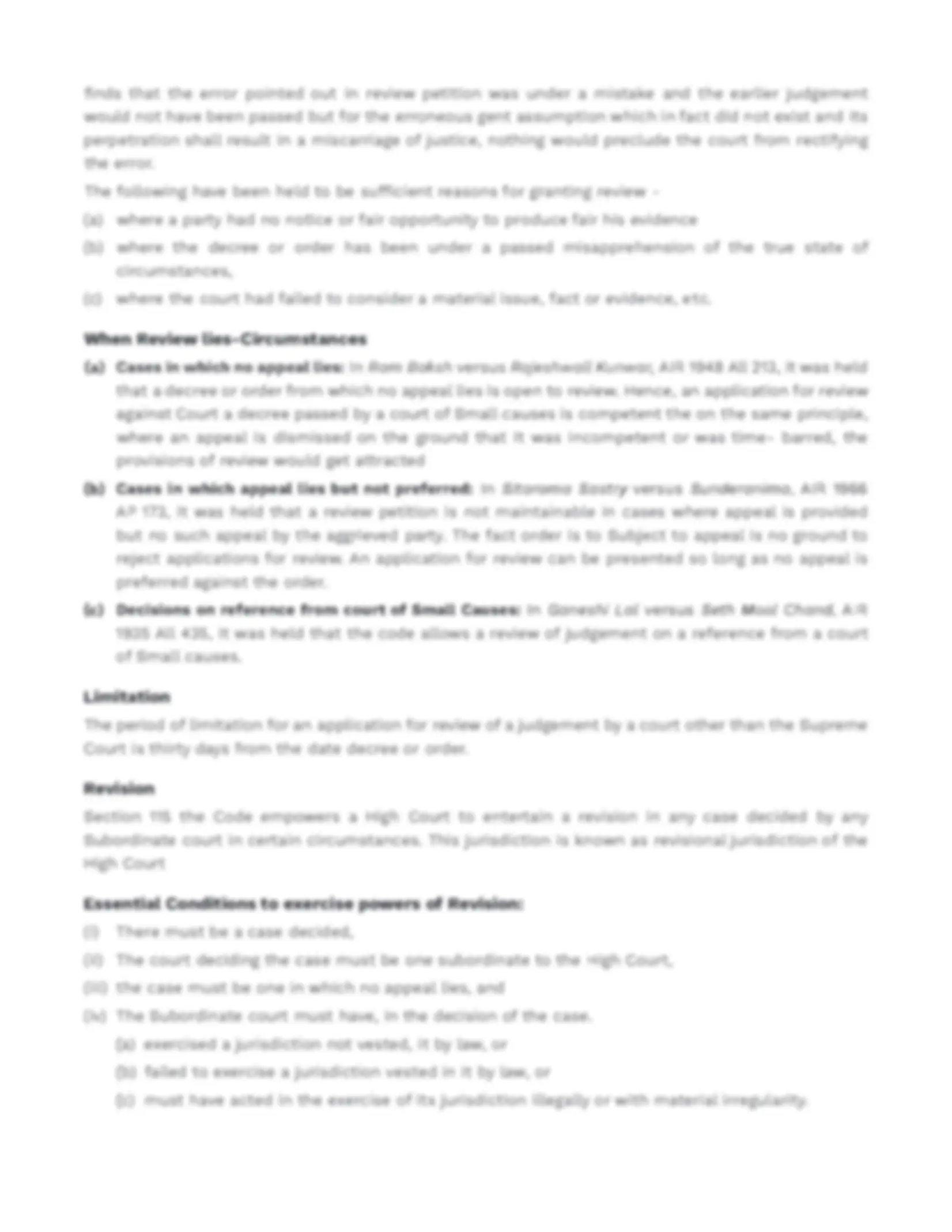
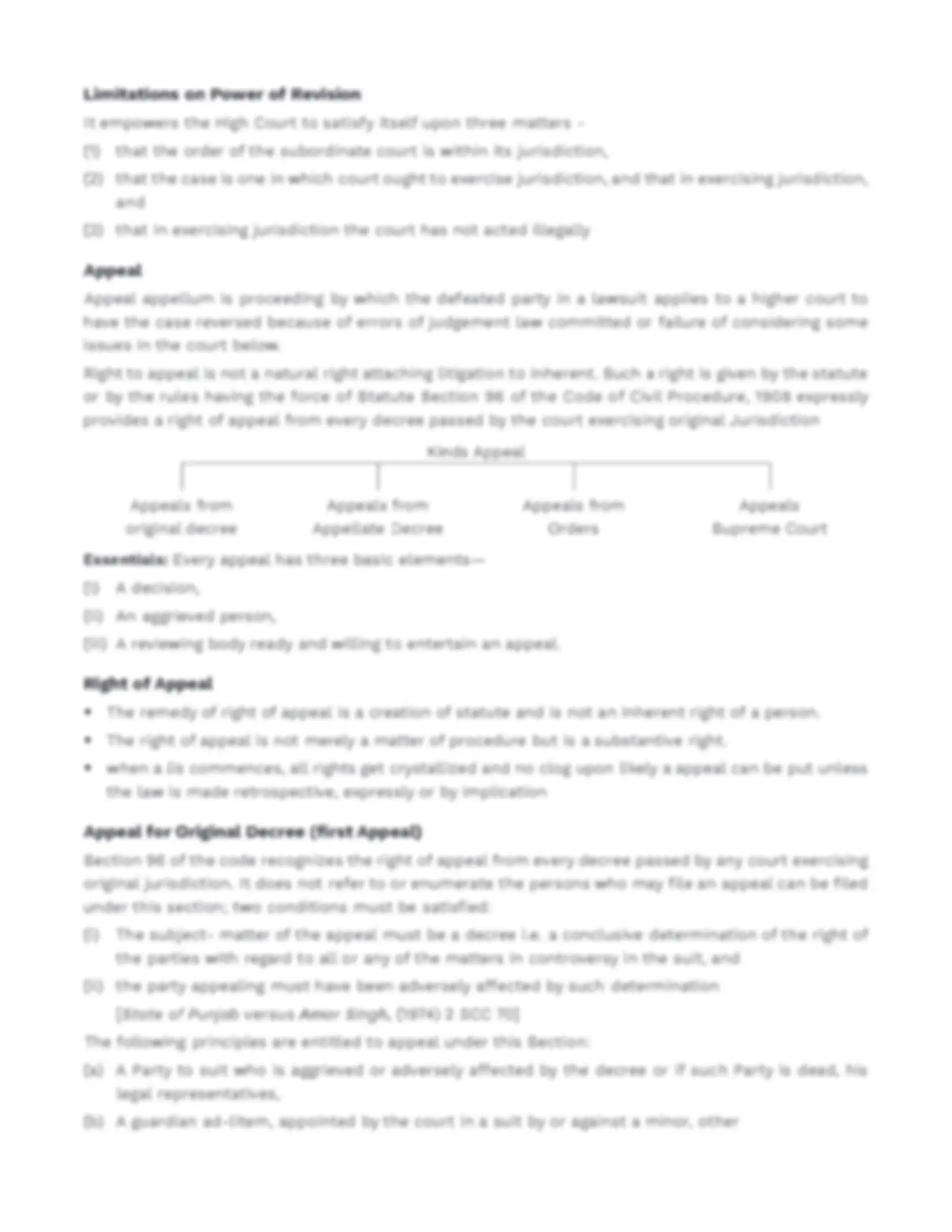
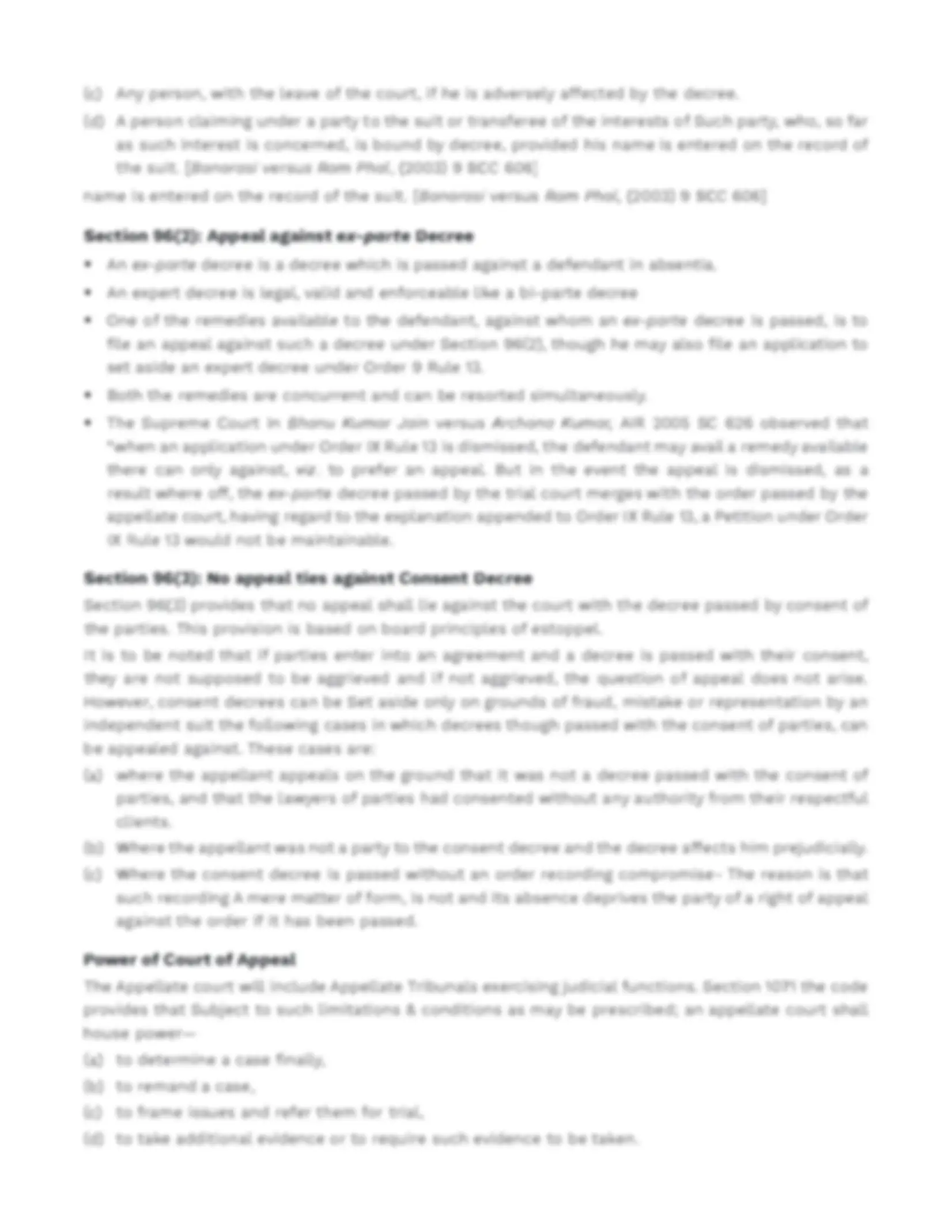
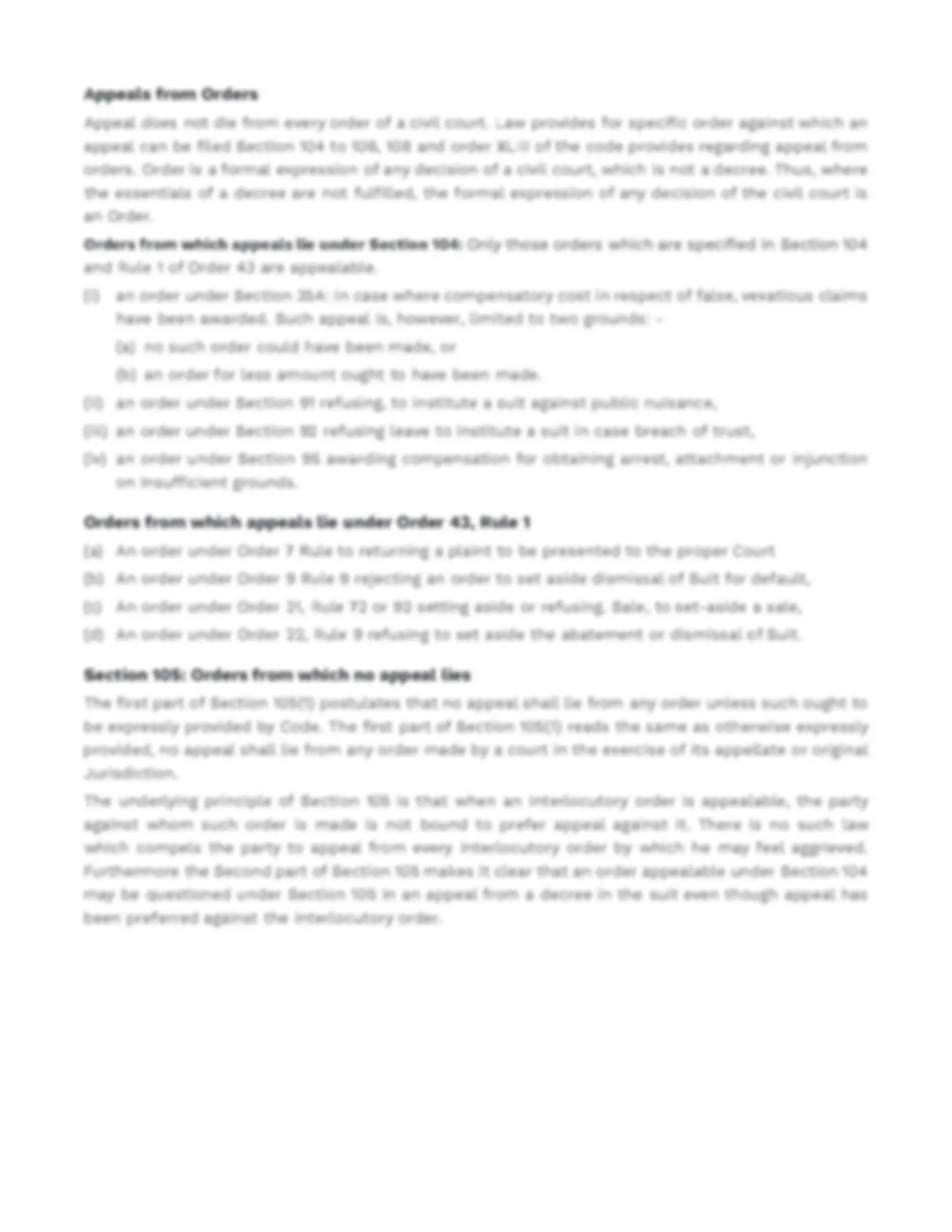
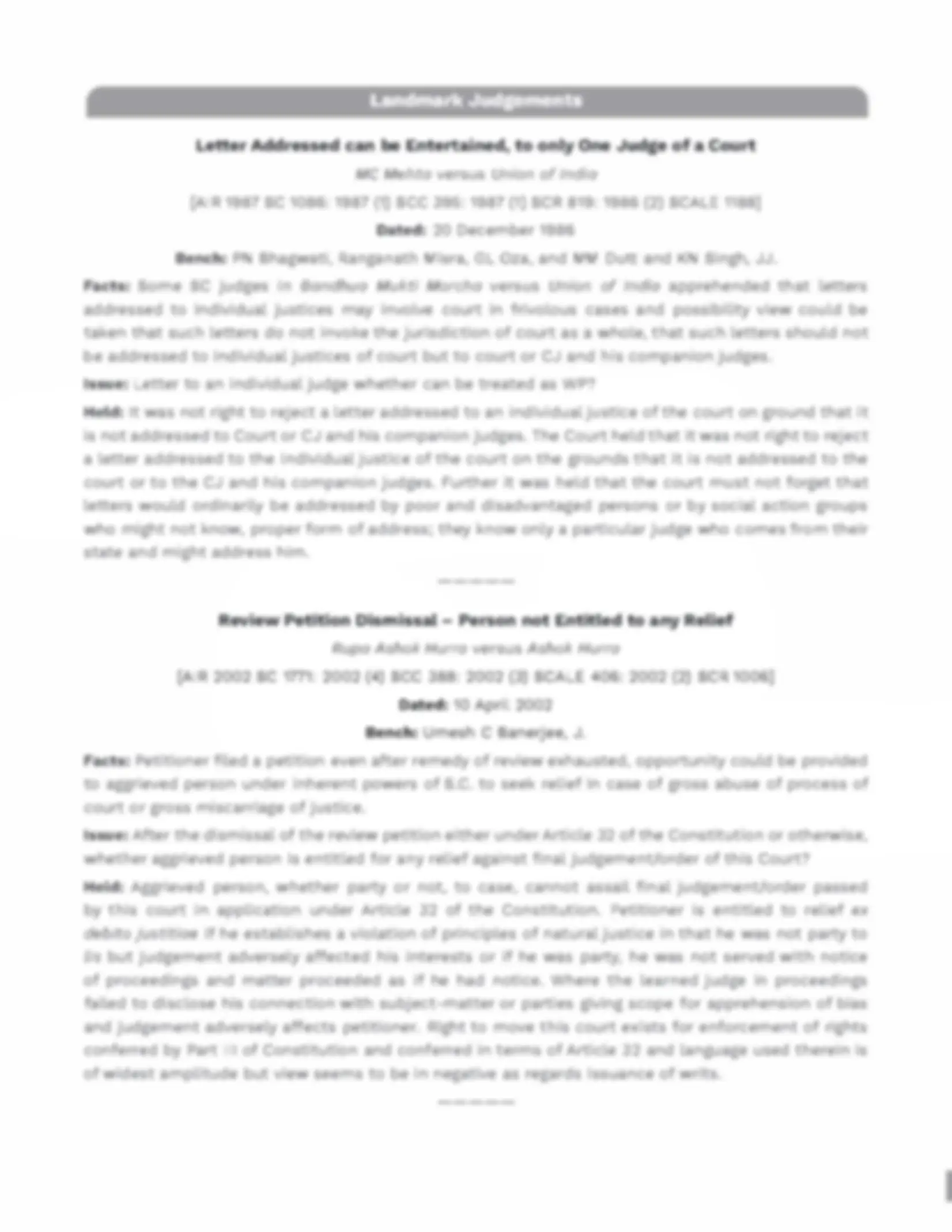
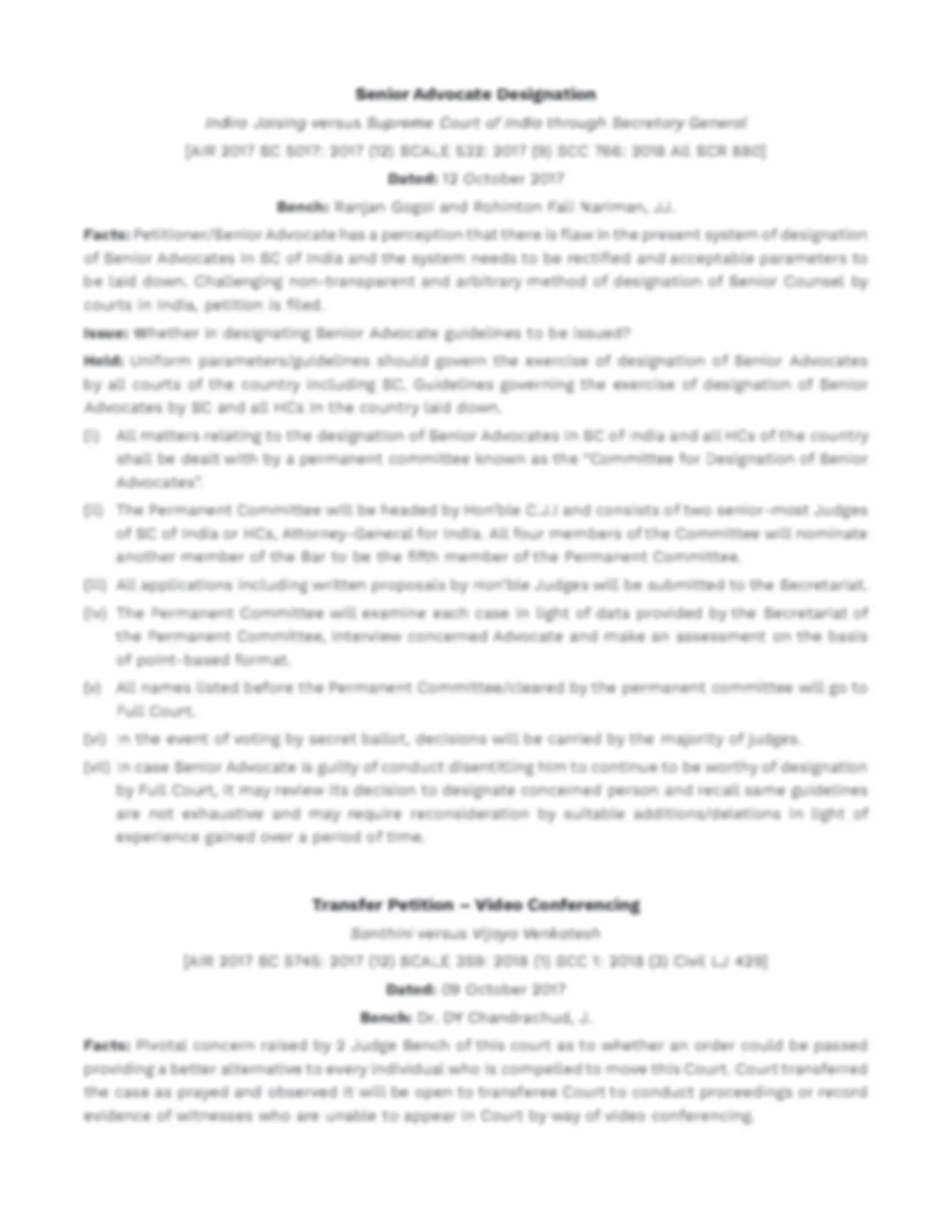
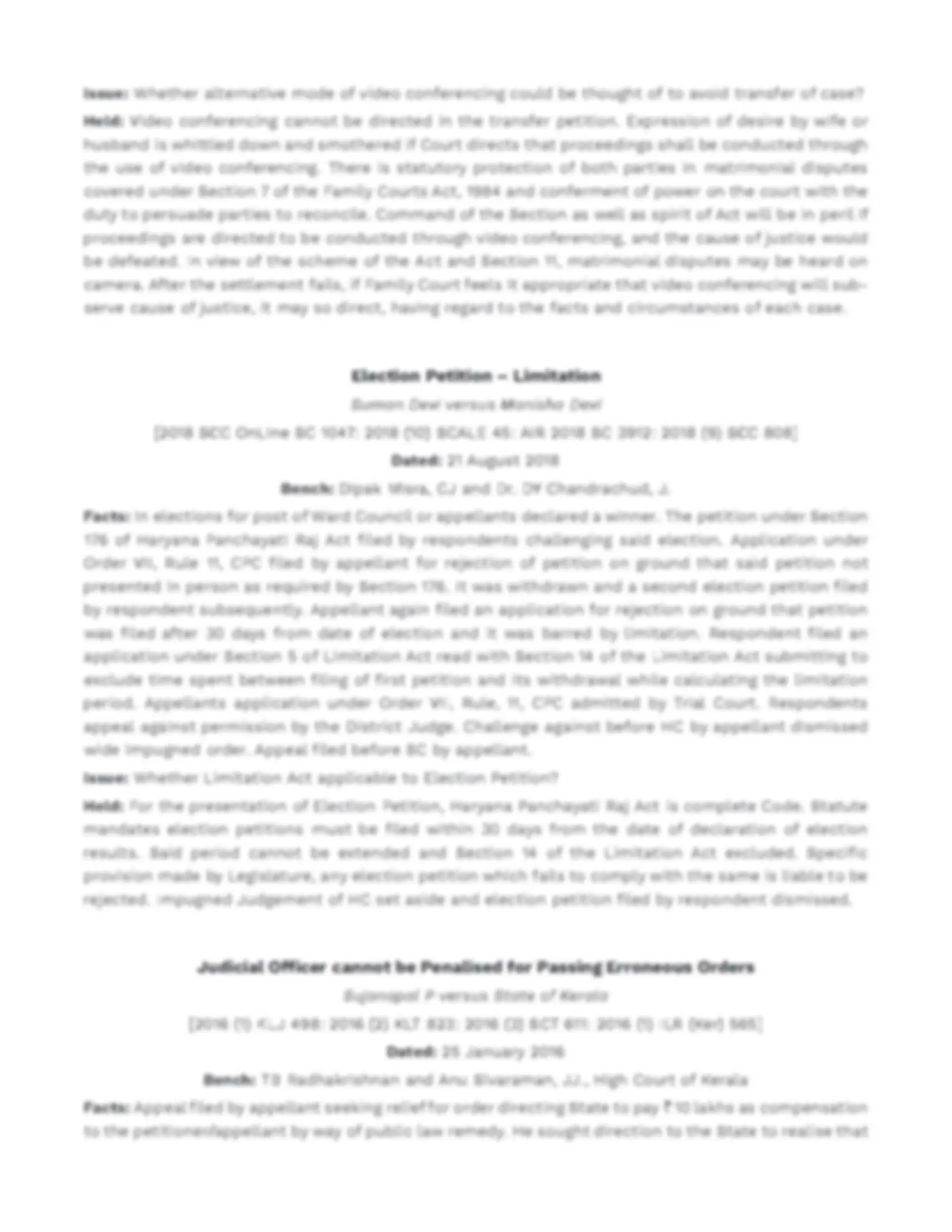
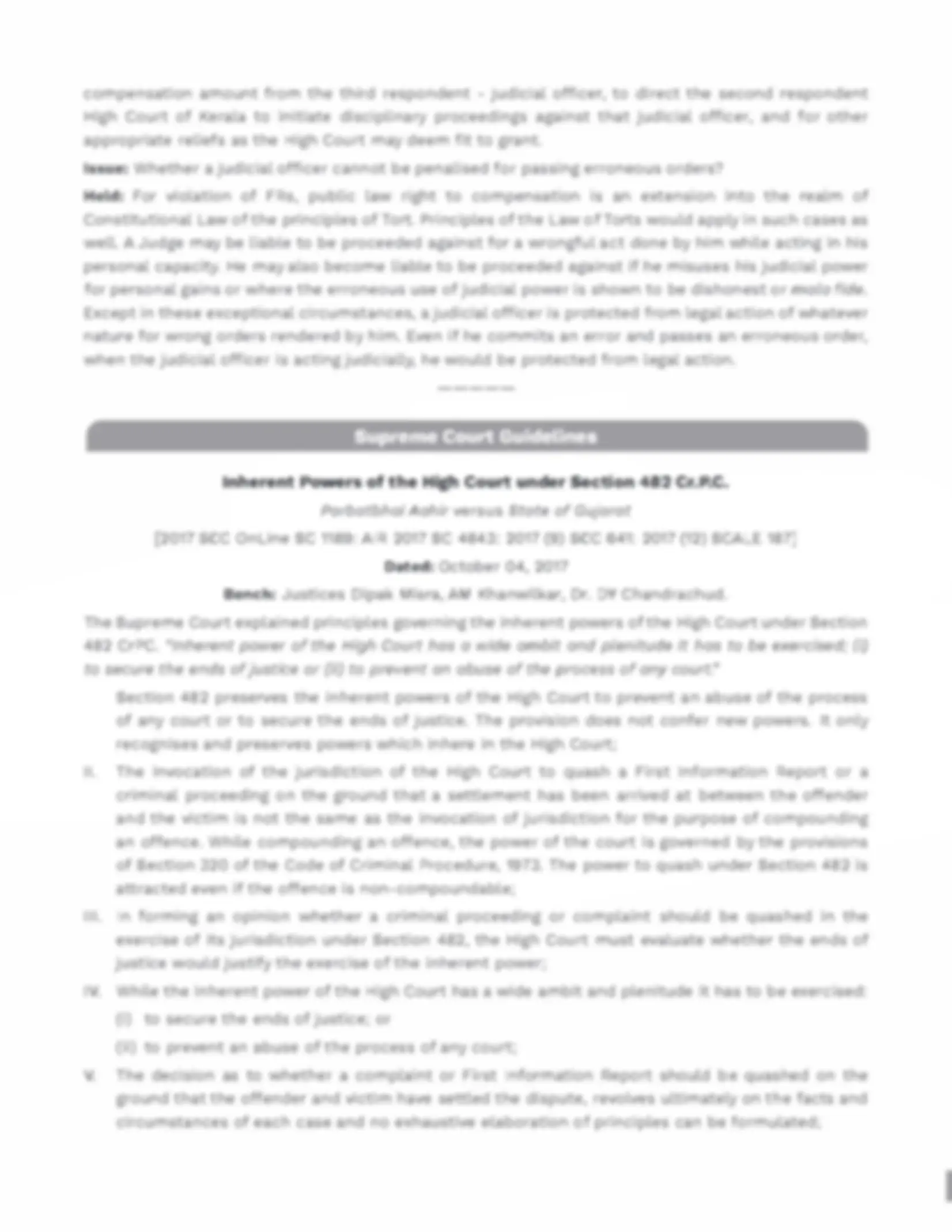
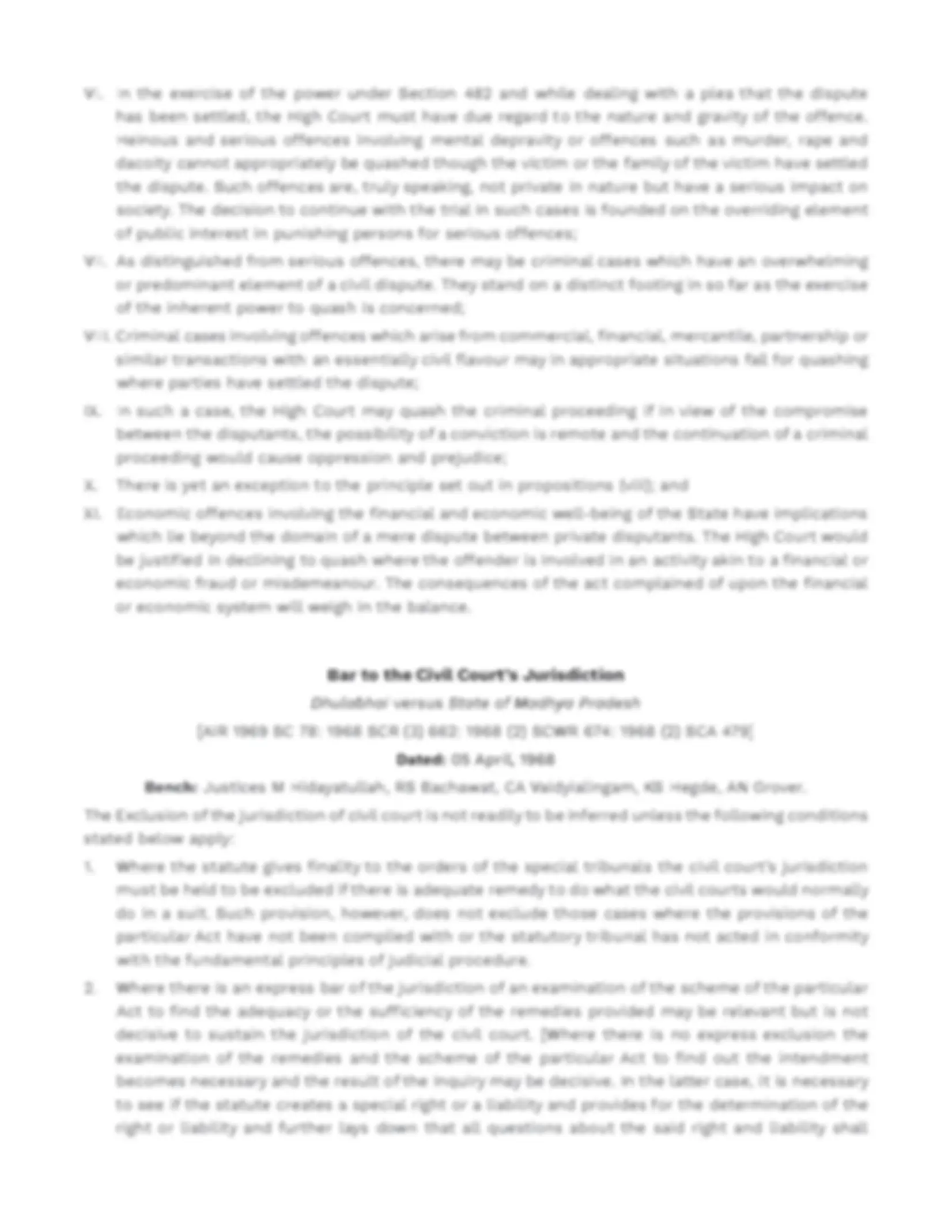
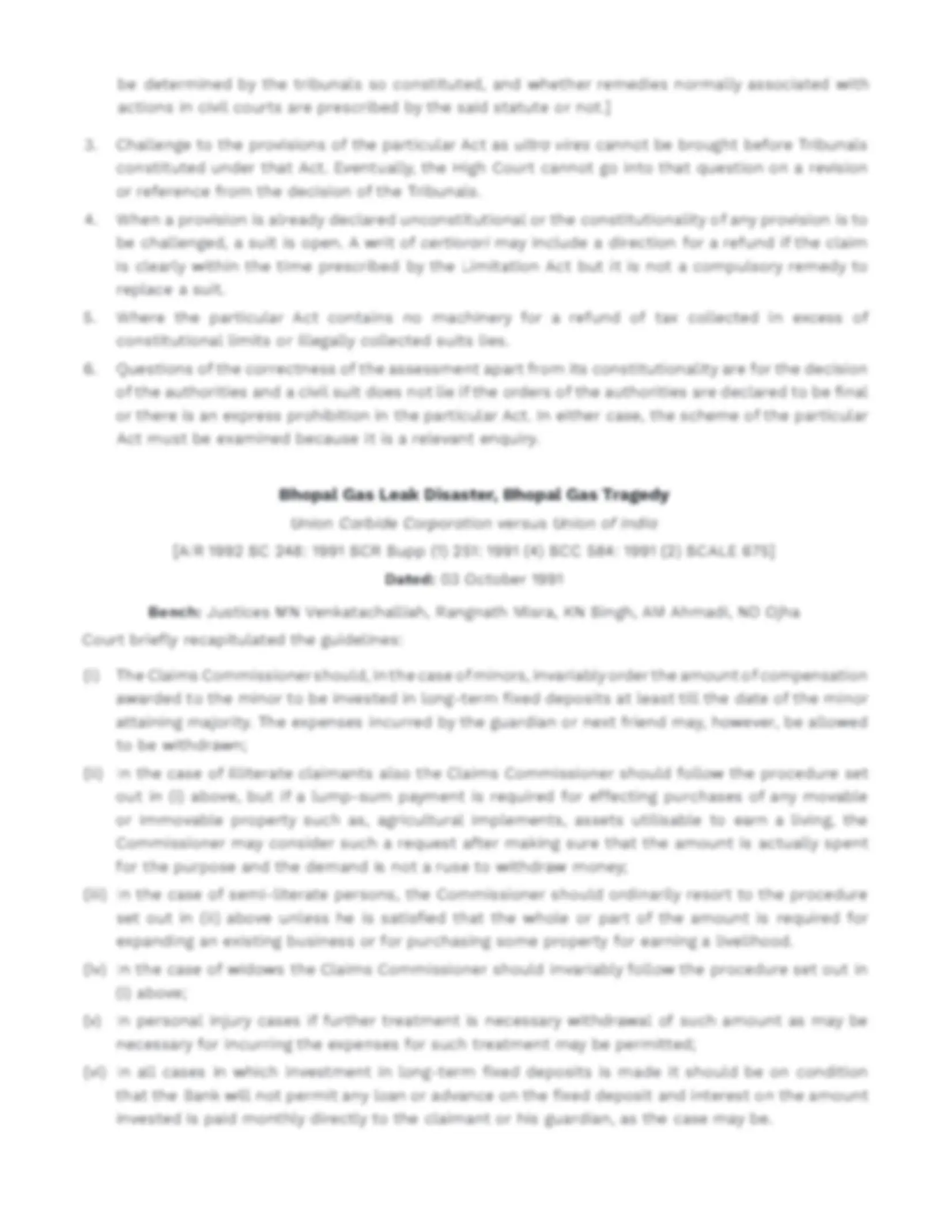
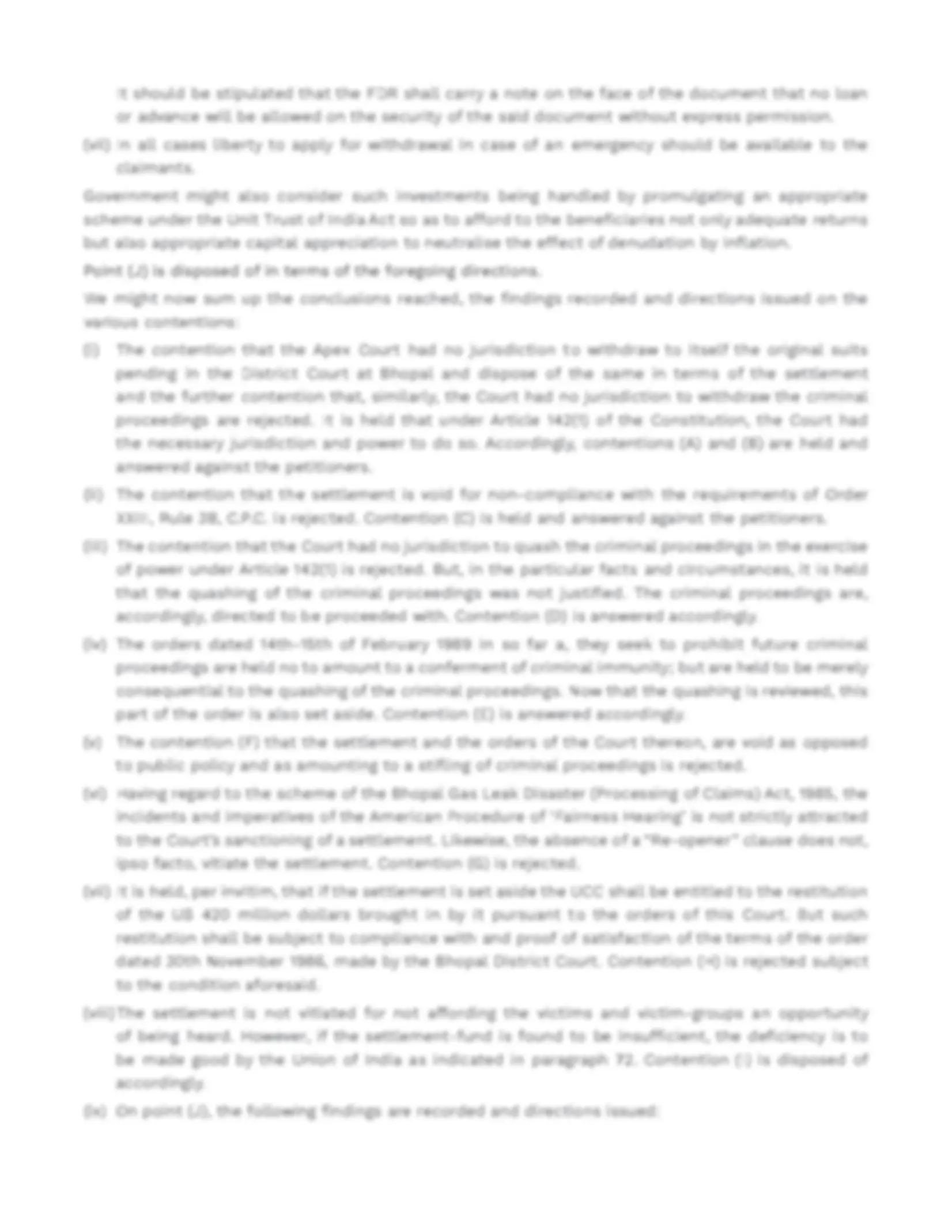
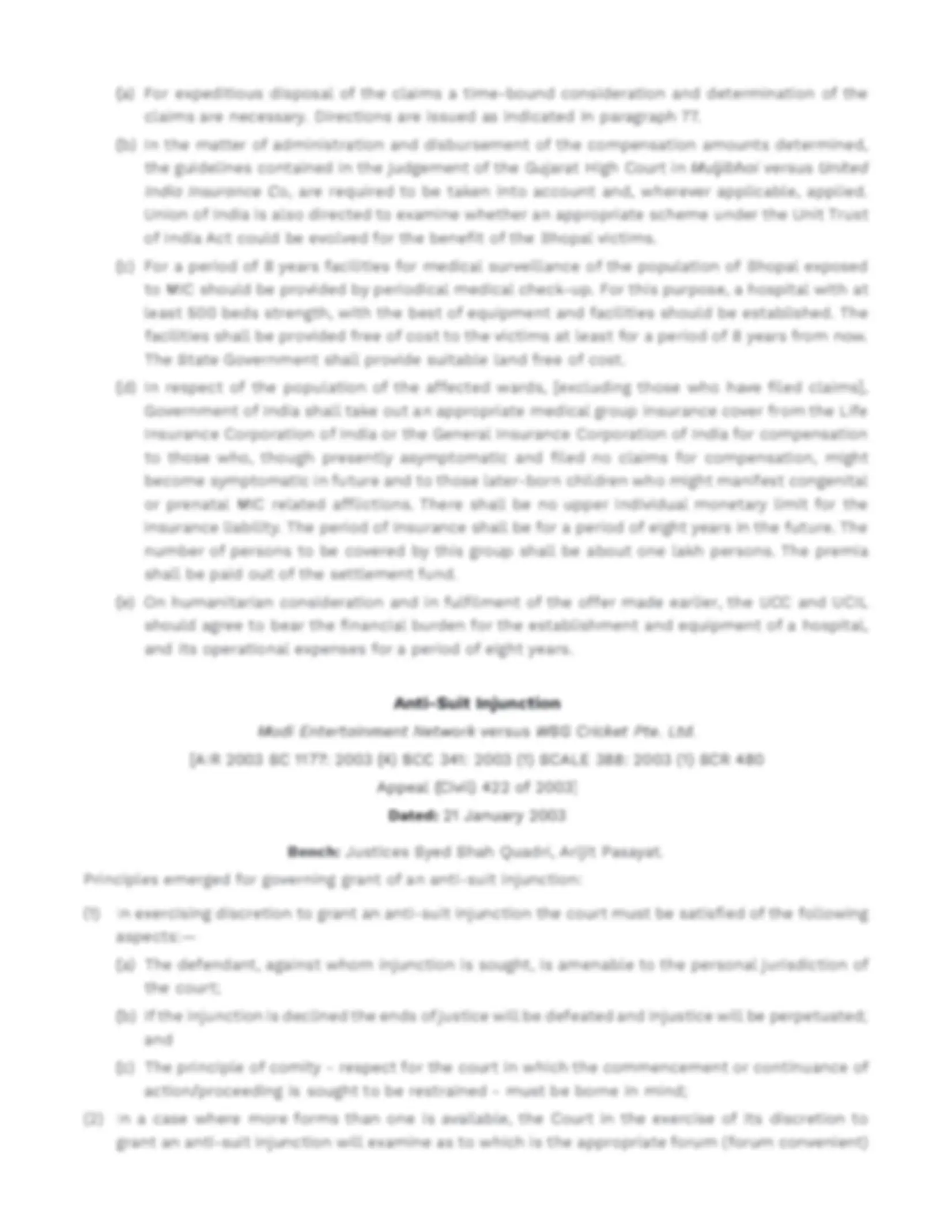
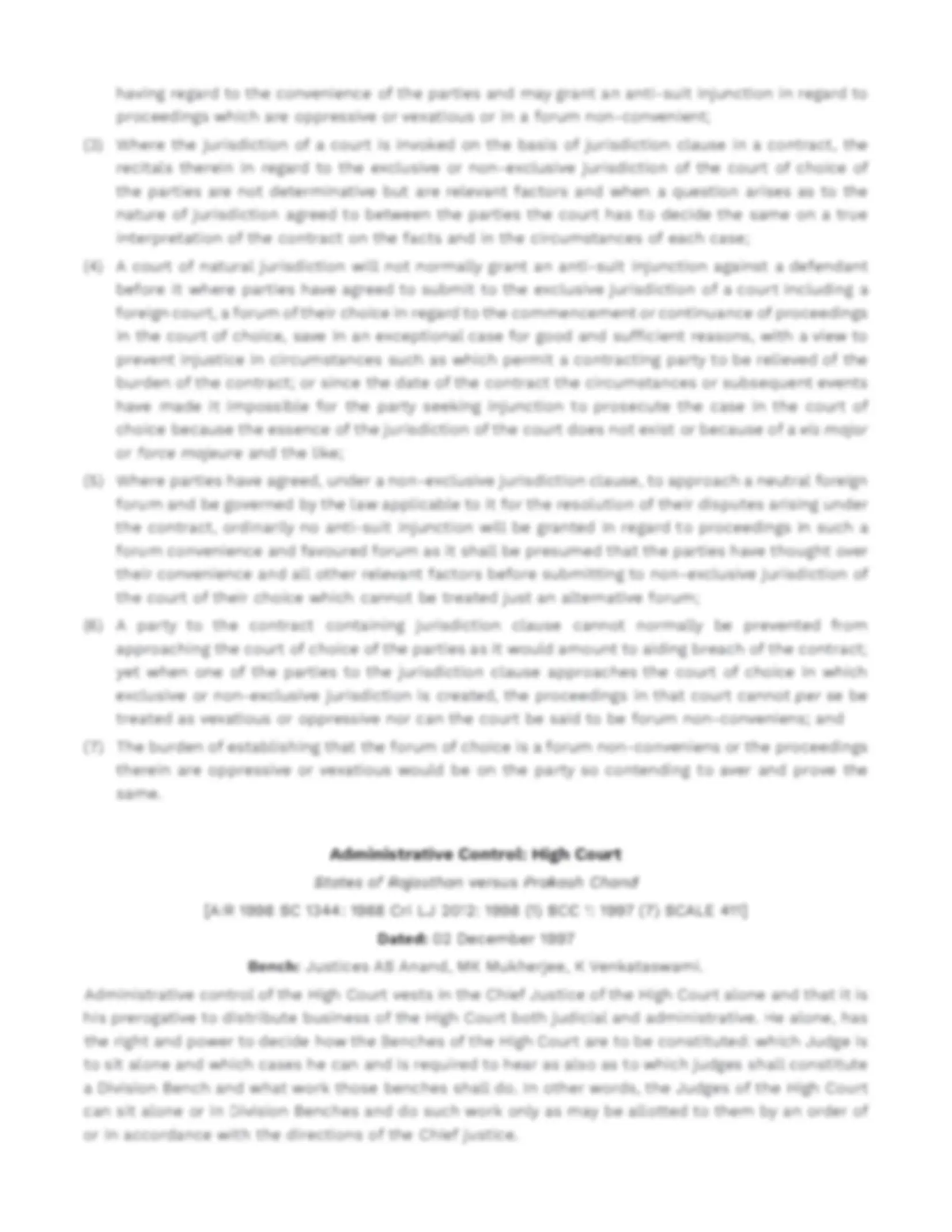
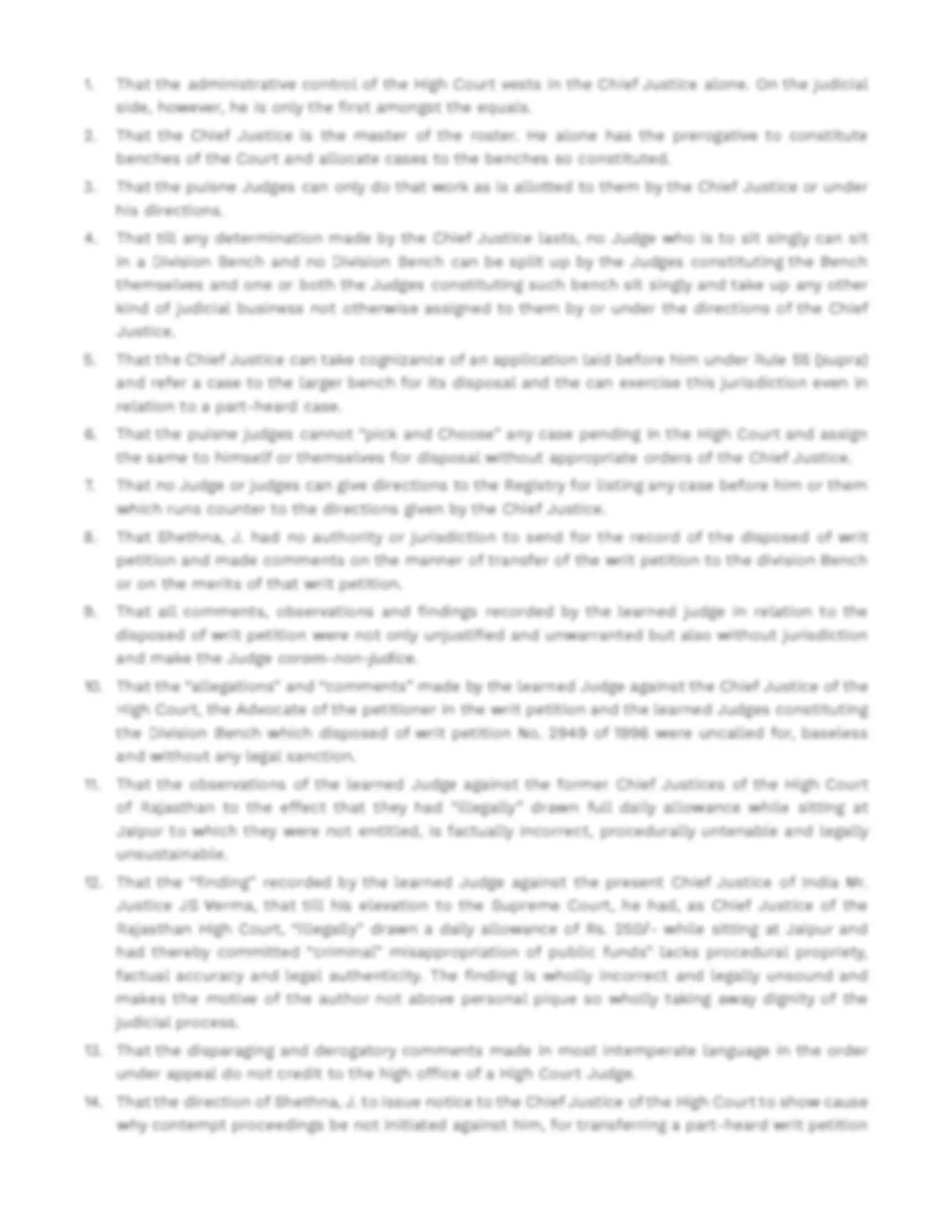
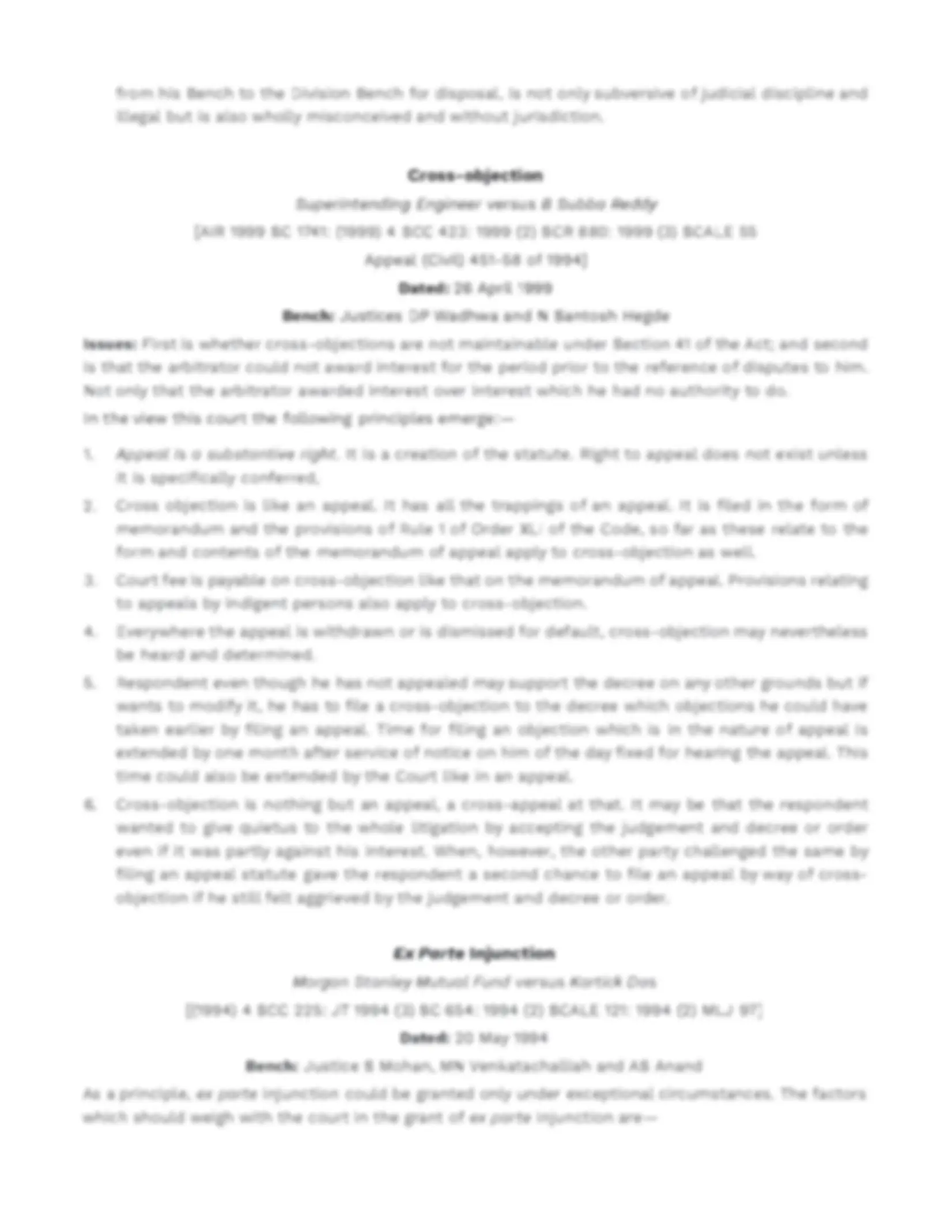
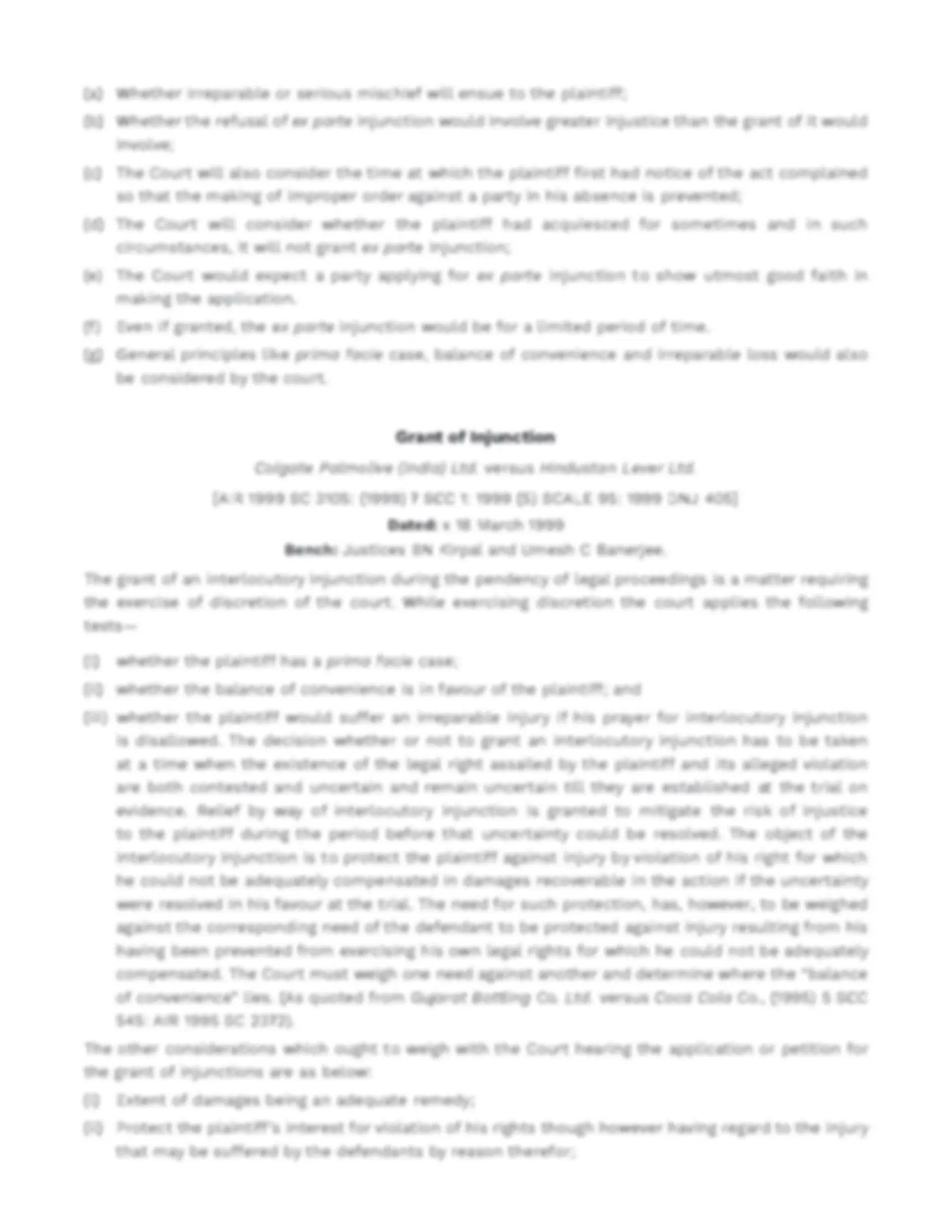
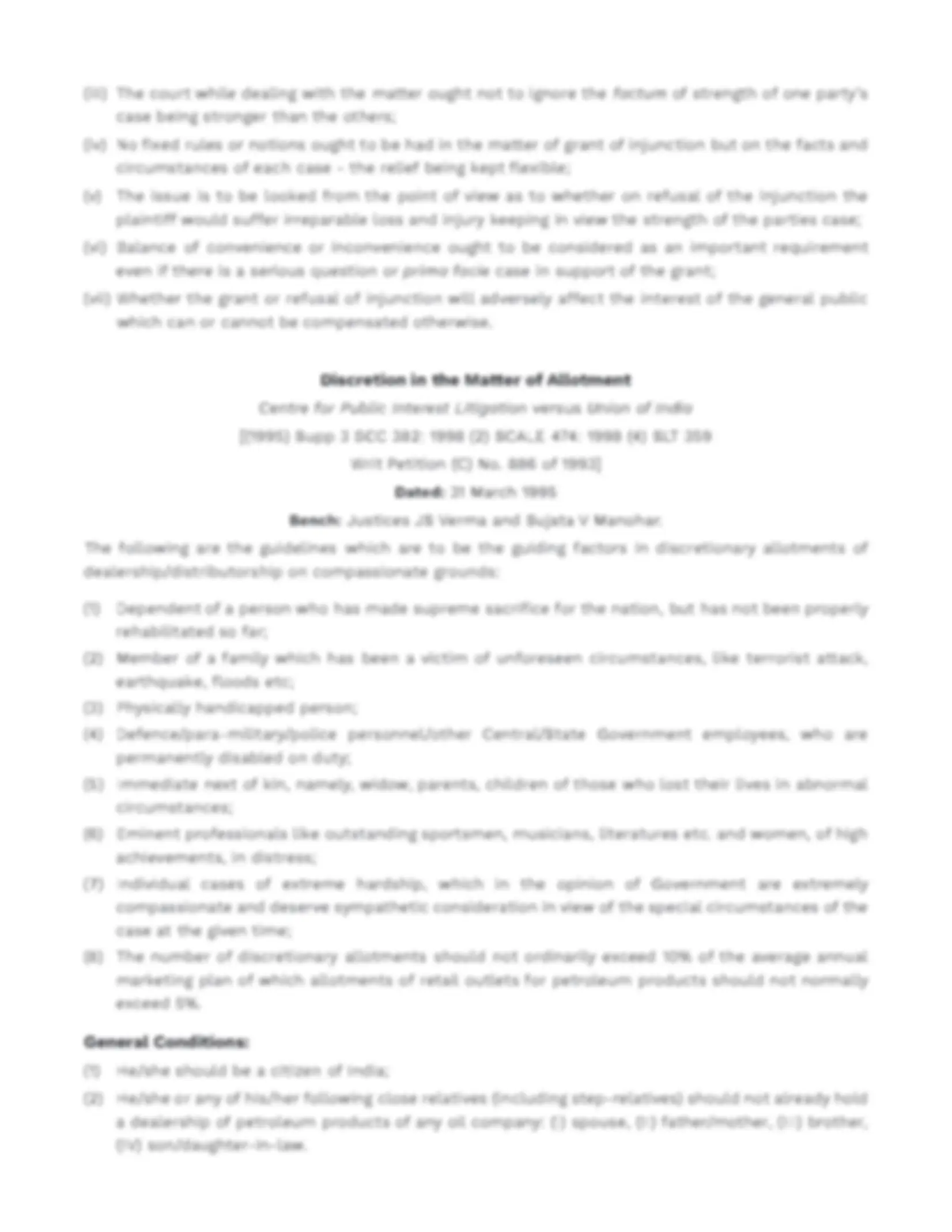
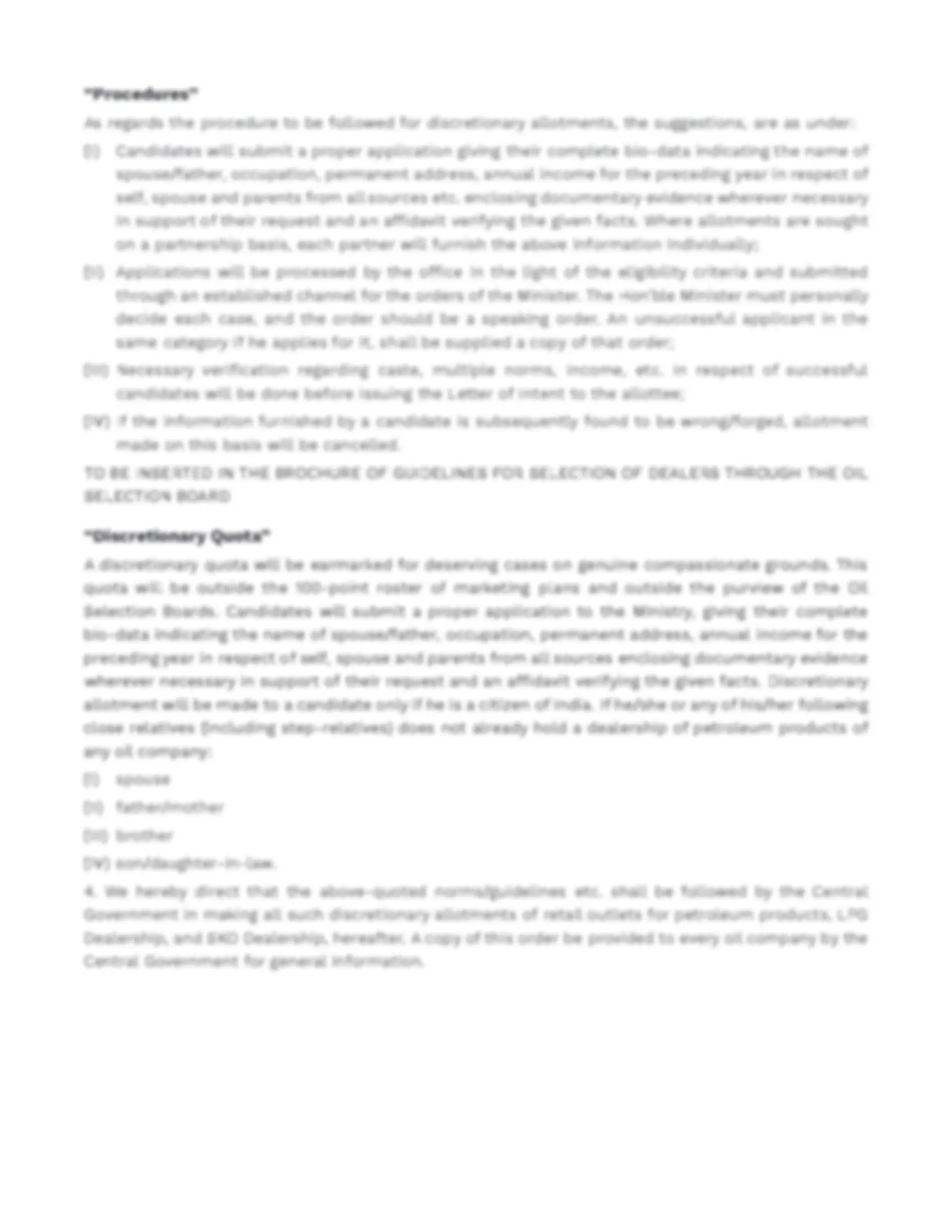
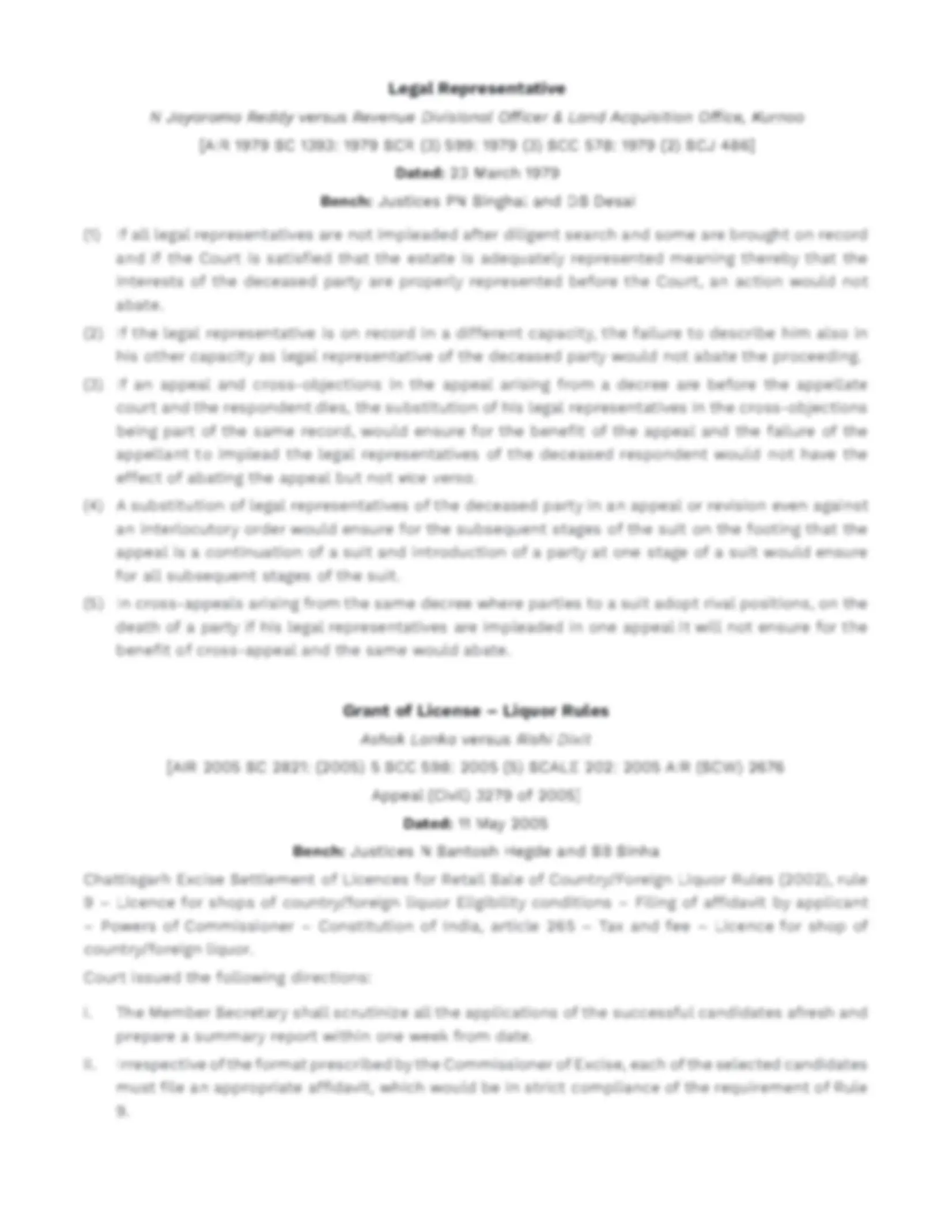
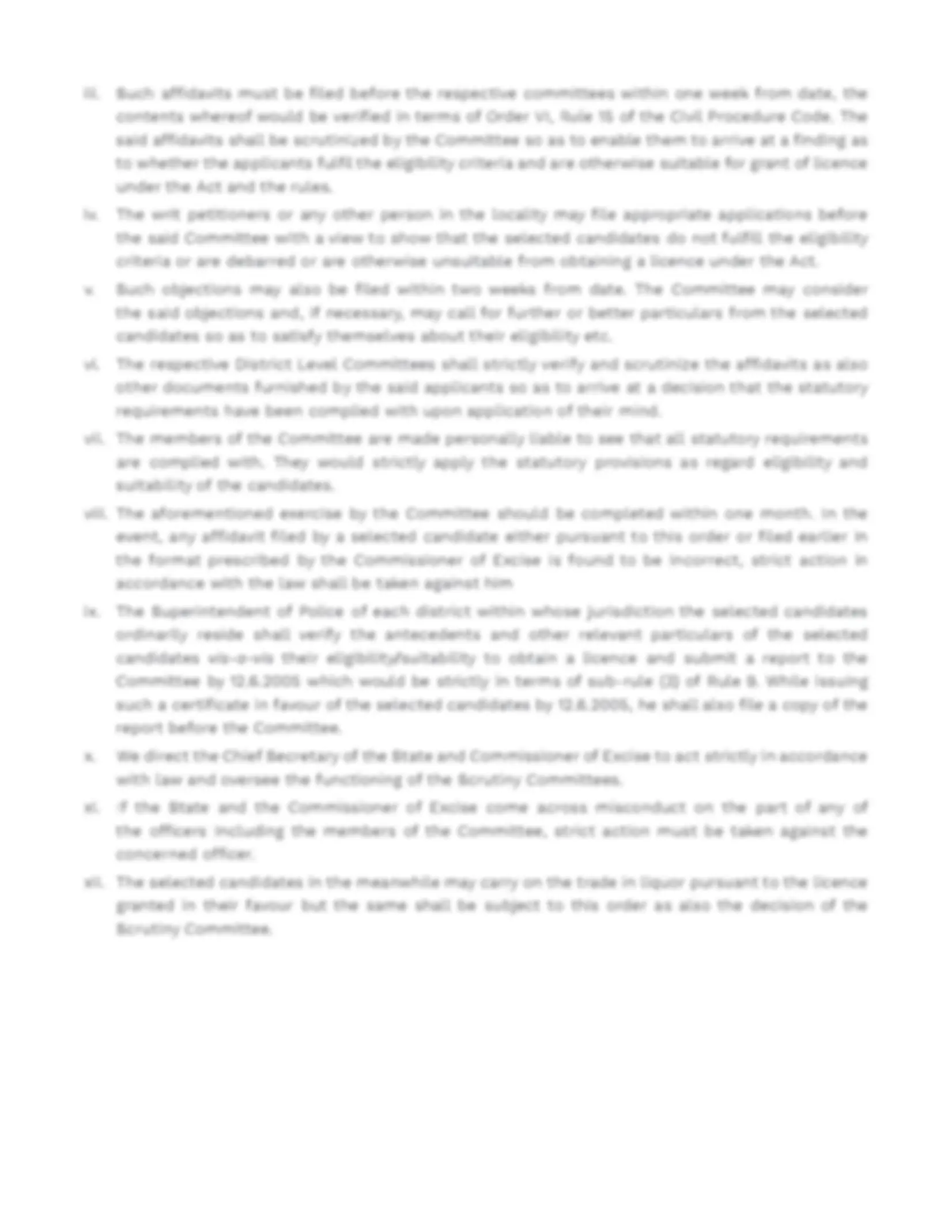
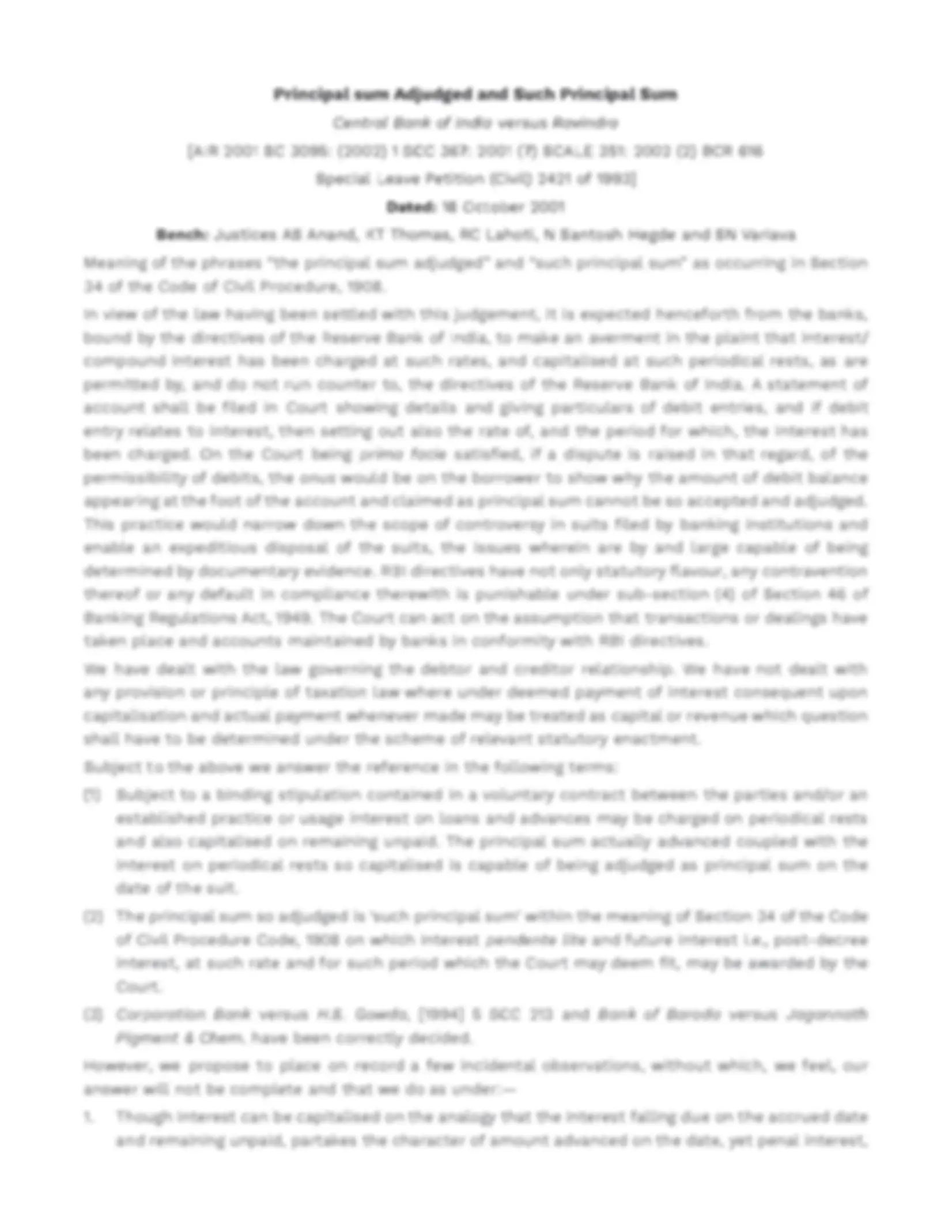
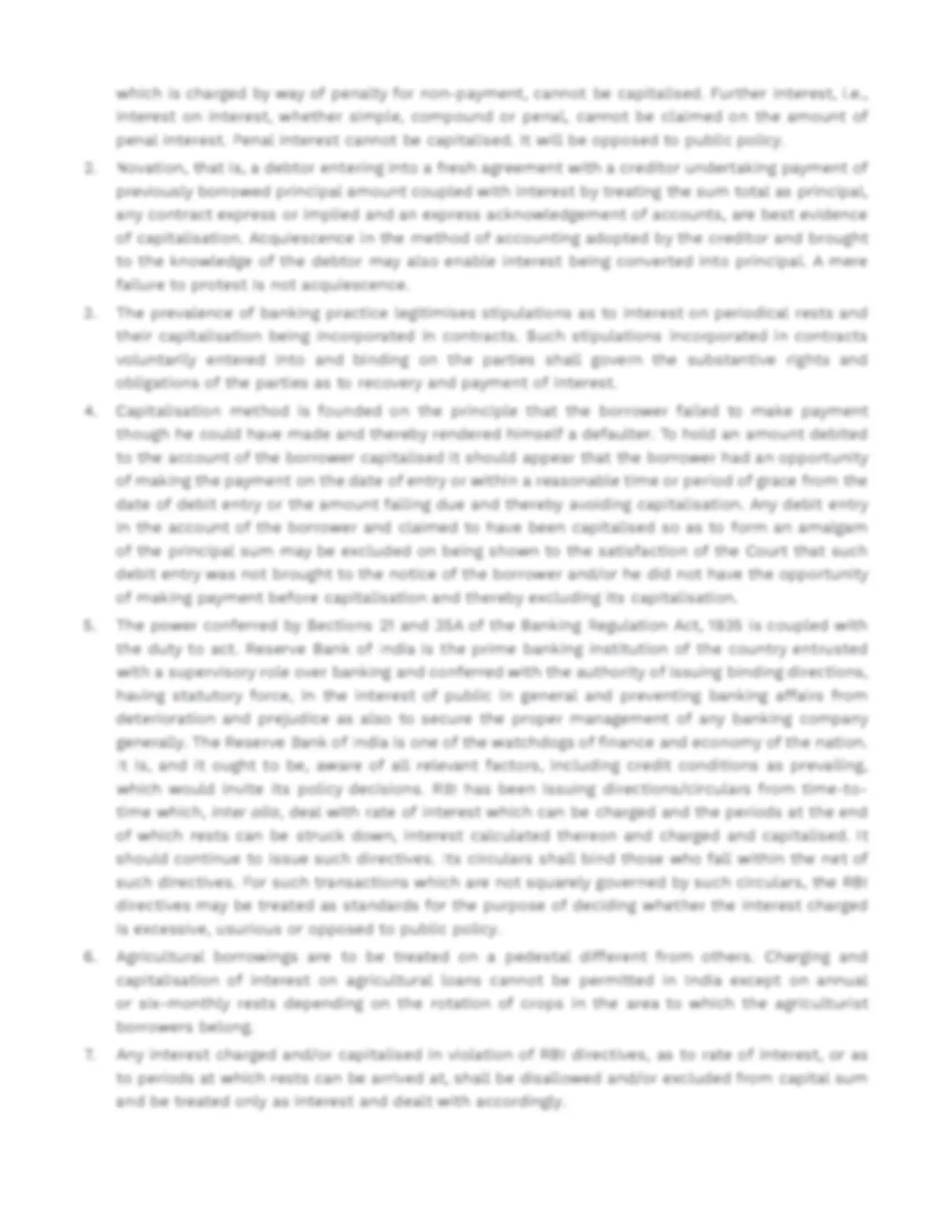
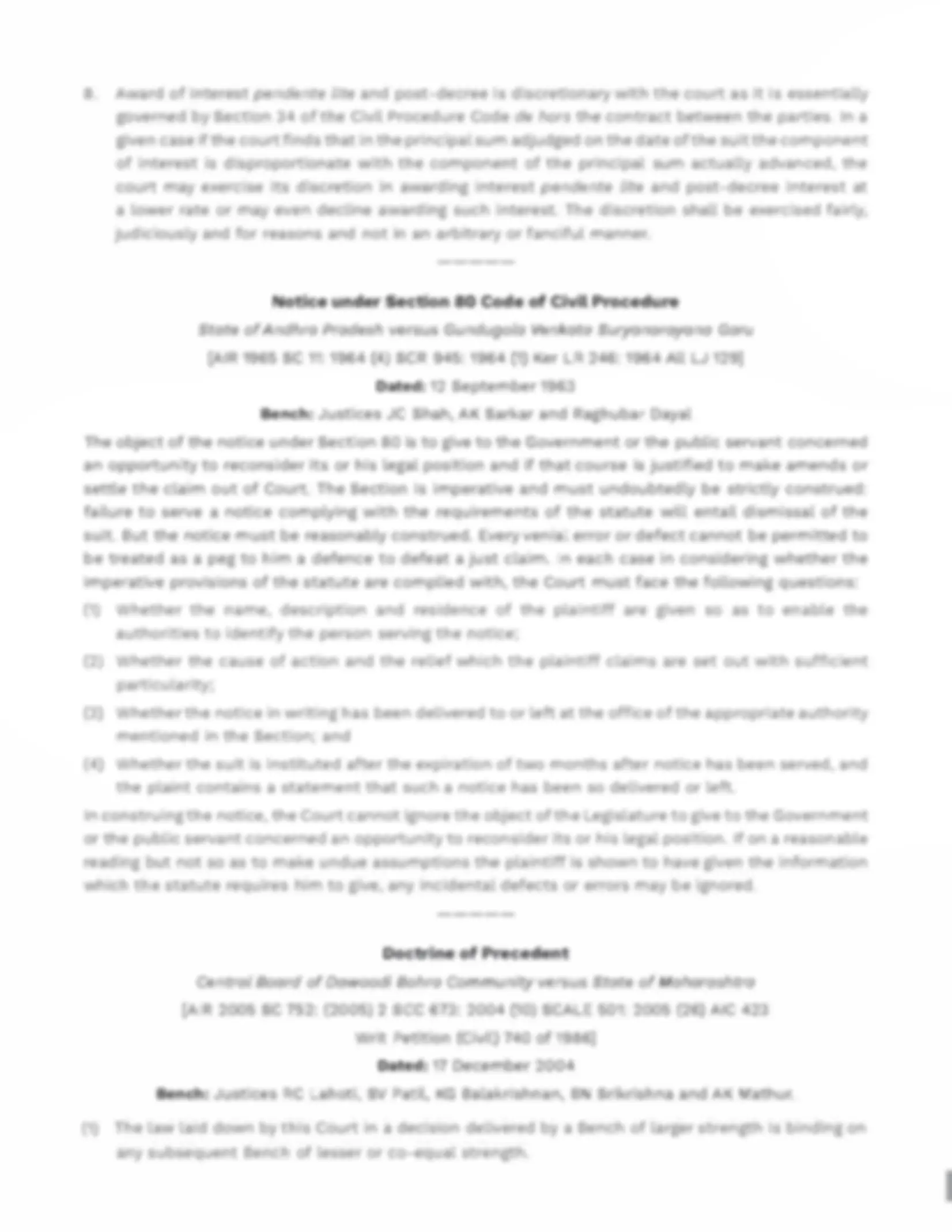
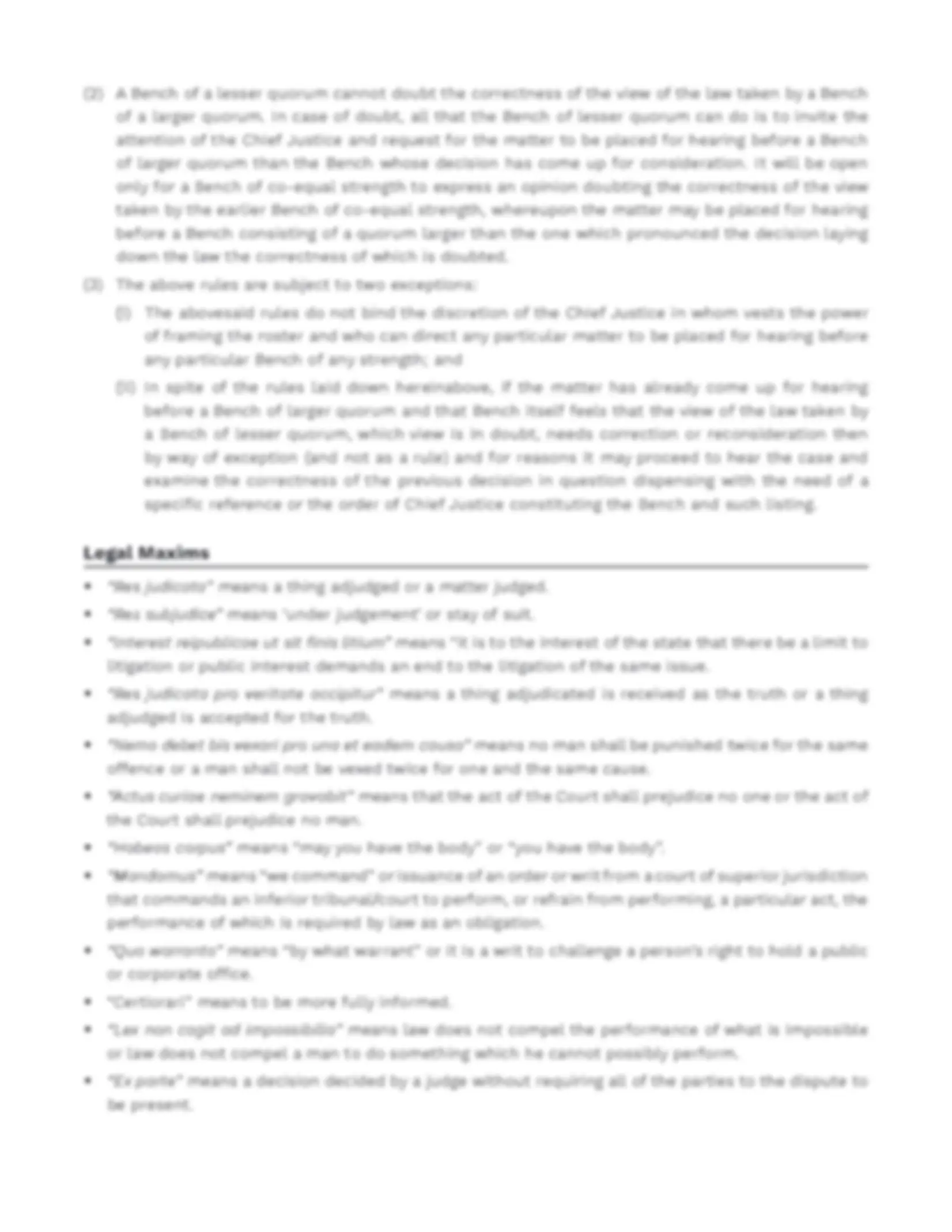
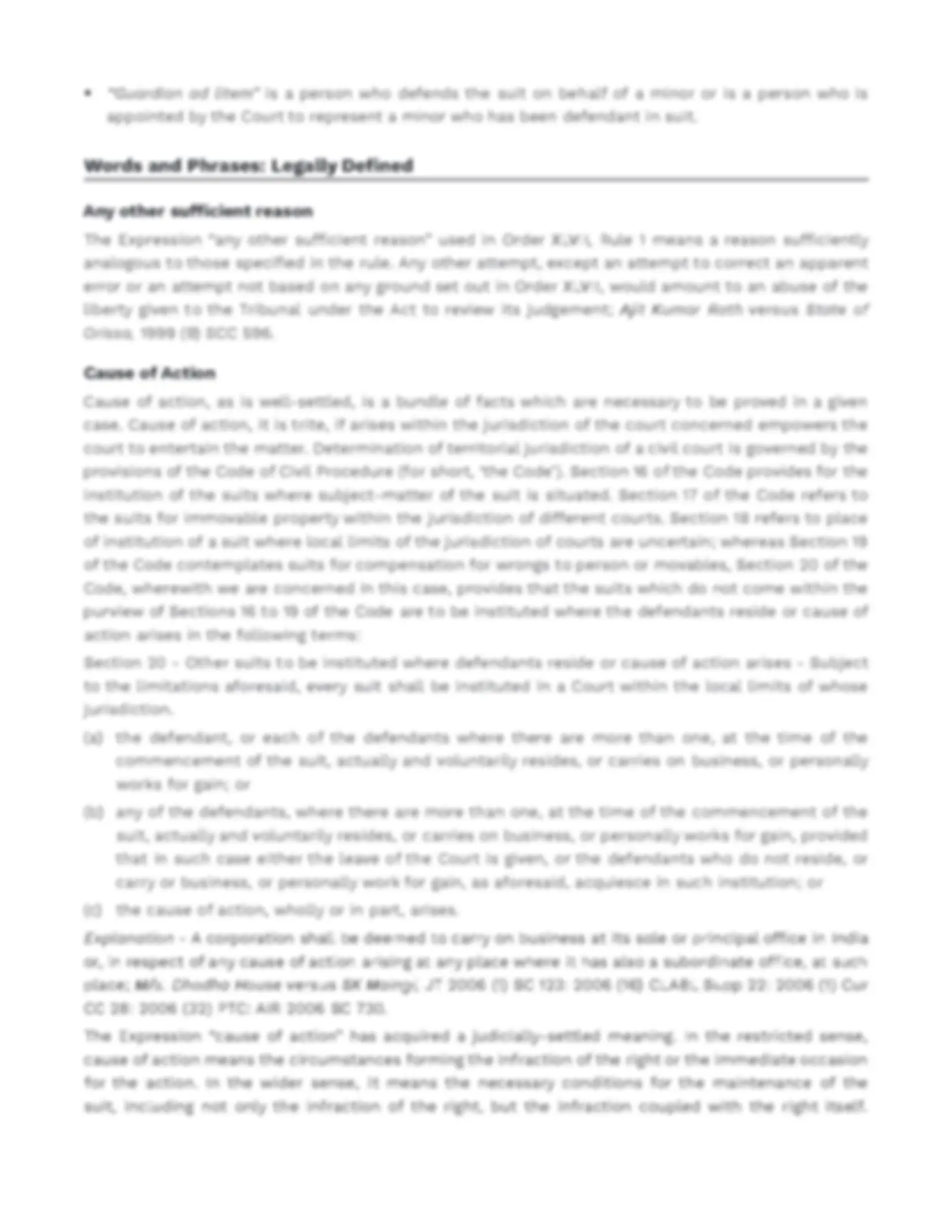
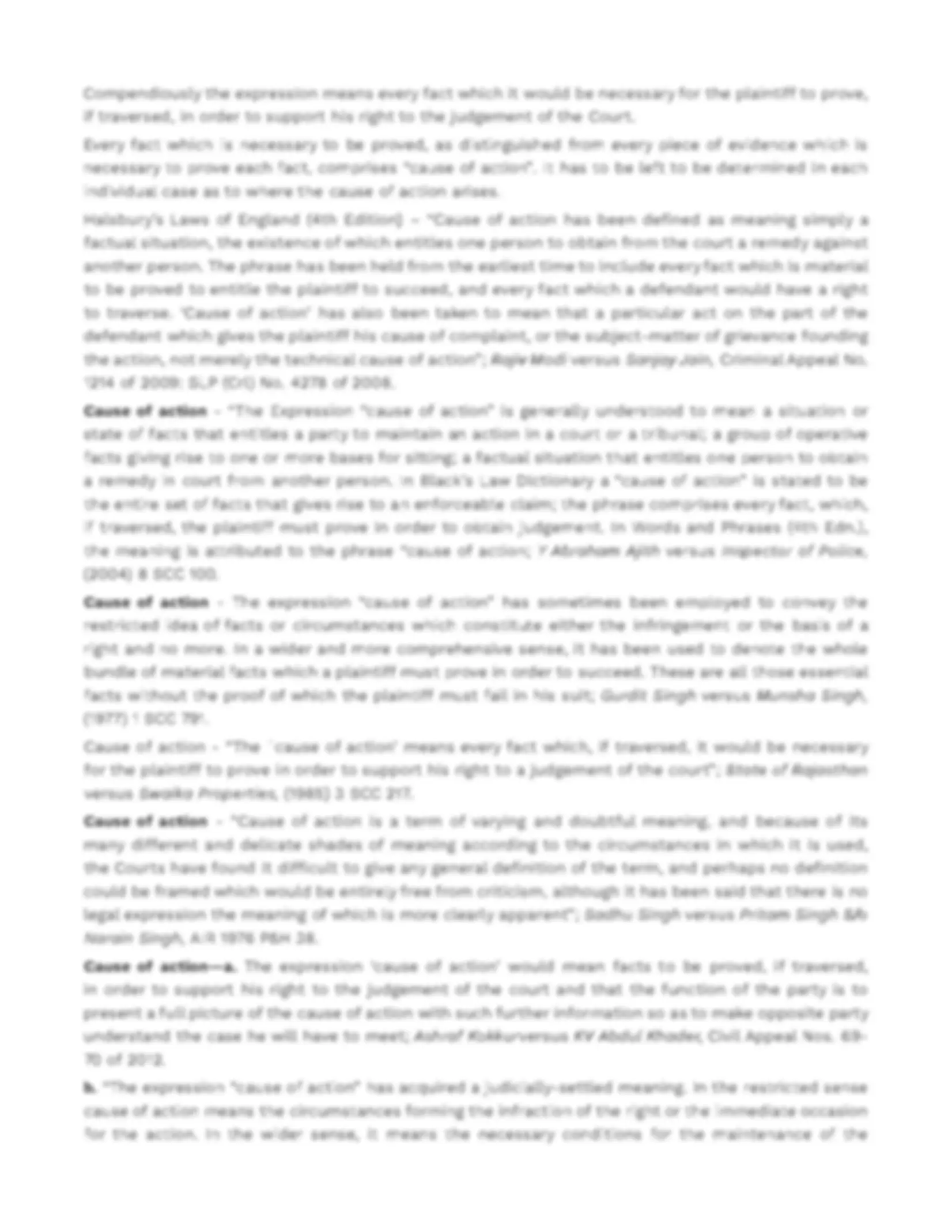
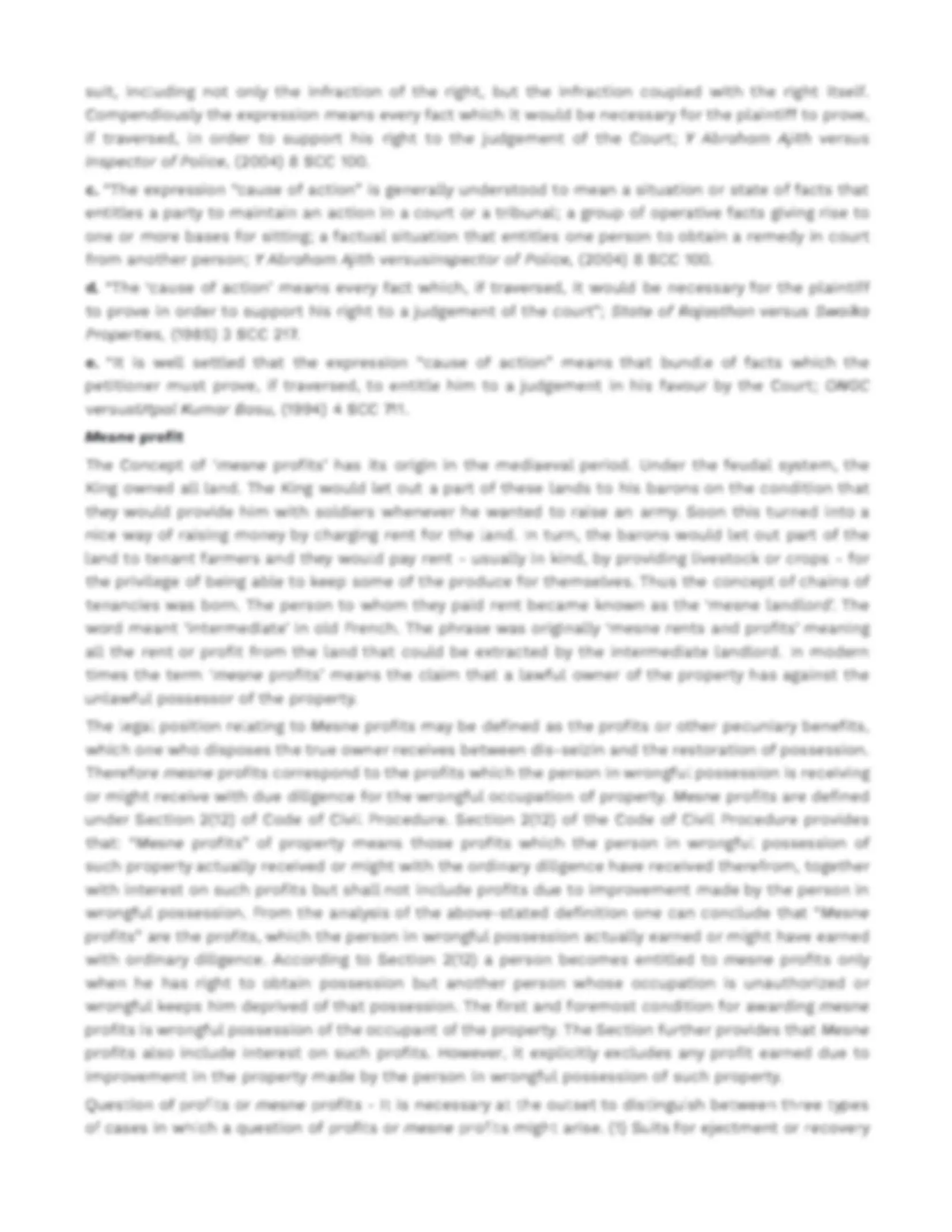
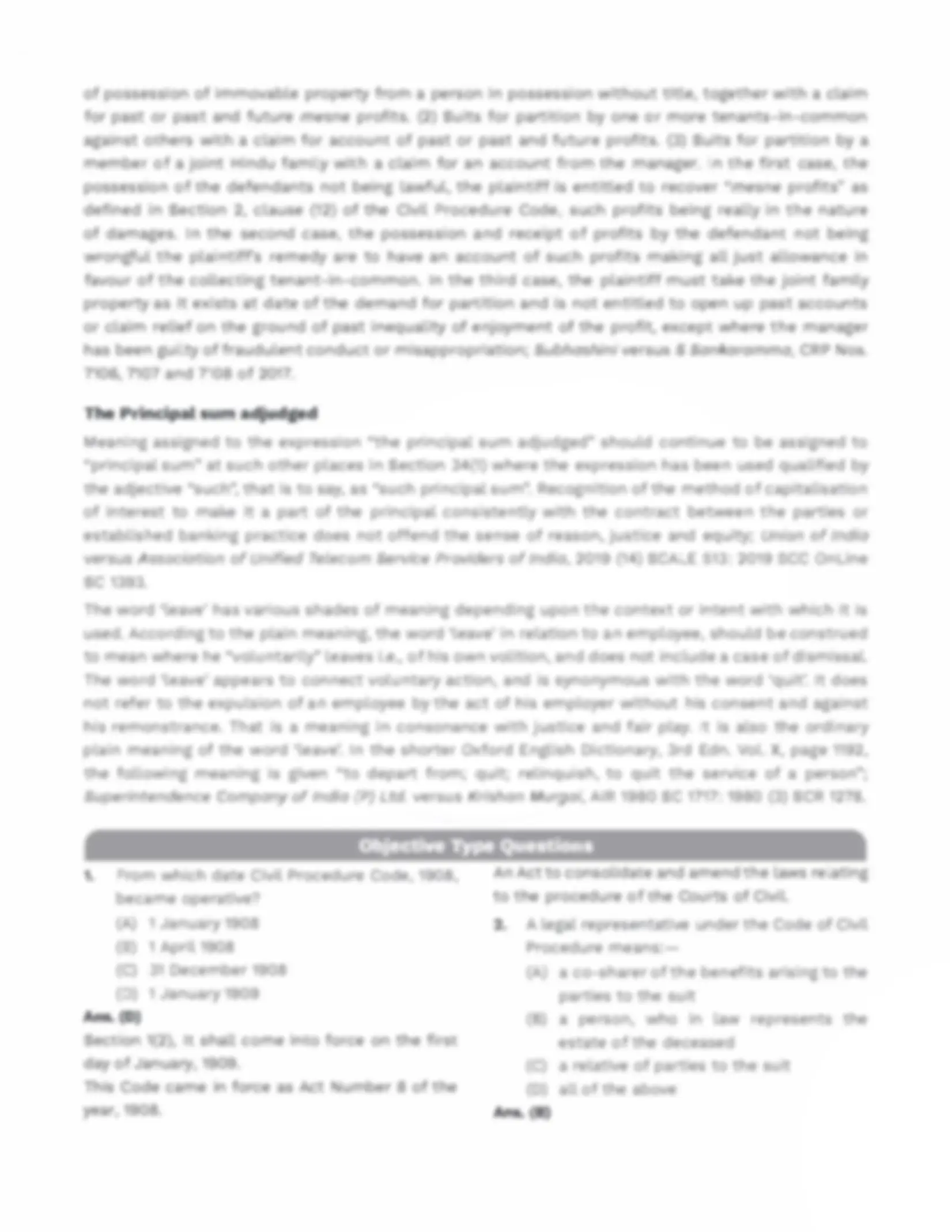
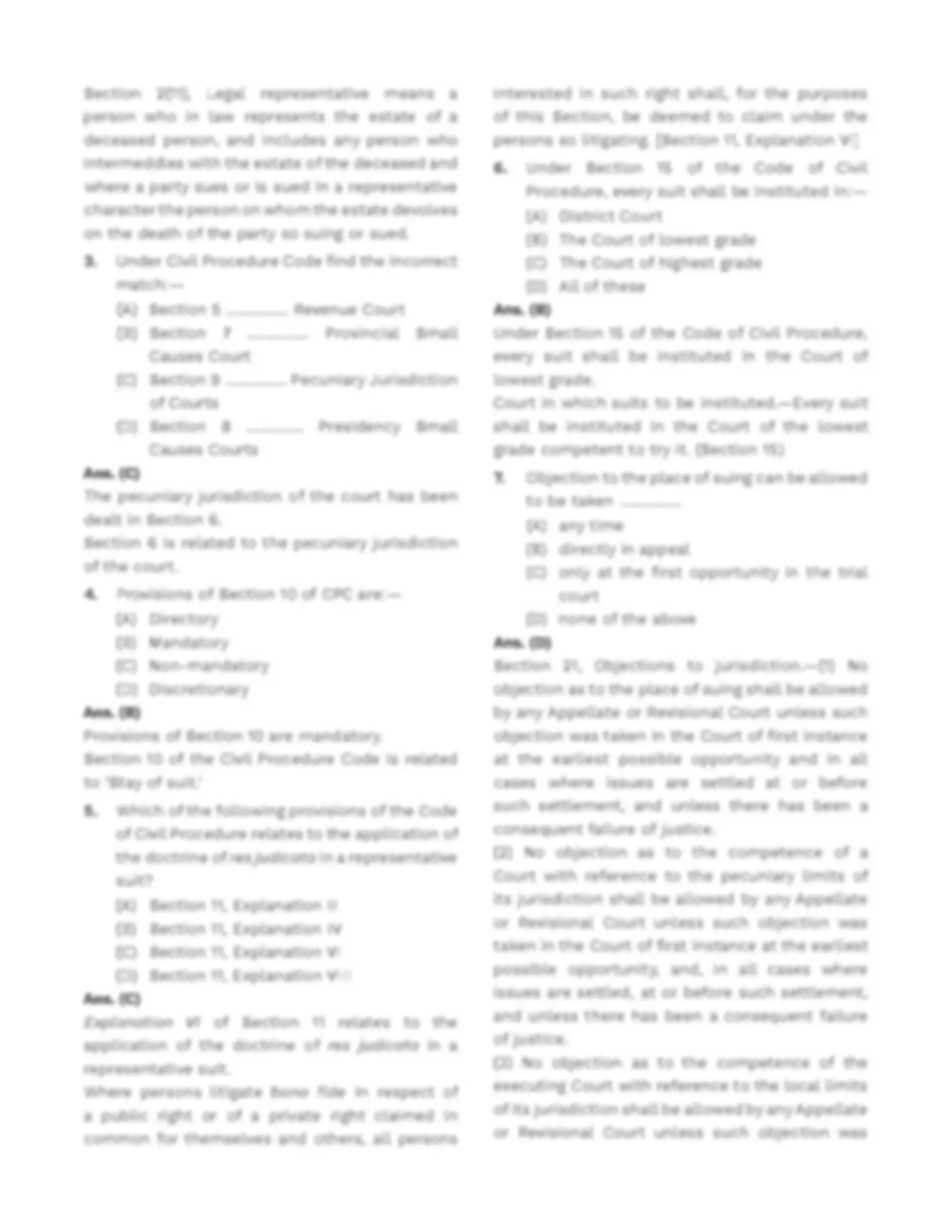
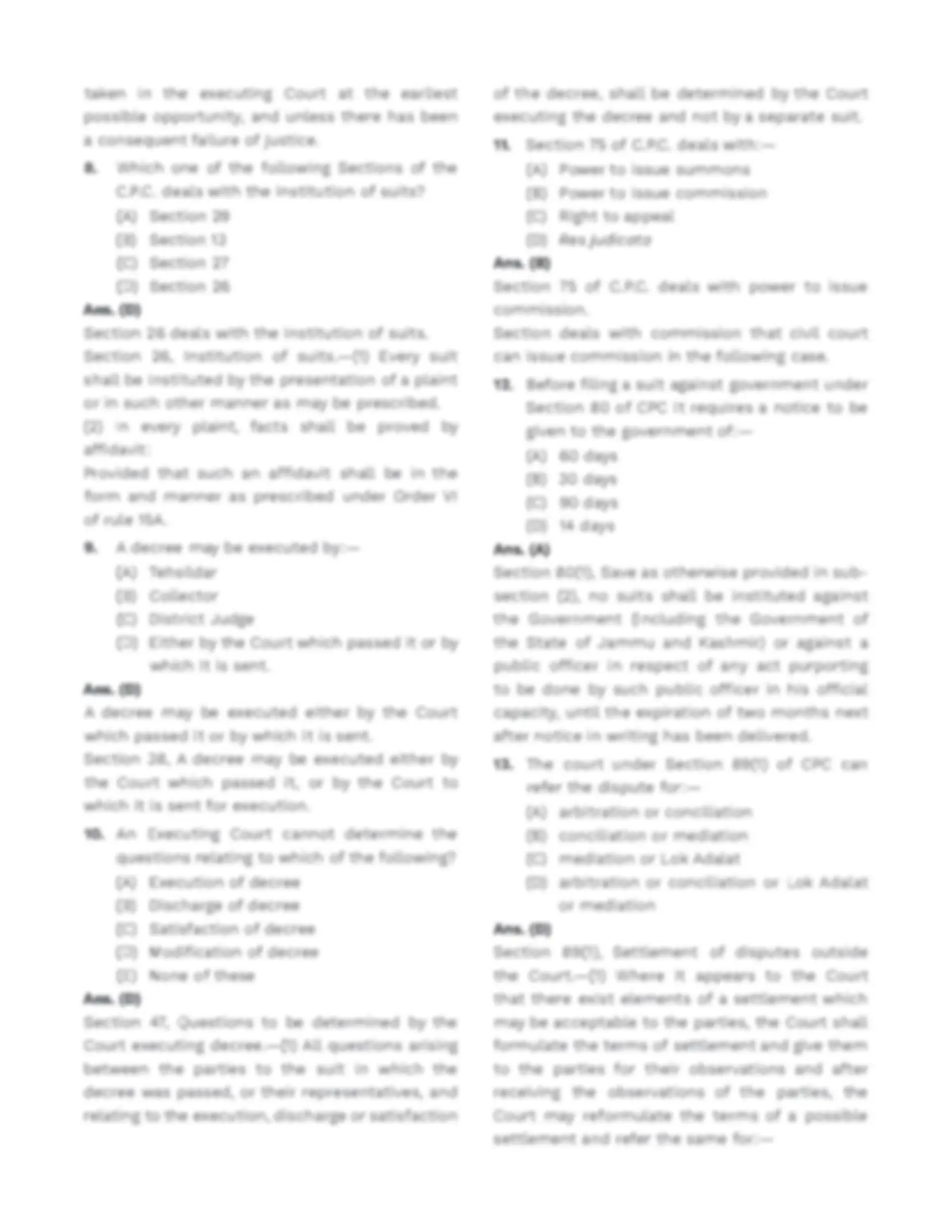
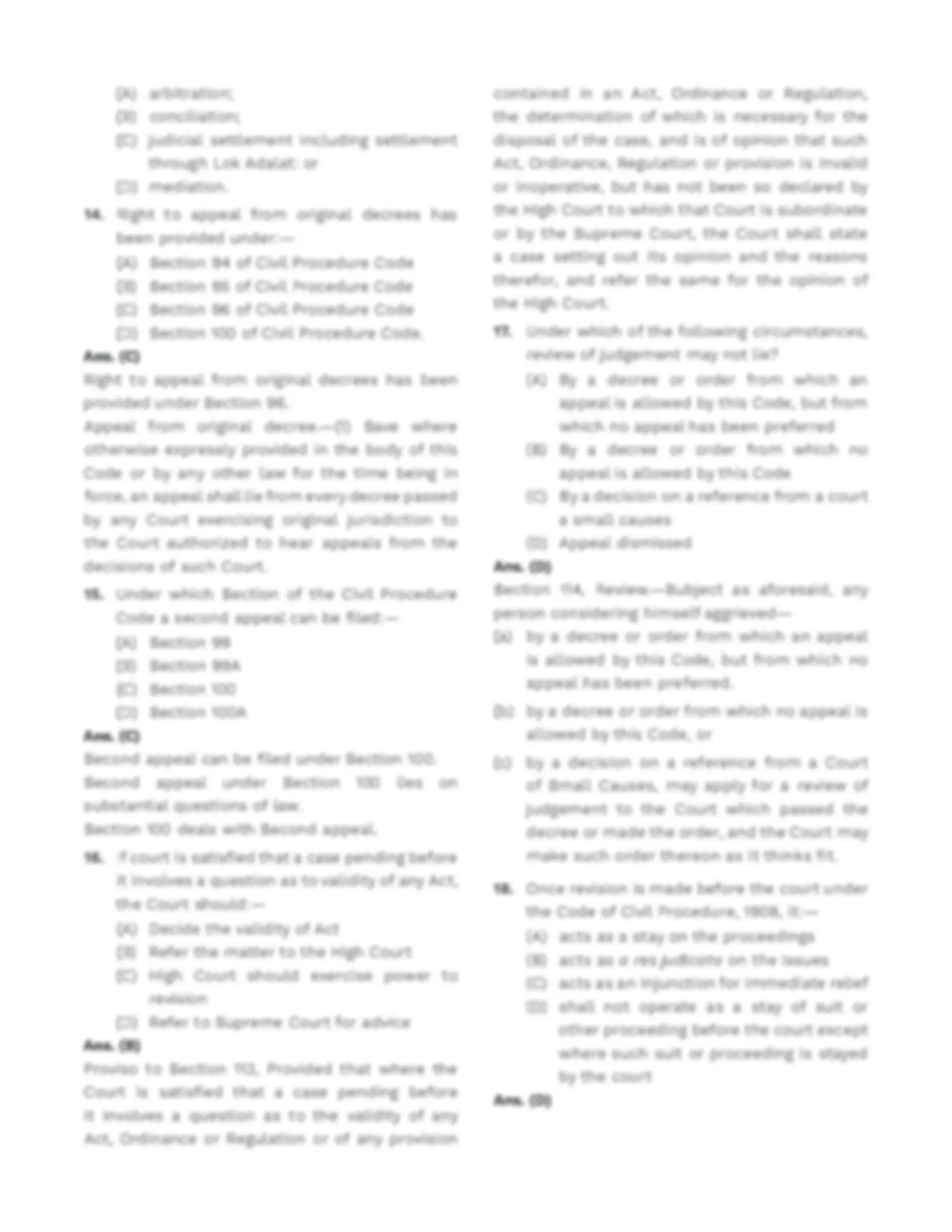
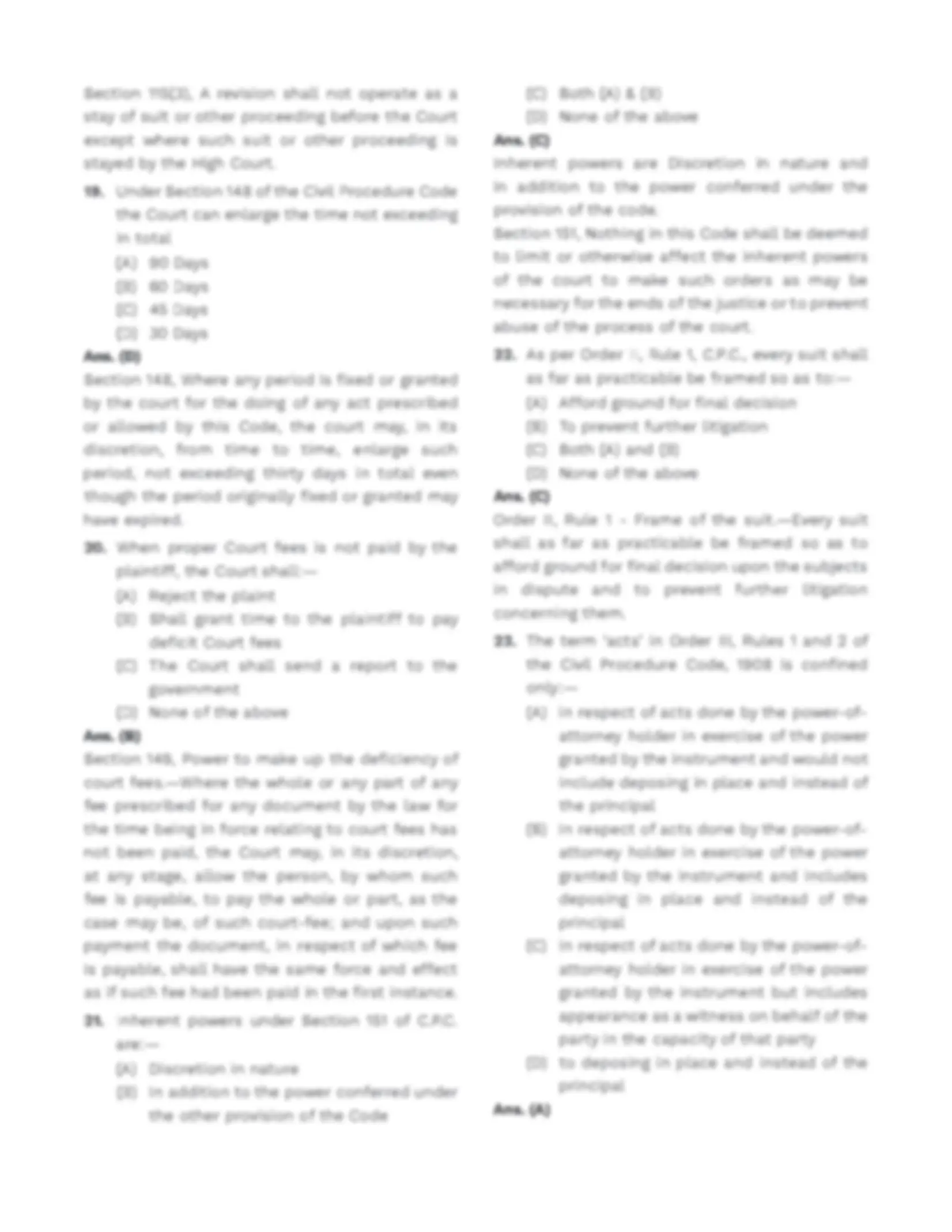
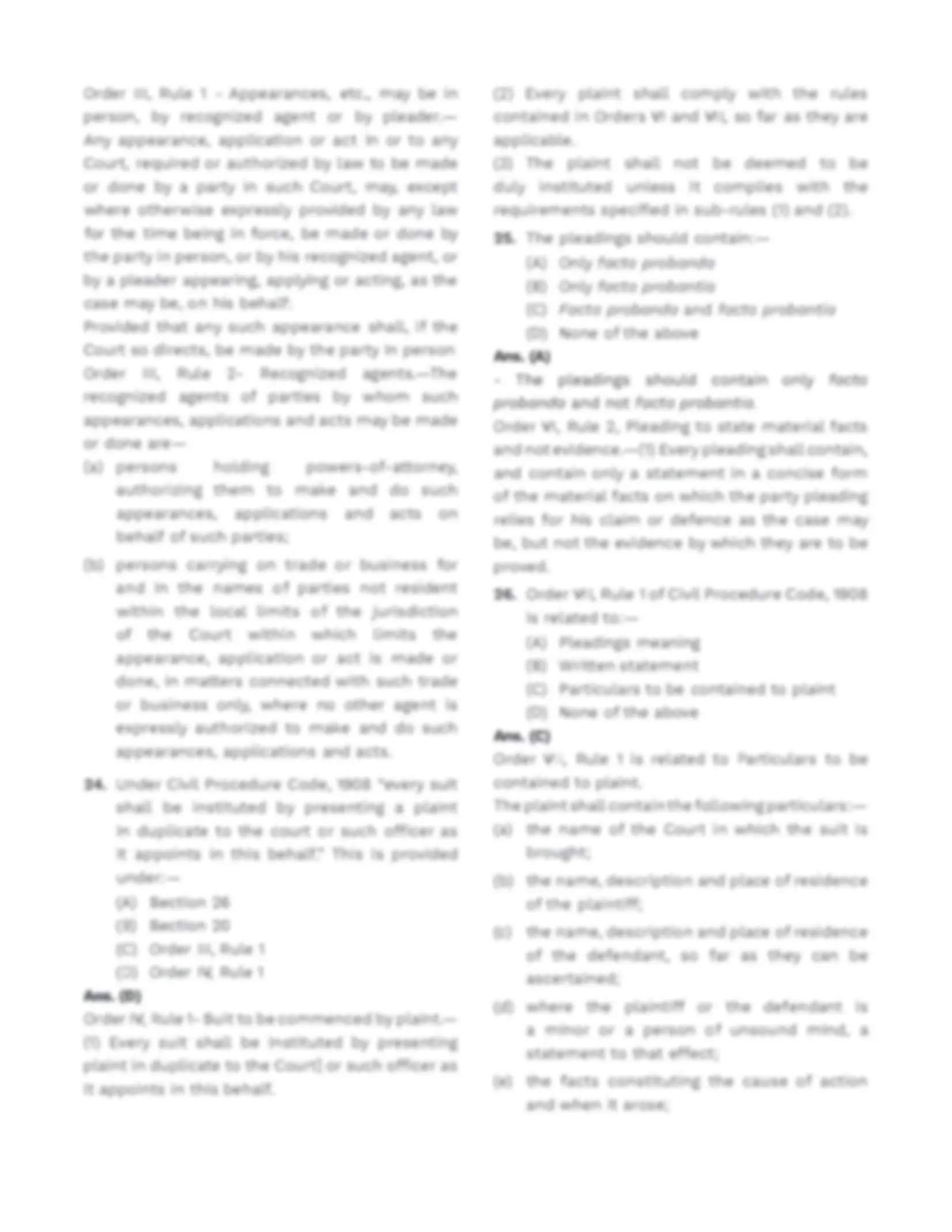


Study with the several resources on Docsity

Earn points by helping other students or get them with a premium plan


Prepare for your exams
Study with the several resources on Docsity

Earn points to download
Earn points by helping other students or get them with a premium plan
Community
Ask the community for help and clear up your study doubts
Discover the best universities in your country according to Docsity users
Free resources
Download our free guides on studying techniques, anxiety management strategies, and thesis advice from Docsity tutors
It is Code of Civil Procedure, which is a law regulating the procedure of Civil Courts in India. These notes covers topics such as jurisdiction, parties to a suit, pleadings, evidence, judgments, appeals, and execution of decrees. It also contain Question Bank with Answers with Relevant Case Laws at the end to refer
Typology: Study notes
1 / 137

This page cannot be seen from the preview
Don't miss anything!





























































































The Code of Civil Procedure, 1908 is an Act to consolidate and amend the laws relating to the procedure of the Courts of Civil Judicature. It is an adjective law. It does not take away the rights of any person. This Act is sub-divided into 158 Sections and a Schedule which contains 51 Orders and rules. Further, this Act was enacted to regulate every action of Civil Courts in India. In the absence of any specific provision to the contrary, nothing in this Code shall be deemed to limit or otherwise affect any special or local law now in force or any special jurisdiction or power conferred, or any special form of procedure prescribed, by or under any other law for the time in force. In particular and without prejudice to the generality of the proposition contained in sub-section (1) nothing in this Code shall be deemed to limit or otherwise affect any remedy which a landholder or landlord may have under any law for the time being in force for the recovery of rent of agricultural land from the produce of such land.
The Code of Civil Procedure, 1908 was passed by the Legislature and assent of Governor General of India was given on 21 March 1908. It shall come into force on 1 January 1909. In 1858, The Code on Civil Procedure was introduced, i.e., The Code of Civil Procedure, 1858. In 1877, The Code of Civil Procedure Code, 1877 was introduced which replaced the earlier Act of 1858. In 1882, The Code of Civil Procedure Code, 1882 was introduced. Further in 1908, The Code of Civil Procedure, 1908 was enacted to consolidate and amend the existing laws in India. The Act has been amended various times to fulfil the requirements of time and to meet the challenges of time.
The Code of Civil Procedure, 1908 was enacted to regulate the procedure to be followed by Civil Courts. The Code of Civil Procedure, 1908 extends to the whole of India. It extends to the whole of India except-(a) omitted, (b) the State of Nagaland and the tribal areas: Provided that the State Government concerned may, by notification in the Official Gazette, extend the provisions of this Code or any of them to the whole or part of the modifications as may be specified in the notification.
days of January, 1972 were included in the tribal areas of Assam as referred to in paragraph 20 of the Sixth Schedule to the Constitution. (4) In relation to the Amindivi Islands, and the East Godavari, West Godavari, and Visakhapatnam Agencies in the State of Andhra Pradesh and the Union territory of Lakshadweep, the application of this Code shall be without prejudice to the application of any rule or regulation for the time being in force in such Islands, Agencies or such Union territory, as the case may be, relating to the application of this Code.
deemed to limit or otherwise affect any special or local law now in force or any special jurisdiction or power conferred, or any special form of procedure prescribed, by or under any other law for the time in force.
Court.
defendant.
passed against a defendant in absentia.
having the same interest in the suit.
money.
from attachment in execution of a decree and the subject-matter of the suit) to enable him to pay the fee prescribed by law for the plaintiff in such a suit.
court, if the case involves a substantial question of law.
manage, that is, to protect and preserve a disputed property involved in a suit.
about to commit a breach of contract, or other injury of any kind.
The Code of Civil Procedure is a consolidated code of procedure to be followed by civil courts. It was
and amends the laws relating to the procedure of the courts of civil judicature. No doubt it also deals with certain substantive rights. But its essential object is to consolidate the law relating to civil procedure.
It extends to the whole of India, except the state of Nagaland and other Tribal Areas.
The code can be divided into two parts: (i) The body of the code containing 158 sections, and (ii) The First schedule, containing 51 orders, rules and forms. It is to be noted that the sections deal with the provisions of a substantive nature, laying down the general principles of jurisdiction while the first schedule relates to the procedure and the method, manner and mode in which the jurisdiction may be exercised.
rules must be read together and harmoniously constructed, but if the rules are inconsistent with the sections, the latter will prevail. The court considered the scheme of the code as a whole and observed that amendments made by High Courts in the Rules contained in the (First) Schedule, also became part of the code for all purposes "as if enacted is the Code".
procedure for the enforcement of rights, liabilities and obligations of the state as well as of citizens and makes the procedure simple, expeditious and inexpensive. It is a well-settled principle of interpretation of Statutes that procedural laws are always retrospective in nature unless there are good reasons to the contrary. Their provisions will apply to proceedings already commenced at the time of their enactment. The reason is that no one can have a vested right in forms of procedure. The code of civil procedure is not retrospective in the procedure.
The adjudication of a court of law may be divided into two classes: (a) Decree (b) Order. In order that a decision of the court may be a "decree", the following elements must be present (i) There must be an adjudication. (ii) Such adjudication must have been done in a suit. (iii) It must have determined the rights of the parties with regard to all or any of the matters in controversy in the suit, (iv) Such determination must be of conclusive nature, and (v) There must be a formal expression of such adjudication.
must be done by a court. Thus, an order passed by an officer who is not a court is not a decree. It
can be said that a decision on a matter of an administrative nature, or an order dismissing a suit for default of appearance, or dismissal of an appeal for want of prosecution is not a decree as there is no
Suit: The expression suit is not defined in the code. It means a civil proceeding which is instituted by filing a plaint in a civil court. A proceeding which does not commence with a plaint is not a suit.
noted that under certain enactments, specific provisions have been made to treat applications as suits, e.g., the Hindu Marriage Act, The Arbitration and Conciliation Act, The Guardian and Wards Act, etc. They are statutory suits and the decisions given there under are, therefore, decrees. Therefore, a proceeding which does not commence with a plaint and which is not treated as a suit under any Act, cannot be said to be a "suit" under the Code also, and the decision given therein cannot be said to be decree under Section 2(2) of the Code. Rights of the parties in controversy: The adjudication must have determined the rights of the parties with regard to all or any of the matters to be in controversy in the suit. The expression "rights of parties" means substantive rights and not merely procedural rights. It means rights of the parties
limitation, jurisdiction, frame of the suit, accounts, etc. which if decided must have a general effect on proceedings in the suit. Matter in controversy in the suit: It would cover any question relating to: (a) the character and the status of a party suing, (b) jurisdiction of court, (c) maintainability of suit, (d) other preliminary matter which necessitates adjudication before a suit is enquired into. However, interlocutory orders on matters of procedure which do not decide the substantive rights of the parties are not decrees. Similarly, it does not include proceedings preliminary to the institution of a suit. Conclusive Determination: In order to constitute a decree, the rights of parties with regard to any of the matters in controversy/dispute in the suit must be conclusively determined. A decision of a court in order to be a decree must be of conclusive nature, that is the decision must be one which is complete and final as regards the Court which passes it and not subject to terms and conditions. The decision of the court determining the rights of parties should be the final one in respect of any or all controversial issues. The decree may conclusively determine the rights of parties although it may not completely dispose of the suit. A decree becomes final in two ways: (a) where decree so far as regards court the passing it completely disposes of the suit. (b) where time to file an appeal has expired without filing appeal or the matter is decided by the highest court. Formal expression of Adjudication: A decree is essentially a formal expression of adjudication by the court. An adjudication must be expressed in a formal manner without formal expression, there can be no decree. An order is a formal expression of a decision of a civil court but it differs from a decree in the sense that a decree conclusively determines the rights of the parties with regard to all or any of the matters in controversy in a suit but an order does not.
Deemed Decree: An adjudication which though not fulfills the requirements of Section 2(2) cannot be decree, however by legal fiction certain orders are deemed to be decree. It is to be noted that certain orders passed or made in the execution proceeding under Order XXI are deemed to be "decrees" under the Code. These are.
(a) Adjudication of claims to, or objection to attachment of property (Order XXI, Rule 58);
(b) Adjudication of an application under Rule 98 or 100 of Order XXI.
1. Rejection of Plaintiff: In State of Rajasthan versus Rajpal Singh Chauhan, 2011 sec Online Raj 2709, it was held that Section 2(2) of the code specifically provides that a rejection of a plaint shall be deemed to be a decree. The rejection of a plaint must be one authorised by the code. If it is not under the code, the rejection will amount to a decree. It was further held that an order returning a plaint or a memorandum of appeal to be presented to the proper court is also not a decree. The reason is that such an order does not negate the right of a plaintiff or appellant and is not a decision on the rights of the parties. 2. Restitution: Determination of a question within Section 144. The definition of the term "Decree" stipulates that the determination of any question under Section 144 shall be deemed to be a decree. It provides that when the court determines any question on an application for restitution under Section 144, the same is deemed to be a decree. However, every order under Section 144 is not a decree. It is necessary that such orders must have decided the rights of parties with regards to the matters in controversy in proceedings under that section. 3. Judgement: Section 2(9) defines judgement. It means the statement given by a judge on the grounds of a decree or order.
(i) There should be a statement for the grounds of decision.
(ii) Every judgement other than that Court of a small cause should contain
(a) a concise statement of the case, (b) the points for determination, (c) the decision thereon, (d) the reasons for such a decision. Judgement contemplates the stage prior to passing of a decree or an order, and after the pronouncement of judgement the decree follows. Section 33 states that after the case has been heard, the court shall pronounce judgement, and on such a judgement a decree shall follow. After the judgement is pronounced, it is imperative that a decree must follow judgement.
filed and that the case is decided under Order 8, Rule 10, the Court has to write a judgement which must be in conformity with the provisions of the code or atleast set out the reasoning by which the controversy is resolved.
An order passed by an appellate court calling for a finding on an issue framed by it in an appeal is not a judgement, nor is a direction to pass a final decree after the deficit court- fees are paid, nor an order summarily dismissing an appeal or a revision. [V Gokul versus State of Gujarat, (1996) ILR Cri, 1189]
In Cellular Operators Association of India versus Union of India, Al R 2003 SC 899,it was held that before pronouncing judgement, the court has to apply its mind to arrive at the conclusion whether there is any cause to modify or remit the award. It was further held that the phrase "pronounce judgement" would itself indicate judicial determination by reasoned order for arriving at the conclusion that decree in terms of the award be passed. Furthermore, Order XX Rule 4(2) of the code in terms provides the "judgement" shall contain a concise statement of case, the points for determination the decision thereon, and the reasons for such decision. This is the antithesis to pronouncement of non-speaking orders.
Basic (i) Definition
(ii) Formal Expression
(iii) Stage
(iv) Finality
Judgement Decree Order Section 2(9)- It means Section 2(2)- It means Section 2(14)- It means a statement given by a judge on grounds of a decree or order.
expression of an adjudication which conclusively determines the parties with respect to all or any of the matters in controversy.
the formal expression of any decision of any decision of a civil court which is not a decree.
Statement is to be given by the judge
No statement needs to No statements need to be given by the judge in be given by the Judge only in the judgement and he records the reason for arriving at a particular conclusion in judgement.
the decree.
It is the declaration by Decree is an operative a judge of his intention part of the judgement. as to the final result of a suit based on reasoning.
It is always final. Decree may be party final or partly preliminary.
in order.
Order denotes the daily updates in the case.
Order is always final.
Section 2(6) defines foreign Judgement as "the judgement" of foreign courts." Thus, those judicial decisions which have been delivered by the courts of other countries are foreign judgements. The Supreme Court in Union of India versus Naveen Jindal, (2004) 2 sec 510, held that although the interpretation of the Constitution of India should be primarily based on materials available in India, relevant rules of other countries can be looked into for guidance.
Legal Representative denotes the classes of persons on whom the status of a representative is fastened by reason of the death of a person whose estate they are held to represent.
Thus, under Section 2(11), the following categories of persons can be allowed to represent the estate of the deceased person for the purpose of pending proceedings before the Court:- (a) who represents without title- Legal Representative includes a person who represents the estate of the deceased person even without title either as executor or administrator in possession of the estate of the deceased. The executors/administrators are legal representatives, though they have no beneficial interest and may not be the heir of the deceased.
Legal Representative includes any person, even a stranger who has no interest in the property and who is not a beneficial owner thereof but who intermeddles with the estate of the deceased i.e. who may be in actual possession of the deceased's estate without clearing any title for himself. (c) On whom the state devolves- A person in possession is a representative of the Estate. But a legal representative need not necessarily be in possession of any property of the deceased. Mere Right of possession of the estate of the deceased is sufficient. All that is necessary is that he should be the person on whom the estate would devolve on the death of the party suing or sued.
In Mohadei versus Kaliji Birajman, 1969 All LJ 896, the court observed that the Mesne Profits means those profits which a person in wrongful possession of such property either actually received or might have received with due diligence. It is not always necessary that there should be a proof of actual receipt. "Mesne Profits" of the property means those profits which the person in wrongful possession of such property actually received or might with ordinary due diligence have received therefrom, together with interest on such profits, but shall not include profits due to improvements made by the person in wrongful possession. In Kishen Kumar Narandas versus Purushottam Mathuradas, (2006)2 Civil Court Cases 600 (Born), it was opined that for entitling him to grant mesne profits, the plaintiff must lead evidence to prove what would be compensation the defendant might have received with due diligence for his wrongful possession. Where the plaintiff did not lead any evidence, it was held that he was not entitled to claim mesne profits.
Section 9 states that the court shall (subject to the provisions herein contained) have jurisdiction to try all suits of a civil nature except suit of which their cognizance is expressly or impliedly barred.
The jurisdiction of the courts to try all suits of civil nature is very expansive as is evident from bare
a right, there is a remedy). It is only where cognizance of a specified type of suit is barred by a statute either expressly or impliedly that the jurisdiction of civil court would be ousted to entertain such a suit. The general principle is that a statute excluding the jurisdiction of the civil court should be construed
competent civil court unless its cognizance is either expressly or impliedly barred by any Statute. It is to be noted that civil court being a court of plenary jurisdiction has the power to determine its jurisdiction upon considering averments made in the plaint but that does not mean that the plaintiff can circumvent provisions of the law in order to invest jurisdiction on a civil court which it may not otherwise possess.
or implied. An express bar is where a statute itself contains a provision that jurisdiction of civil court is barred, for example, the bar contained in Section 293 of the Income Tax Act, 1961. An implied bar may raise when a statute provides a special remedy to an aggrieved party like a right to appeal as contained in the Punjab Municipal Act which is the subject matter of the present case. Section 86 of the said Act restrains a party from challenging assessment and levy of tax in any manner other than as provided under the Act. A provision like this is the implied bar envisaged in Section 9 of the Code Civil Procedure, 1908 against filing a civil suit. It is to be noted that the question of jurisdiction is a pure question of law and needs to be adjudicated only on the basis of statutory provisions.
civil court does not have jurisdiction to decide matters which are required to be dealt with by the tribunal created under the statute.
the exclusion of jurisdiction of civil court have been laid down.
must be held to be excluded if there is adequate remedy to do what the civil court would normally do in a suit. Such provision, however, does not exclude those cases where the provisions of the particular Act would not have been complied with or the Statutory tribunal has not acted in conformity with the fundamental principle of judicial procedure. (2) Where there is an express bar of the jurisdiction of the court, an examination of the scheme of the particular Act to find the adequacy or the sufficiency of the remedies provided may be relevant but it is not decisive to sustain the jurisdiction of the civil court. Where there is no express exclusion the examination of remedies and the scheme of the particular act to find out the intendment becomes necessary and the result of the inquiry may be decisive. In the latter case, it is necessary to see if the statute creates a special right or a liability and provide for the determination of the right or liability and further lays down that all questions about the said right and liability shall be determined by the tribunals so constituted, and whether remedies normally associated with actions in civil courts are by the said statute or not.
or to enlarge jurisdiction is legislative in character, so also the power to confer or to take away a right of appeal. Parliament alone can do it by Law and no court, whether superior or inferior or both combined, can enlarge the jurisdiction of a court or divest a person of his rights of revision and appeal."
the lowest grade competent to try it."
Section 17 provides for:
(a) A choice to the plaintiff as to forum for instituting the suit,
(b) Section 17 is applicable where several properties are situated in different districts or the same property extends over several districts. It can be concluded that when there is one cause of action and the basis of plaintiff's claim is the same in all the claims against the various defendants, one joint suit in respect of all the immovable properties, whether situated within the jurisdiction of that court or within the jurisdiction different of courts can be taken cognizance of provided that part of the property lies within the territorial jurisdiction and the total claim is within its pecuniary jurisdiction.
Section 18 is attracted where the jurisdiction cannot be determined due to uncertainty. While invoking Section 18, the plaintiff shall have to convince the court about unsure jurisdiction. The court shall proceed to entertain and try a suit relating to the property of uncertain jurisdiction only when it is satisfied that there are reasonable grounds for such alleged uncertainty of jurisdiction.
(a) There must be an allegation as to uncertainty of the territorial jurisdiction of courts,
(b) The court must be satisfied that there is ground for the alleged uncertainty,
(c) The court must record a statement as to uncertain jurisdiction and thereupon proceed to entertain and dispose of any suit relating to such immovable property,
(d) The decree passed by such court shall be legal and valid and shall have the same effect as if the property was situated within the local limits of tis jurisdiction,
(e) Before entertain a suit, the court must satisfy itself whether it has pecuniary jurisdiction as to subject-matter, if it has, then only it should proceed further otherwise not, because this section only allows territorial jurisdiction and not pecuniary jurisdiction and in the absence of such the court is not competent to pass a decree on such a suit. [Proviso to Section 18(1)]
Where a statement as to uncertainty of jurisdiction is not recorded and a decree is passed and such decree is challenged on the ground that it was passed without jurisdiction then appellate or revisional Court shall not allow such objection unless:
(i) it appears that no reasonable uncertainty existed at that time of suit;
(ii) such objection is taken in the court the first instance; and
(iii) there has been a failure of justice in consequence thereof.